Vortex (1982) #1-15
edited by Bill Marks and others
Hi! Welcome to the blog series where I (re-)read all the comics Vortex has published.
I have mixed feelings about setting out on this er “venture”, because… some of the comics I’ve read so many times (as a teenager) (I’m speaking of Yummy Fur) that I’m paradoxically not sure if I want to revisit: Am I going to be disappointed upon a re-read? While others I’m really looking forward to re-reading, because I remember nothing about them, other than a general positive buzz.
The Vortex magazine is in the latter category. I remember being really taken with it, but I remember nothing about the particulars.
For instance, the opening spread is a very short Gene Day eulogy… which, in itself, is an odd choice. But you’d then expect they’d put at least a couple of pages of his artwork in the issue or something? But nope.
Instead most of the issue is just a single sci-fi story by Peter Hsu and Terry Hanover. Who apparently used a disco ball as the model for their space ship.
I vaguely remember Peter Hsu being Hot Shit at the time? But I don’t remember why…
Oh, right. He made violent porn comics.
Which reminds me! This was the one issue of this series I didn’t have as a teenager! Because I just couldn’t afford to buy it: As a back-issue it went for 20x the rest of the issues, I think? Could I be misremembering?
Hm, well, that’s not 10x… It’s expensive, though? On this other hand, this is Mile High Comics, and things are randomly expensive there…
Anyway! I didn’t get this until the 90s or something when I got gainfully (ahem) employed.
The prose is standard leaden comics sci-fi, but Hsu is playing most of it for laughs? I think? I mean, that pose (she’s been kidnapped and forced into a king’s harem) and facial expression aren’t the standard “here we go to get raped again!” Or it might just be Hsu being inept.
I’m going for “funny on purpose”. That expression is cribbed from a Mad movie parody, surely.
(That’s a big dick joke.)
The storytelling is a bit choppy and amateurish here and there in this story, and lots of the poses seem like they’ve been copied from porn magazines, but you can’t deny the rendering technique.
There’s ads in here! *gasp*
And then a four-page very hippie-ish Don Marshall story that seems like could have come out of any 70s sci-fi underground magazine. Cool artwork, though.
And then there’s a couple of pin-ups, and a subscription form: So Marks had aspirations for this book.
And then an back page ad from Seagate for those two comics they co-published with DC Comics. (1982 was a strange year.)
So… that’s an odd way to start an anthology series. By having one piece take almost all the space, it’s doesn’t really draw in readers, you’d think?
Vortex was founded by 20-year-old high school dropout William P. “Bill” Marks of Toronto in 1982, with its first title being an anthology comic of the same name. Marks recalled, “[Comic books] had a lot of potential for growth that I could see. I could see a revolution happening. By this time Cerebus was doing extremely well. Elfquest was a runaway success in the bookstores and on the best-seller lists. Eclipse was just starting up and shortly thereafter Pacific Comics started to get quite big.” Vortex received good distribution in both the U.S. and Canada, and the company proved to be a major force in Canadian comics publishing throughout the 1980s.
Early issues of Vortex were edited by Marks himself (who later described them as “quite primitive”) and received limited exposure.
OK, that sounds less like Marks had any artistic aspirations for the book, but looked at it as a business opportunity.
Now, I know what you’re thinking: IF YOU SPEND THIS MUCH TIME ON EVERY ISSUE, THIS BLOG POST IS NEVER GOING TO EEEEEND.
Don’t worry; I’m not. (I think.) But since this is the first issue Vortex ever published, it’s worth spending a little more time on.
Oy! That’s Mister X! Drawn by Paul Rivoche, for once. Mister X was famous throughout the first half of the 80s for never having a lot of advertising material out (a series of posters were printed), but the comic book itself didn’t launch until a couple years later (and from a different team than originally announced).
Vortex continued being mostly sci-fi oriented during the first half dozen issues. Here’s David Ross with a twist ending (SPOILERS!), and if there’s anything I’m more tired by than anything else in sci-fi anthology series, it’s twist endings. I guess some of the blame has to be left at the EC doorsteps, since they were so fabulously successful with the format back in the 50s, but it’s rather tiresome.
Joe Haidar does an interestingly first-person-viewpoint story, but there is, of course, a twist at the end.
In another bizarre editorial decision, we get the second part of a series begun in Andromeda magazine in 1978. So… I’m guessing Marks was just phoning people and asking them if they had anything lying in their cupboards or something? The serial Nick Poliwko (which continues in the third issue, and then stops) is pretty standard sci-fi juvenalia.
Pretty snazzy ad for Mister X, announced as coming in August 1983 by Dean Motter and Paul Rivoche. That didn’t happen, of course.
Book 1, part 1 of “The Magus”… thankfully that’s an exaggeration: We only get this one part in Vortex. It is, again by Poliwko, and it’s pretty amateurish.
But it does have some interesting graphic elements. Very 80s, very stylish, but otn really rendered well, is it?
Now, Ken Steacy knows his way around a pencil. (Or brush. Or whatever.) Here we learn the secret story behind the origin of the Fantastic Four: Stan Lee overheard some people talking in a cafe.
Not many people know that.
John & Anthony Van Bruggen do the funniest piece in Vortex until now…
… but the amateurish sci-fi keeps on coming. This is Phil Lewin & Paul McCusker.
Ronn Sutton (credited as “Ron”) illustrates an Oscar Wilde text in the least obvious way possible. On the other hand, that’s nice rendering…
And finally! Ty Templeton! Unfortunately, it’s not prime Templeton — the artwork hasn’t gotten its really incredibly attractive inhuman sheen yet, and the jokes are pretty weak.
We get James Waler/Paul McCusker; perhaps the nadir of the series. Pretty much unreadable.
So what’s all this then? How come I remember Vortex so fondly from when I was a teenager? The first five issues do have some charm, but they’re mostly amateur hour.
Ta da! Ken Steacy takes over as the editor with the sixth issue! And now we get to the bits that made me goggle with enthusiasm as a … fifteen-year-old? I think that’s about right.
For instance, we get a serial, continued in each issue, from Jeff Morgan, starring characters like Dean Modern and Paul Revox. So it’s all an in-joke of a series, poking bizarre fun of people doing comics for Vortex. (I don’t know who Rob Mackanmire and Tom Strobe are, though.) To me, as a teenager, this was just the height of wit and intrigue!
But the general level of storytelling goes way up. Here’s Michael T. Gilbert doing a somewhat amusing autobio story, for instance, so we’ve also dropped the sci-fi anthology concept.
That’s not to say that we’re in totally new waters — we get, for instance, this pretty dire piece by Dave Ross.
NO! IT CANNOT BE!
Don Marshall does a weird, but pleasingly rendered sci-fi thing.
Dan Day does an uplifting little sci-fi thing.
Hey! Still late, and still gorgeous.
Speaking of gorgeous! Jaime Hernandez does a couple of covers.
We get a loving rendition of Vortex publisher Bill Marks.
And finally we get an announcement about the shift in creators on Mister X.
Good lord! *choke* A little story by Gilbert Hernandez! I so adore his graphic style during this era: He dropped all the hatching and quirky futuristic design after a few years, for a more open and clean look, but the style here is just so appealing. The story’s fun, too.
Morgan drops in more characters in his serial: Ken Spacey, Bill Sparks and … Machine Rock? I don’t know who refers to.
Nooo! Not… a red leather tie!!!
Curiously, Steacy starts running a letters page, and… it’s all about how people hate the Bill Marks-edited issue. Hm. Well, perhaps that isn’t really that curious.
Hm… I think they’re slipping in the Mister X ad design dept…
Or perhaps not?
Well, that’s lovely.
Steacy brings us the news that sales are plummeting.
But also Trina Robbins! Coolsville. This looks like it was drawn for a magazine-sized publication, though, so it was probably not made specifically for Vortex…
I think Ronn Sutton must be the person with the most pages in Vortex, and… unfortunately, most of the stories are pretty dull. This is a Starbikers story? Didn’t Renegade publish a Starbikers series later? Well, OK, “series”. Just one issue.
Steve Leialoha does a short, very untypical (for him) little story.
*gasp* So political! Who made this, though? It’s uncredited…
So there’s few letters about the series, but plenty about Mister X, so Steacy runs a bunch of those instead.
Yay! More Templeton. He’s getting his mature style going here. Well, almost. Immature mature.
Pertinent question.
Hey, why are these snaps out of focus all of a sudden? Well, I’m not redoing them…
A delightfully incoherent Ty Templeton page.
Gene and Dan Day do a depressing take on nursery rhymes…
Dean Motter actually draws something himself!
Jeffrey Morgan grew tired of the lightly coded Vortex artist shenanigans, and killed them all off, and introduced a new character: Johnny Slaughter! (He’s the one that killed them all.)
I can totally see why I’d adore all of this as a fifteen-year-old: I’m still really taken by it. Vortex (under Steacy) had a kind of wild, punk, “who knows what’ll happen” kinda vibe going. Sure, about half the contents were… what’s the word… “bad”… Yeah, that’s the word. But the other half was is surprising and sometimes delightful.
And then… with issue eleven, Templeton takes over as the editor. He announces changes: They’re getting a new serial by Klaus Schoenefeld. (Dunn dunn. Explanation to follow in a later blog post.)
Good lord! *choke* A comic by Jaime Hernandez! With Cheetah Torpeda! I’m jumping up and down on the couch here!
It’s in Jaime’s early scratchy style (well, scratchy for him), and it’s a really cute, melancholic little thing.
The rest of the issue, though… This thing is illustrated intriguingly by Fabio Gasbarri, but the story by Mike Regan has… you guessed it… a dreary twist at the end.
This is the Tom Nesbitt story that allegedly resulted in Templeton being made editor, and it’s a twist ending, and you can pretty much guess what it’s going to be based on the page above. Yes, there’s a reason his face is covered. Whodathunk!
So that’s not an auspicious start to Templeton’s editorship. OK, any issue with Jaime Hernandez is automatically better than anything else, but the rest is back on the level of the first issues.
But then! A year passed, and Lou Stathis is now the editor. I think Vortex basically was cancelled, but then the black and white explosion happened, which meant that it was, once again, profitable to publish something like Vortex again. So here we are.
The issue is a hodge-podge of stuff. Here’s Gary Wray with a story about monsters that eat planets.
A gag by James Riedal — can you guess what the punchline is on the next page? Yes you can.
This Bert Blood page is pretty fascinating, though. (But looks like it was made for some other magazine originally.)
Sam Kieth does a beautifully rendered (and somewhat scary) little horror story.
Fumetti!
Matt Howarth gets in a two-pager, which isn’t surprising, since Stathis and Howarth were friends, I think? It’s fun, but not very substantial.
And that’s the final Jeffrey Morgan page.
Because next issue (you guessed it), there’s a new editor: Deborah Marks. She seems to actually have a vision for the book: Featuring local, young artists.
So we get Maurice Vellekoop in this story about a struggling artist. He hasn’t yet developed the style he’d later use… but it’s still very appealing.
We get a more new wave sort of feel. It’s fun.
Fiona Smyth’s artwork is stunning and totally something else. (Her Nocturnal Emissions would be the final thing Vortex would publish (in 1994), and was recently released in a collected edition. I think this piece was included in that collection?)
But it’s not all greatness: There’s this run-of-the-mill sci-fi thing by… uhm… I’m not sure.
Then the next issue… has… a new editor. Well, actually, it’s the original editor: Bill Marks is back again, and writes his very first editorial. Note the “illustrations NOT by Dave Sim and Gerhard”: I think Sim had recently done a parody of Marks (and Seth) in Cerebus? That’s probably a reference to that, and I’ll be returning to the Cerebus pages when we get to Seth in this blog series.
Speaking of Seth: There’s two two-pagers from him in this issue. First we have a delightful one where he goes on a date with Le Corbusier and Madonna.

And then… YES THAT”S SETH! It’s the least Seth-ey thing I’ve seen. Did he do it while at art school or something? It’s pretty amusing, anyway.
Terry Laban does a somewhat non-charming bit about body image.
Mitch Manzer is normally reliably hilarious, but this is just… sorta funny?
Finally! The last issue! And Marks is still editor! And as is traditional in a final issue, he writes “there’s going to be even more great stuff in Vortex next year”.
The final issue has the feeling of leftovers, though. Richard G. Taylor does the most substantial piece.
Gary Fields does a couple of pages of this stuff.
And that’s it. Geeze, this took a long time to type, but anthologies are more work, I guess, even if there’s not much to say about each individual piece.
So… was it fun re-reading these Vortex issues? Yup, indeed. The Steacy run was what made me a fan, but the Deborah Marks-commissioned two issues are pretty wild and fun.
Amazing Heroes Preview Special #5, page 125:
VORTEX
Written and illustrated by VARIOUS; edited by LOU
STATHIS
32 pages; $1.75; quarterly from VORTEX COMICS
Vortex will continue to utilize the editing
talents of former Heavy Metal editor Lou
Stathis to the fullest in bringing out this
off-beat magazine. Bizarre science-fiction
and unusual new wave material will
continue to be the mainstays of Vortex’s
anthology format Publisher Bill Marks
says that Vortex will feature stories from
some commercial artists who rarely
venture into comics: “We’re talking artists
who are more at home in the high-quality,
glossy-paper world of magazines like New
brker. These are guys who wouldn’t
normally do comics.” Another new feature
will be interviews with some of the people
whose work appears in the book. “Again,
this isn’t quite the usual situation,” says
Marks. “The interviews will always coin-
cide with the artist’s contribution, so it will
be completely current with the story
published.
Well, that didn’t happen.
Amazing Heroes #145, page 249:
VORTEX
Witten by VARIOUS; edited by LOU
32 black-and-white pages; $1.75; distributed when
they’re happy with it by VORTEX COMICS
Since beginning his stint at Vortex.
former Heavy Metal editor Lou Stathis
has brought a very high standard to the
pages of Vodex (which was a pretty gocxi
book before he arrived).
As usual, the bizarre and off-beat will
continue to permeate the pages of this
exceedingly warped anthology book.
Also as usual, this book will continue
to feature work from the most imagi-
native and creative talents in and out of
the comics industry.
The book will maintain its new wave
slant and will also feature strange s-f and
fantasy. Black humor will also remain a
mainstay.
In other words, they have no idea when
the next issue is coming out or what’s
going to be in it.
Indeed.
Thom Heinthes (I think?) writes in The Comics Journal #101, page 20:
Rivoche said he considered
suing Marks. but declined to do
so. knew I’d end up wasting a
few years. and probably not even
get all the money back.” he said.
Finally, after a few months. he
and Marks settled privately.
leaving Rivoche content, but
determined not to work for Vortex
in the future. “I’ve just chalked it
up to experience,” he said. “I’m
uninvolved. and that’s where it
stands.”
Marks also owed Ken Steacy
about Sl.200 for editorial fees for
the first issue of Mister X, and
the first few issues of Vörtex. At
one point. according to Steacy. he
and Rivoche got together and
consulted with a lawyer. thinking
that the courts were their only
recourse to getting their money.
However, Steacy said he avoided
a lawsuit when Marks paid the
$1.200.
“I don’t think Bill tried to
screw me. I just think he had real
financial problems.” Steacy said.
“Much of the industry suffers
from extreme cash-now problems.
but Bill’s problems were more
severe.
‘ As editor of K»rrex. I was
happy. but I’m not an editor as
hobby.” Steacy said. “Being a
professional. I have to be treated
as such—I couldn’t donate my
time. I’m not a fanhoy any more.”
Marks also took six montlfi to
pay Trina Robbins and Steve
Leialoha for work they did for
Vortex. According to Robbins.
Marks paid them six months after
publication. but he added interest
for the time he was delinquent.
However. since Robbins and
Leialoha were paid in Canadian
dollars (Vortex is located in
Toronto. Canada). the value of
the money was not as great as it
would have been. had they been
paid in American dollars. “He’s
really not such a bad guy—he’s
just not a great guy.” Robbins
said.
I’ve googled a bit for reviews of this series, but it’s not easy. “Vortex” is a term used by many different things, so… I haven’t found anything. Perhaps it’s never been reviewed by anybody? Seems unlikely.
This blog post is part of the Into the Vortex series.
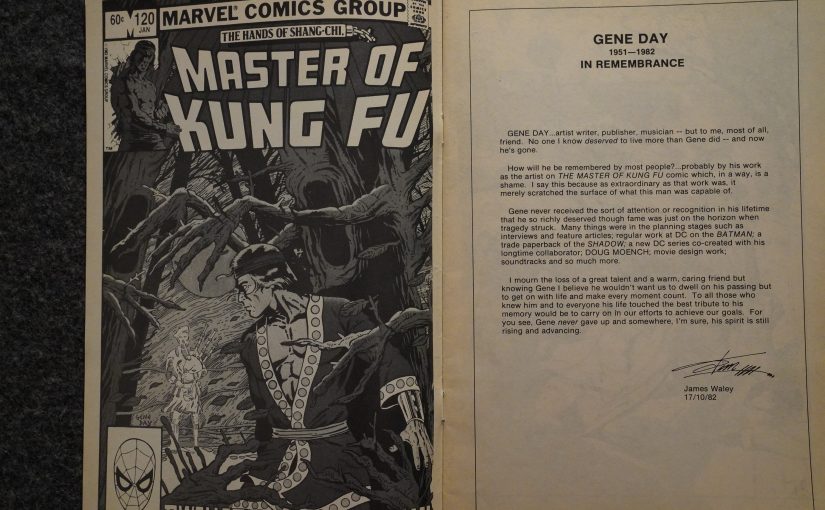
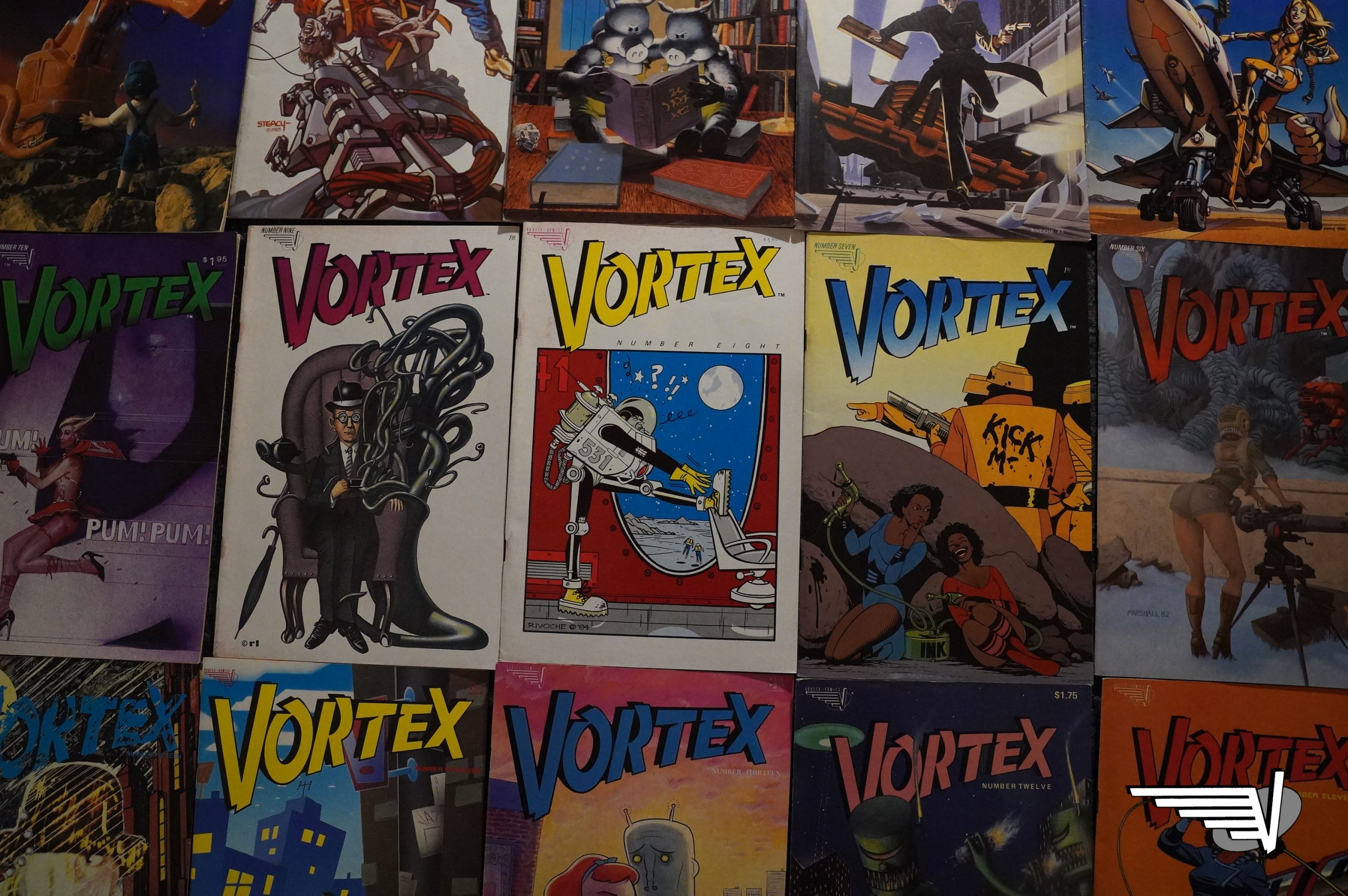

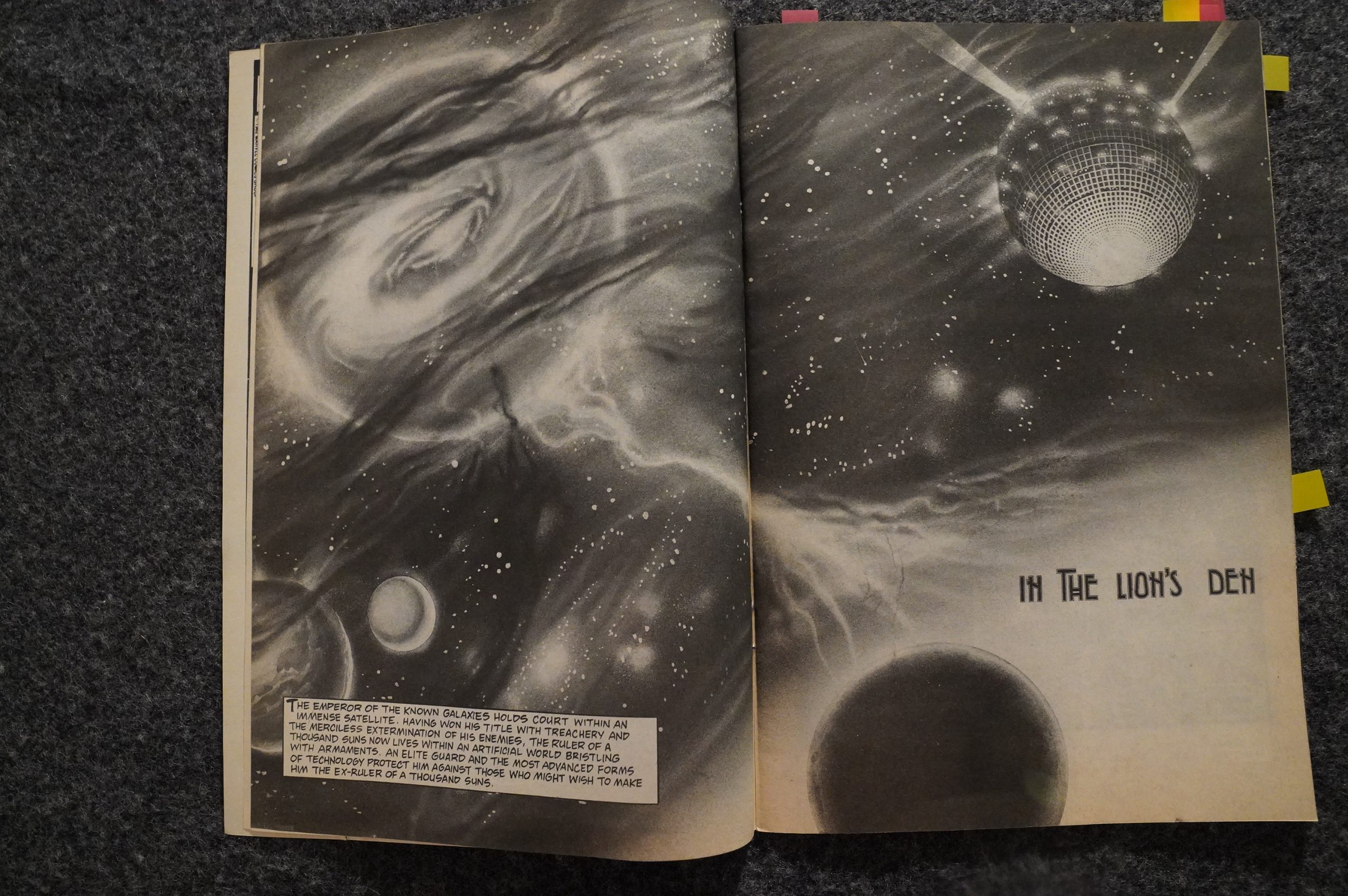
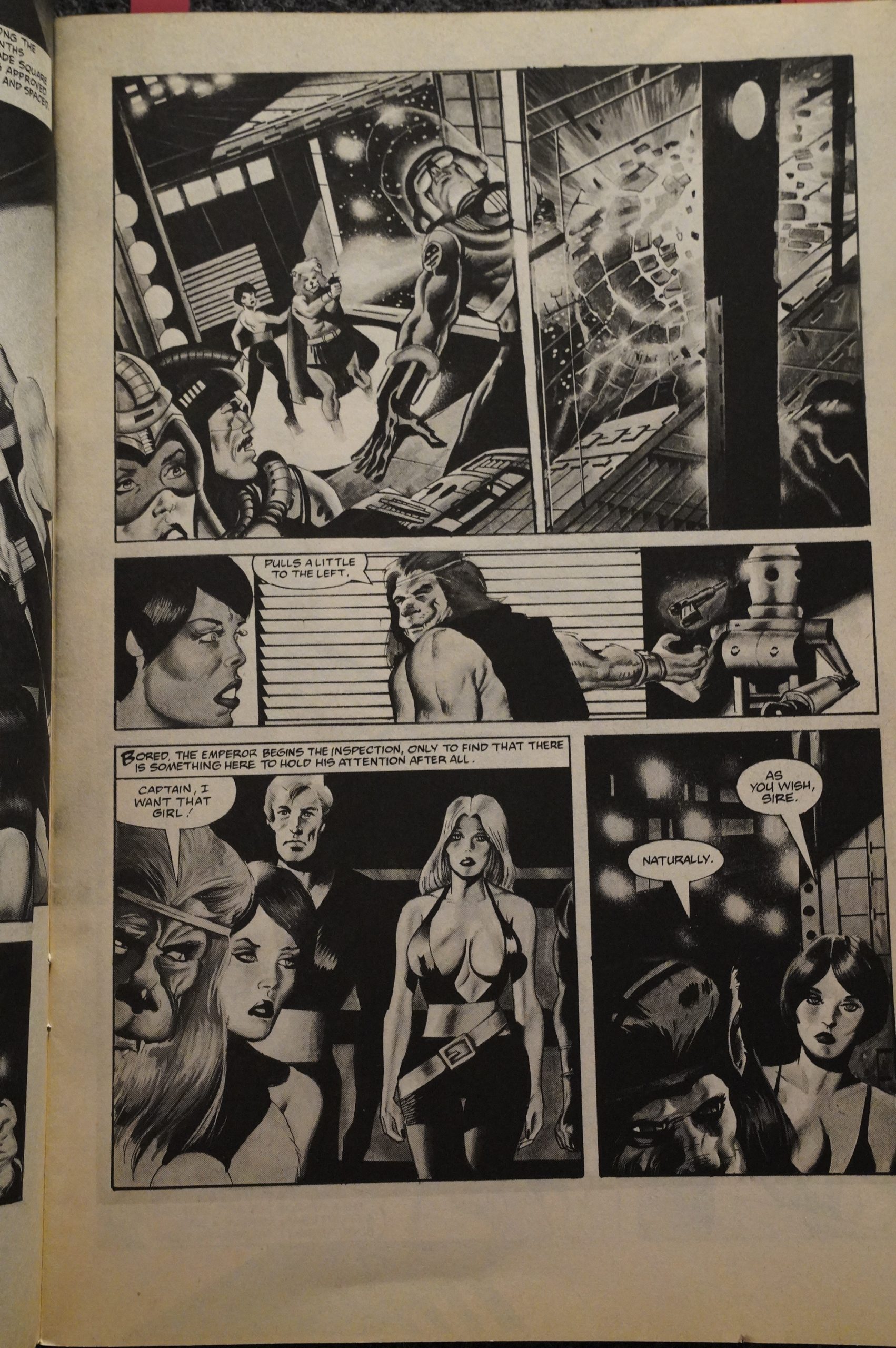
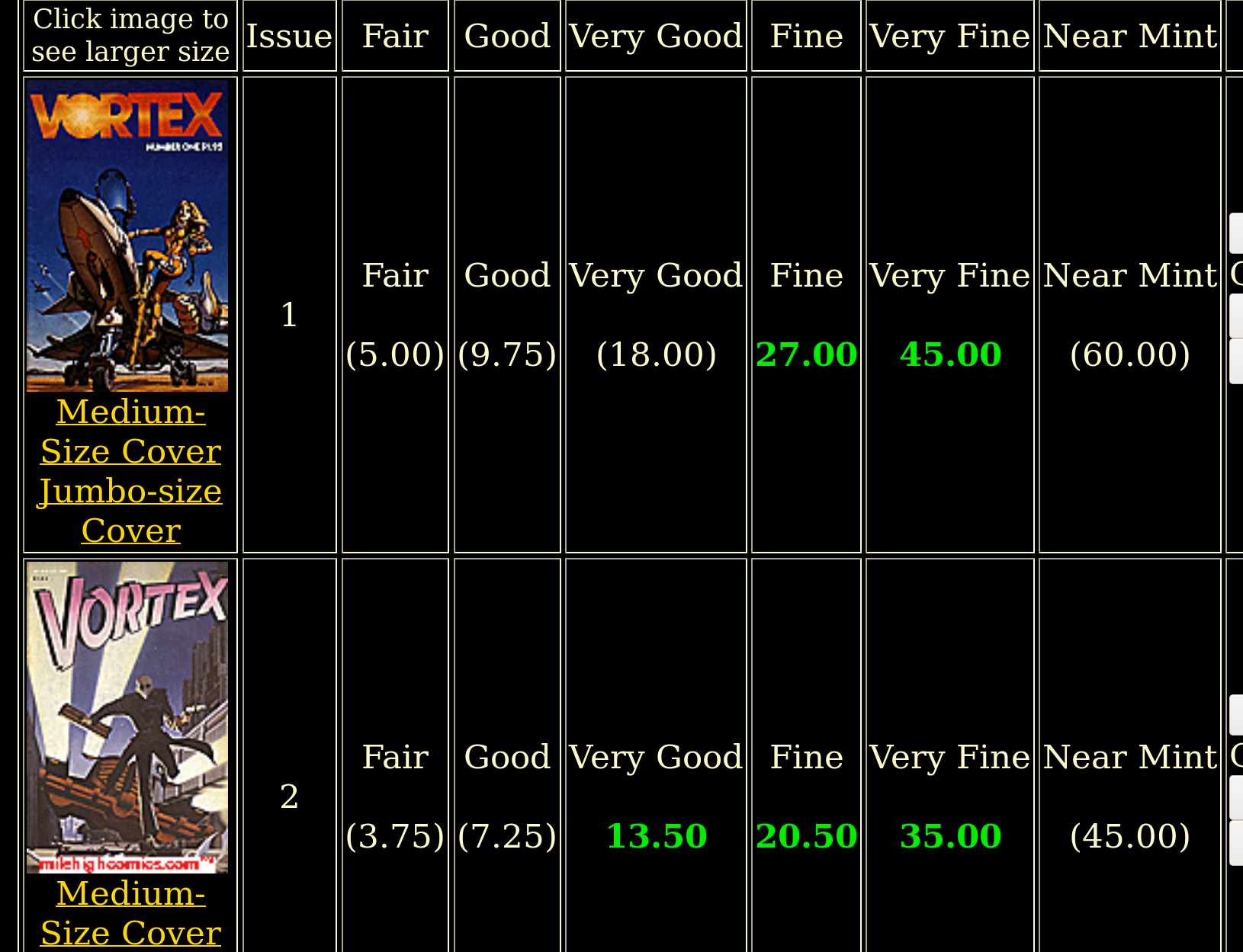
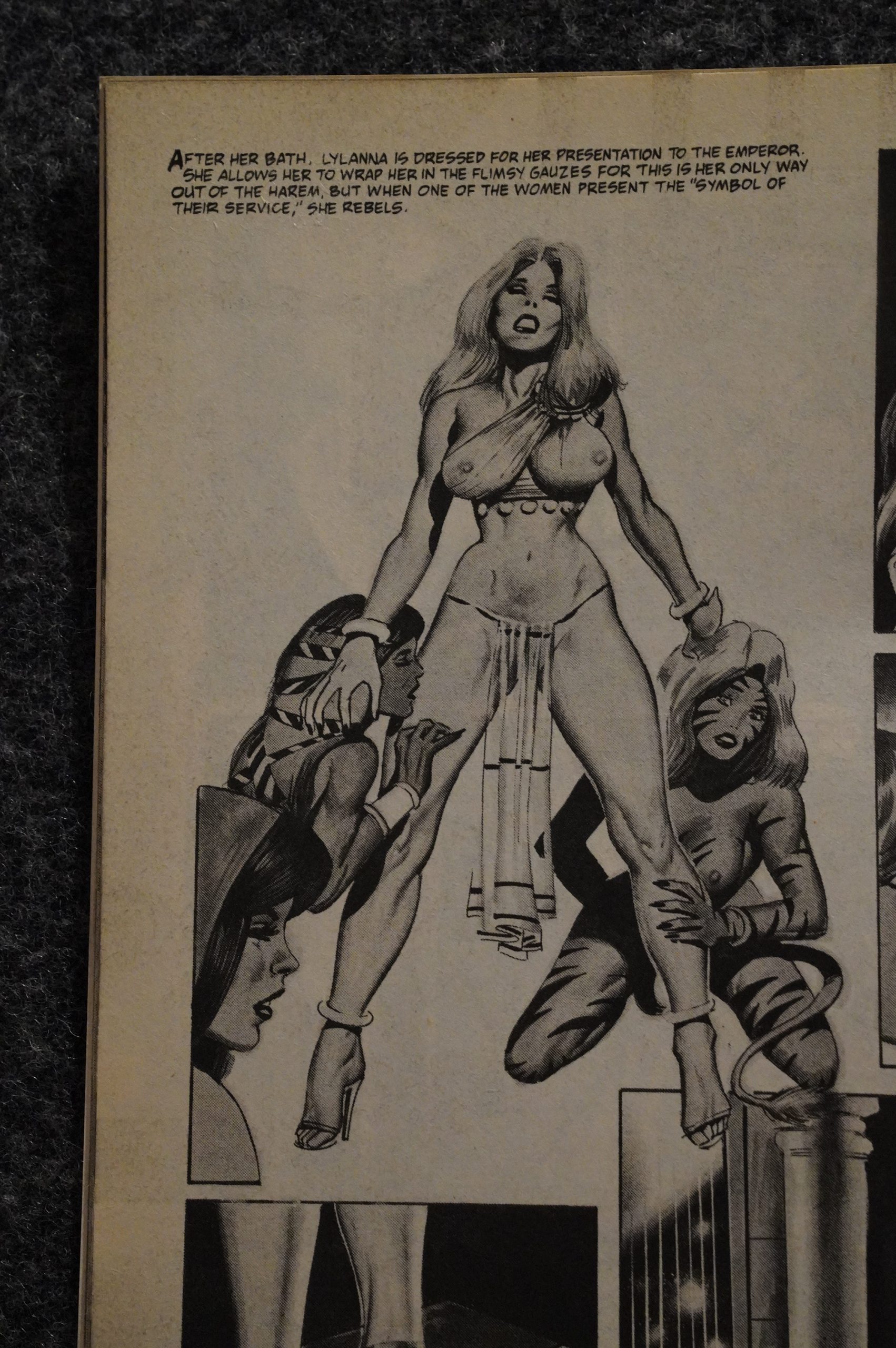
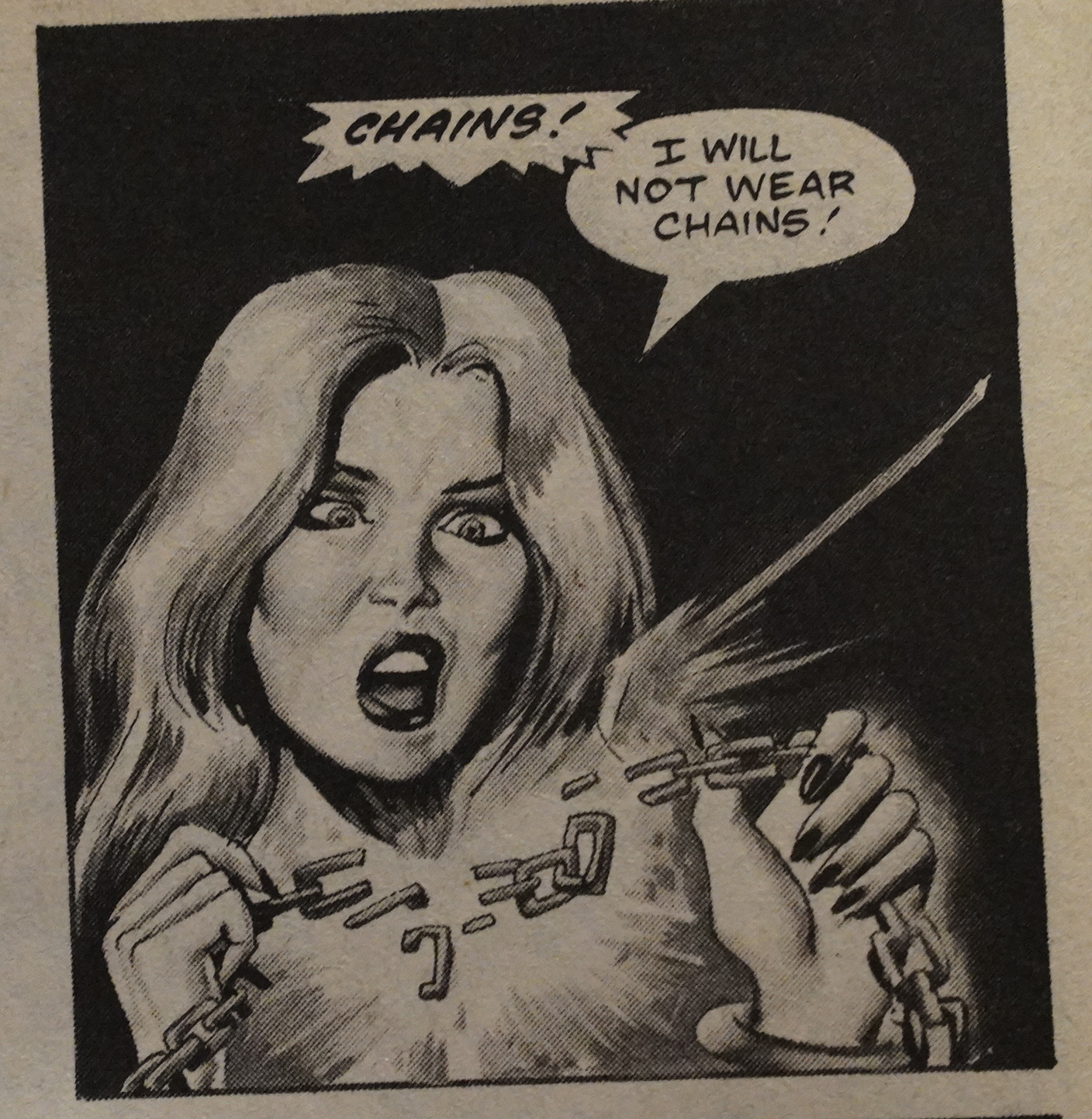
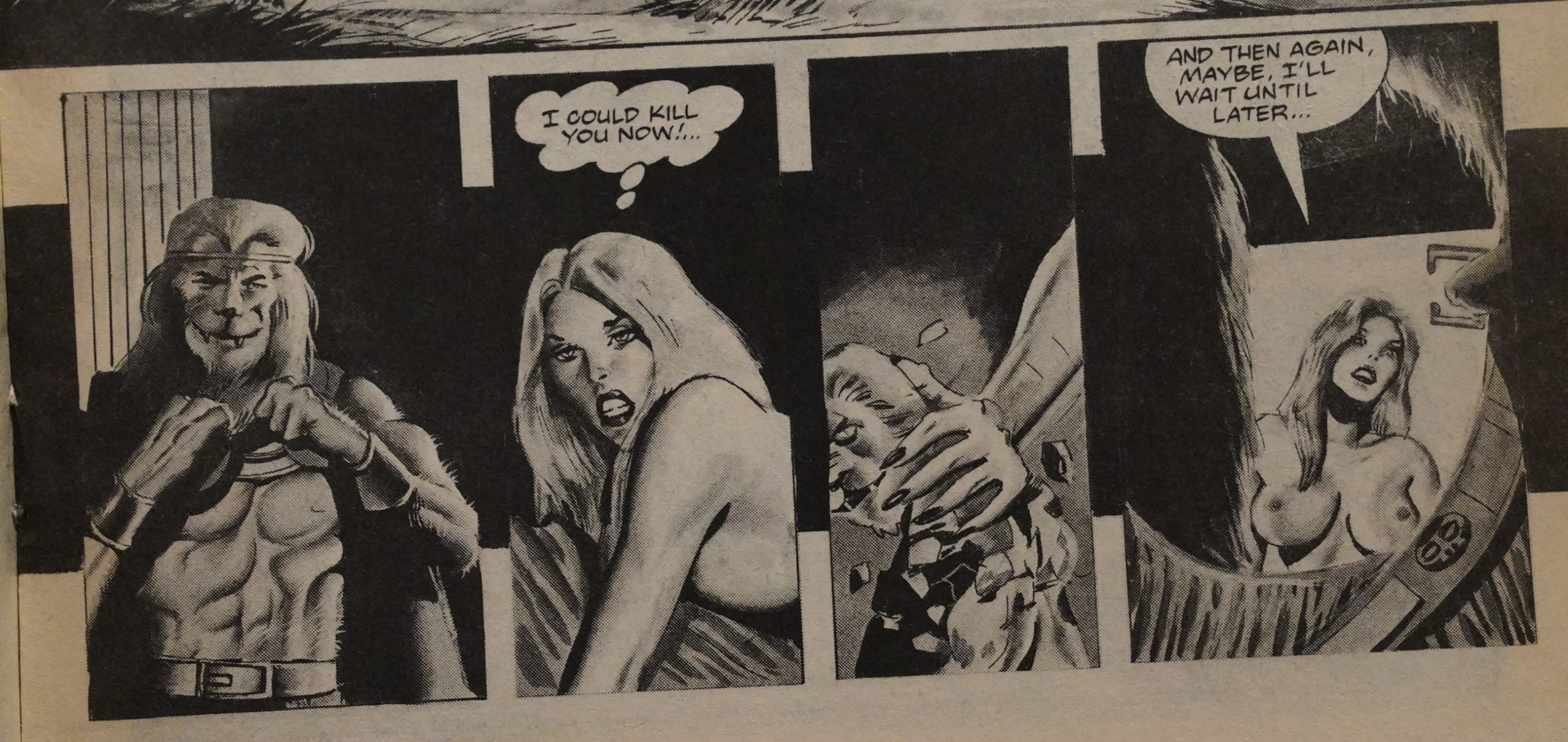
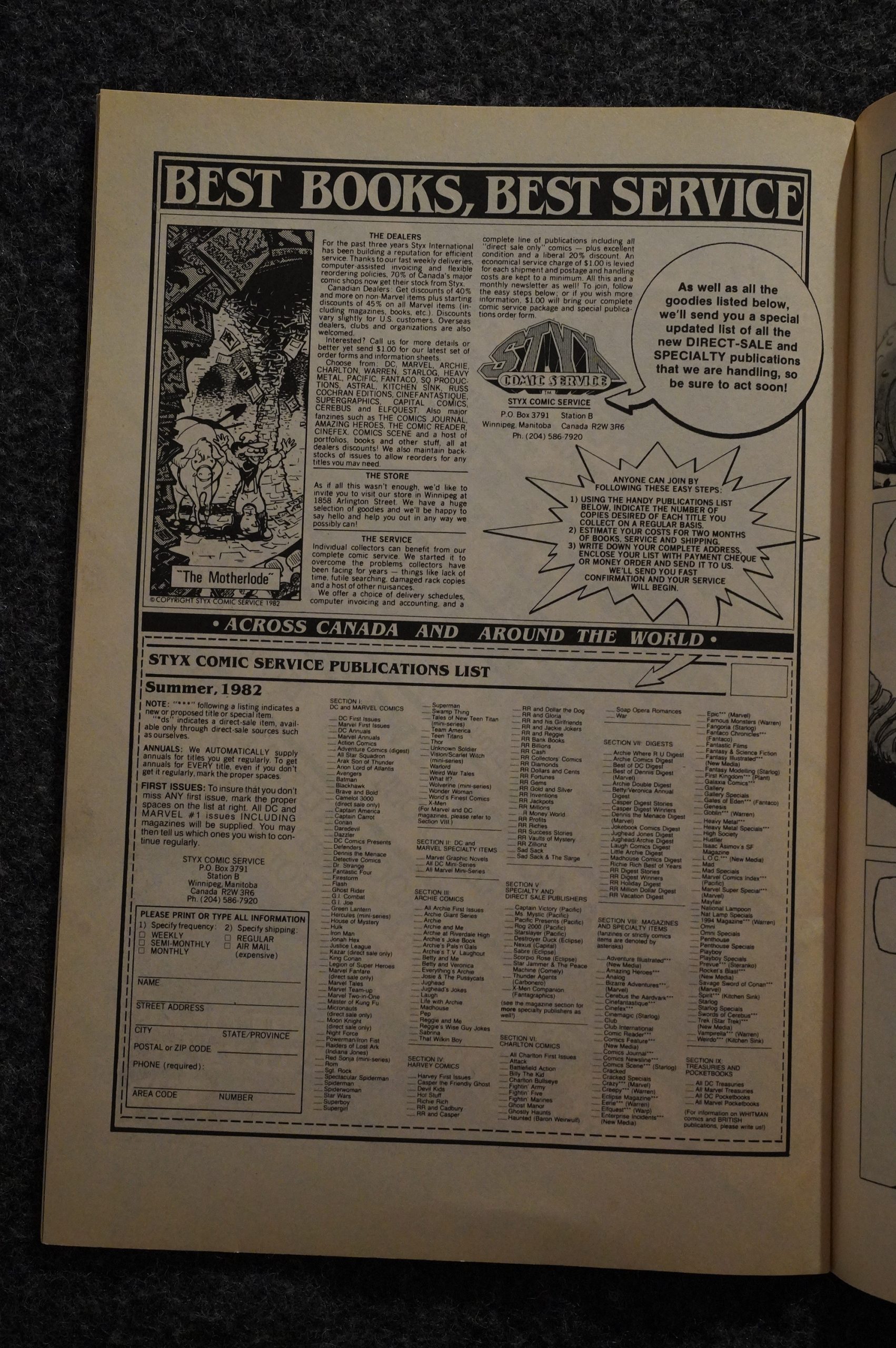
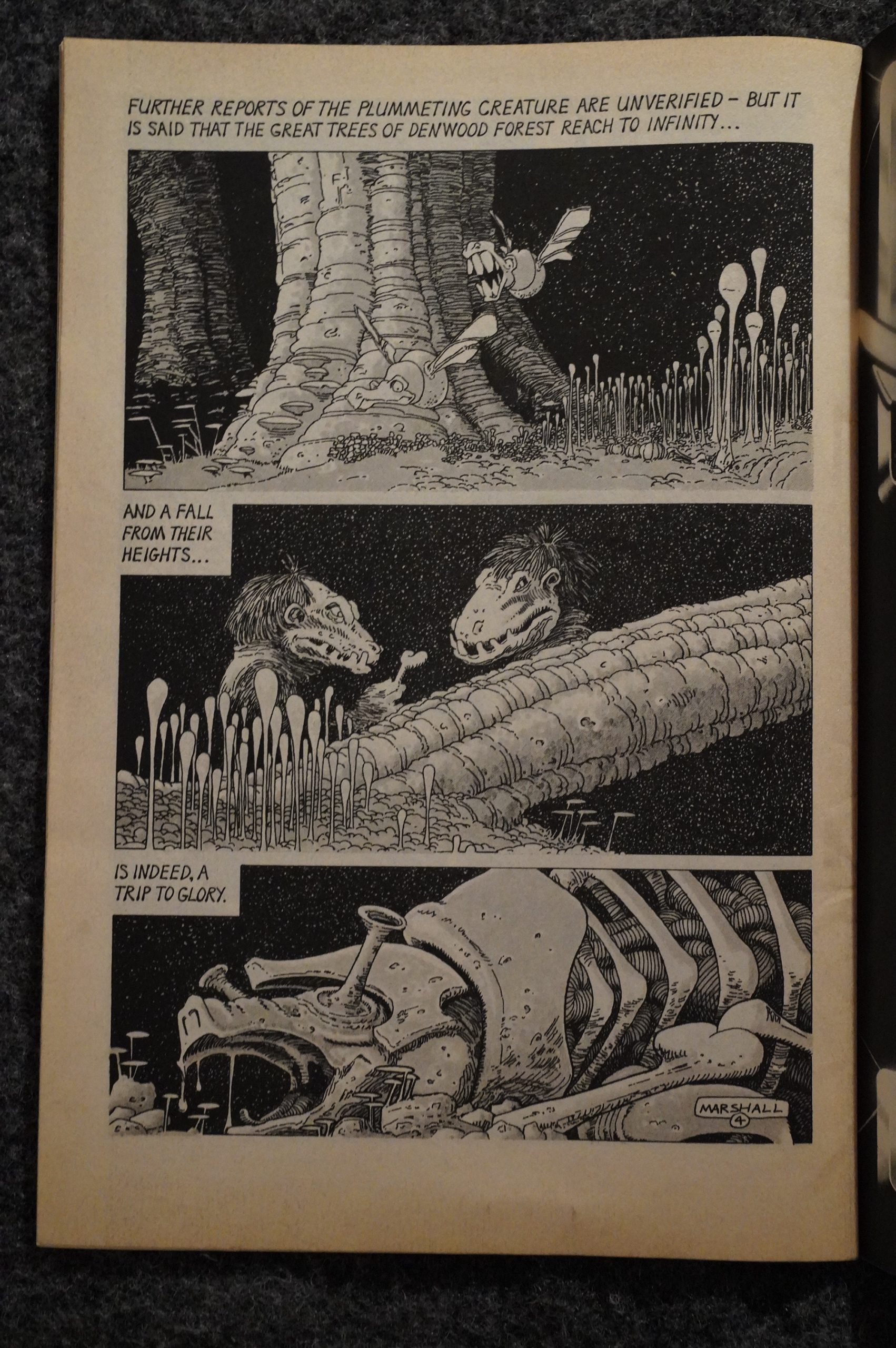

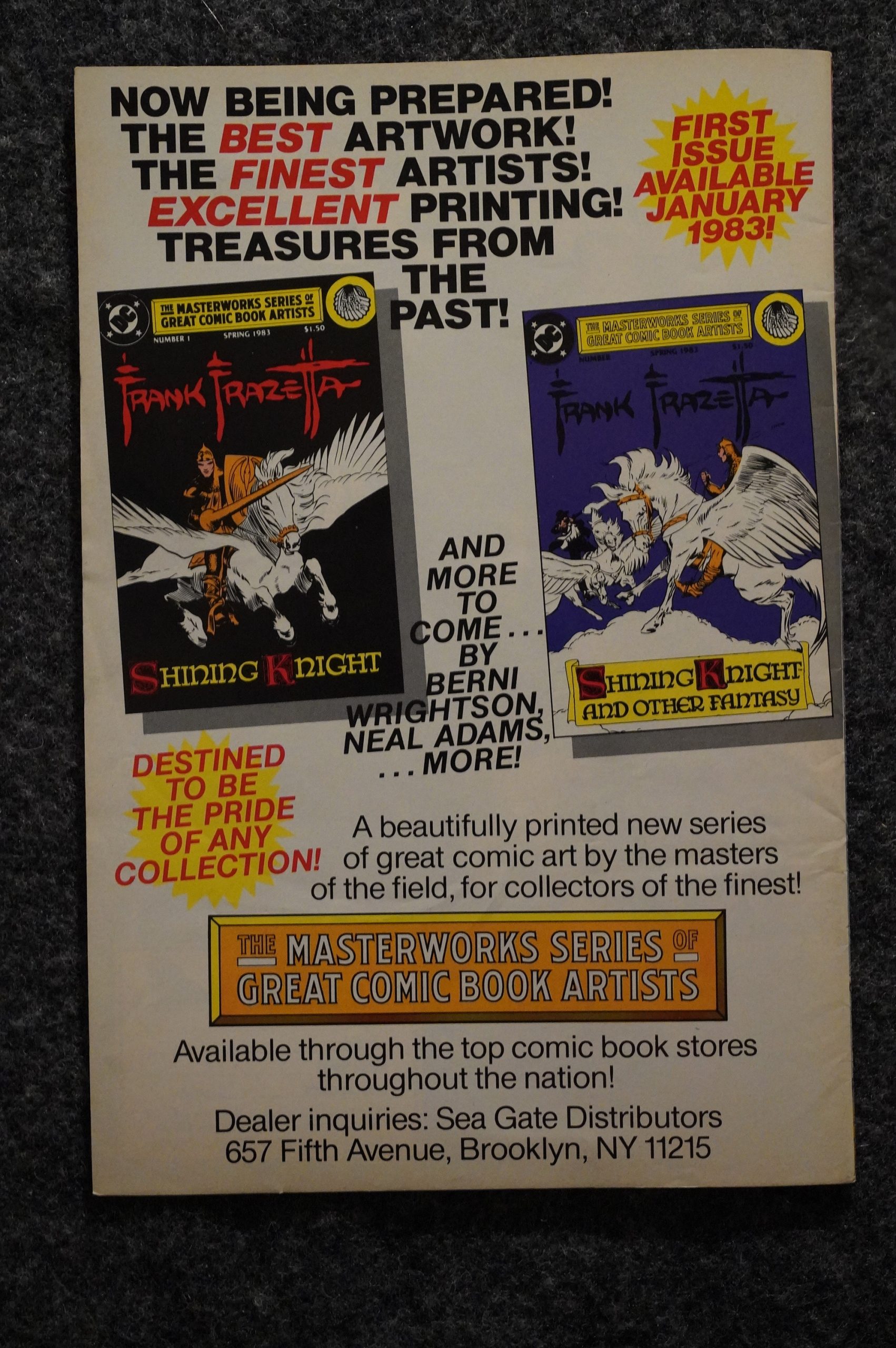
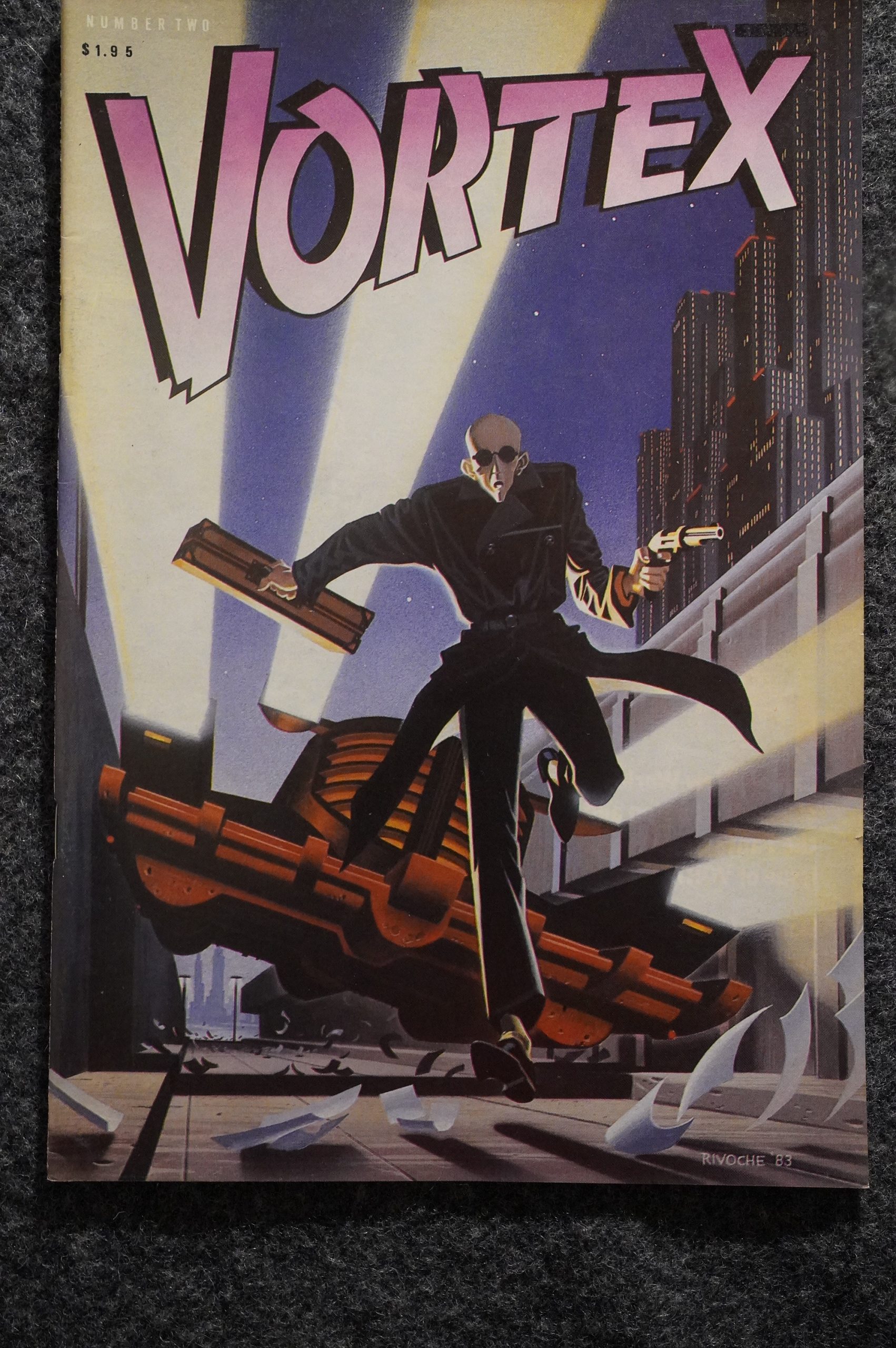
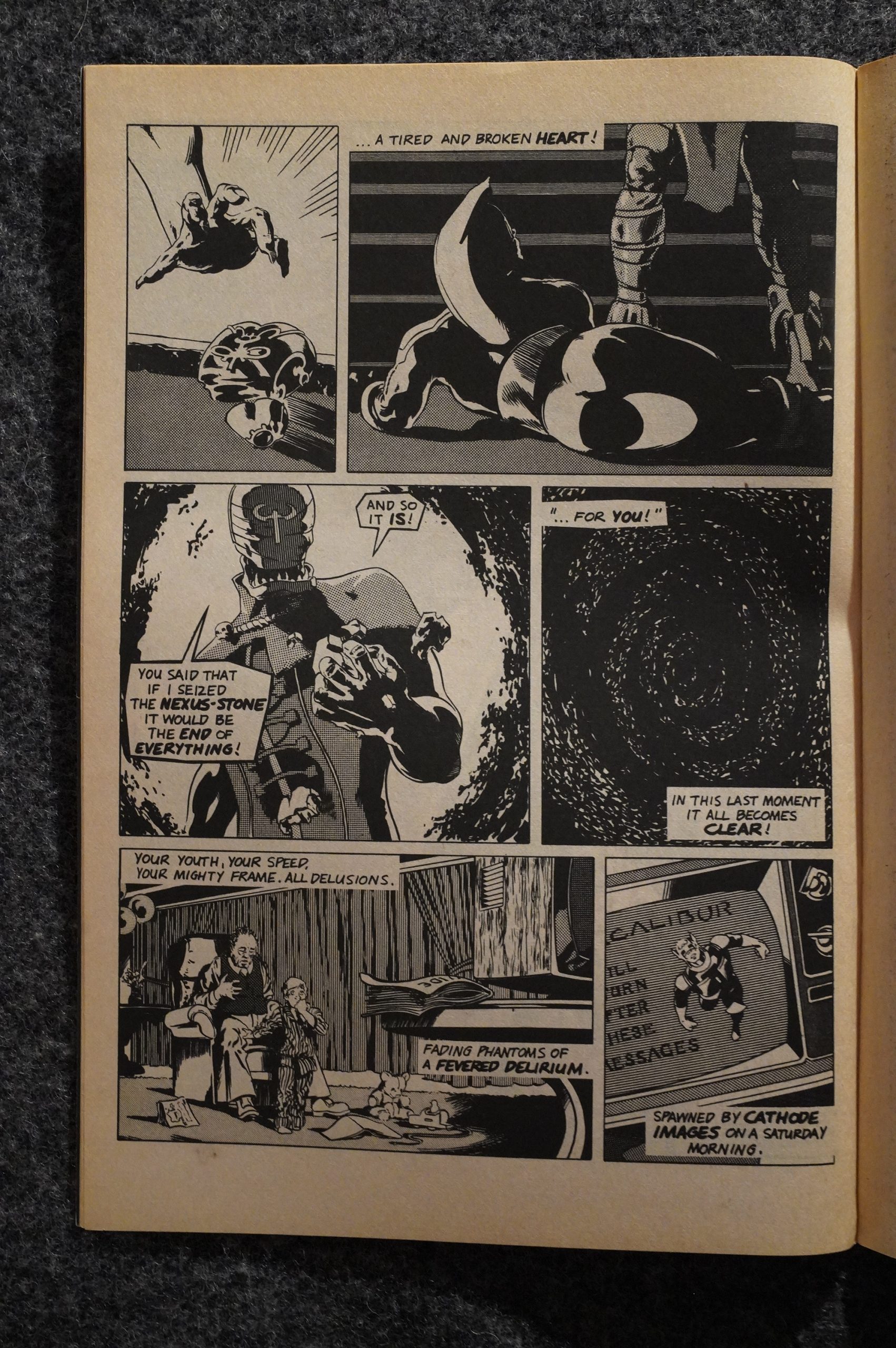
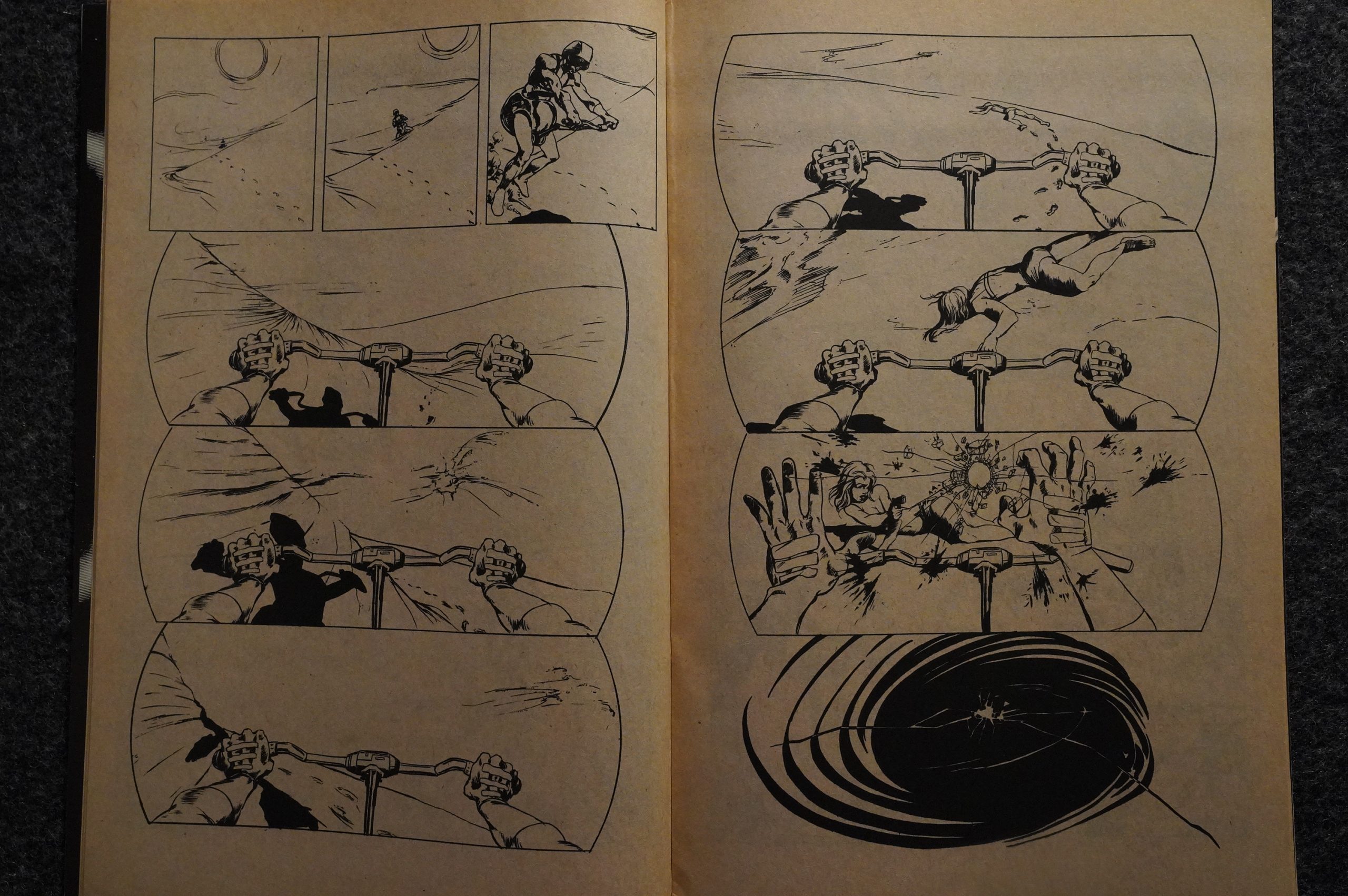
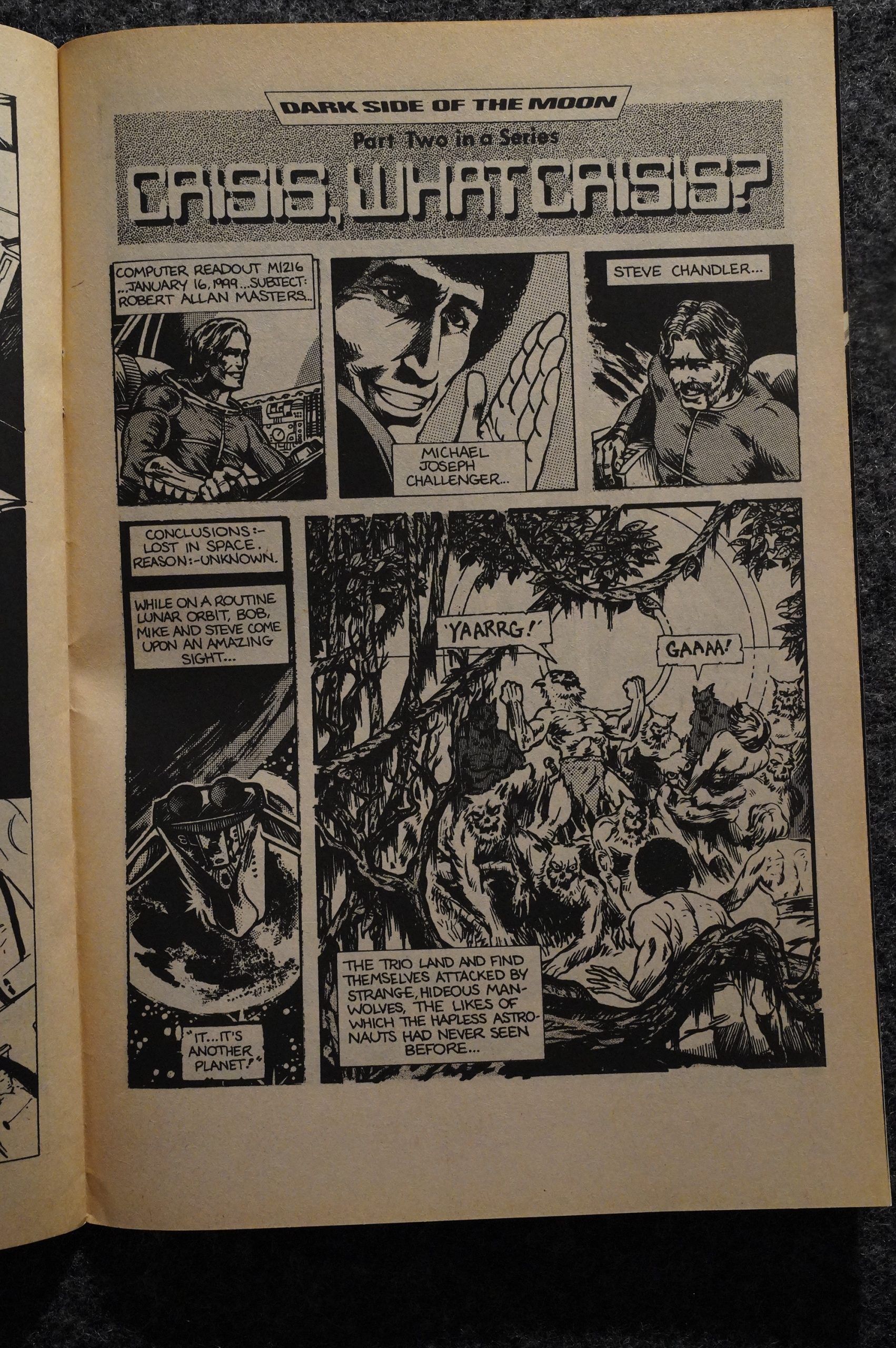
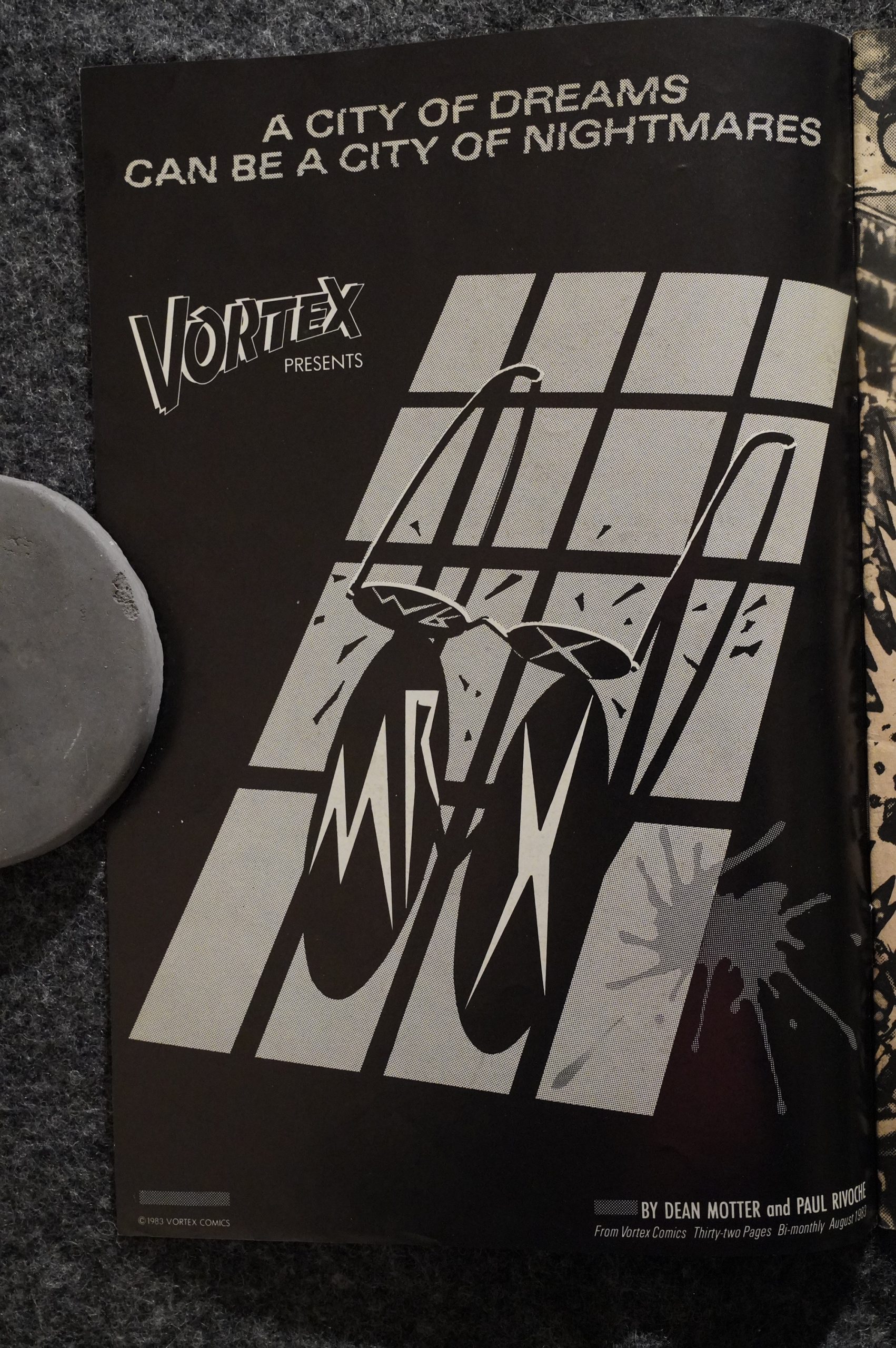
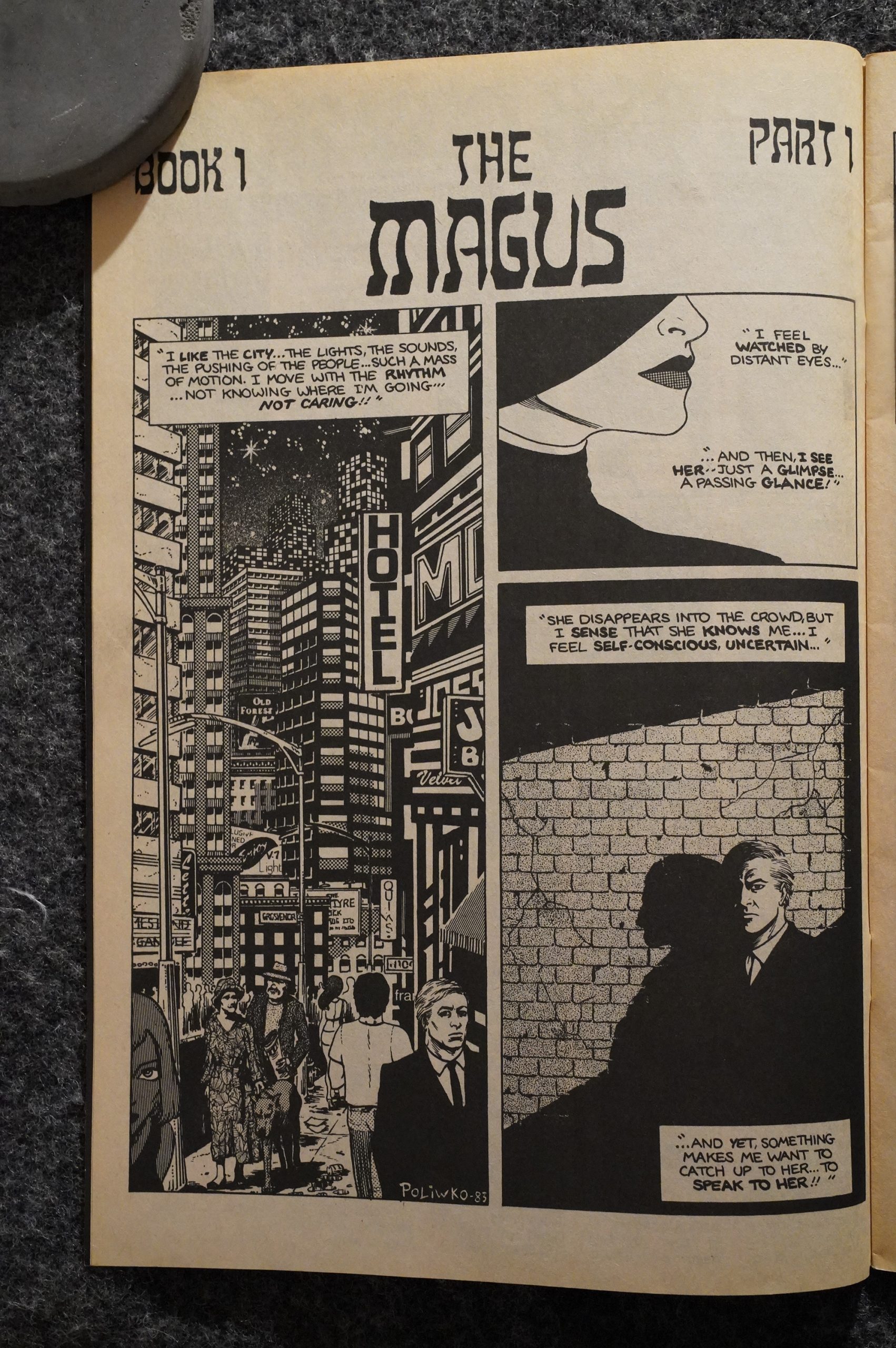
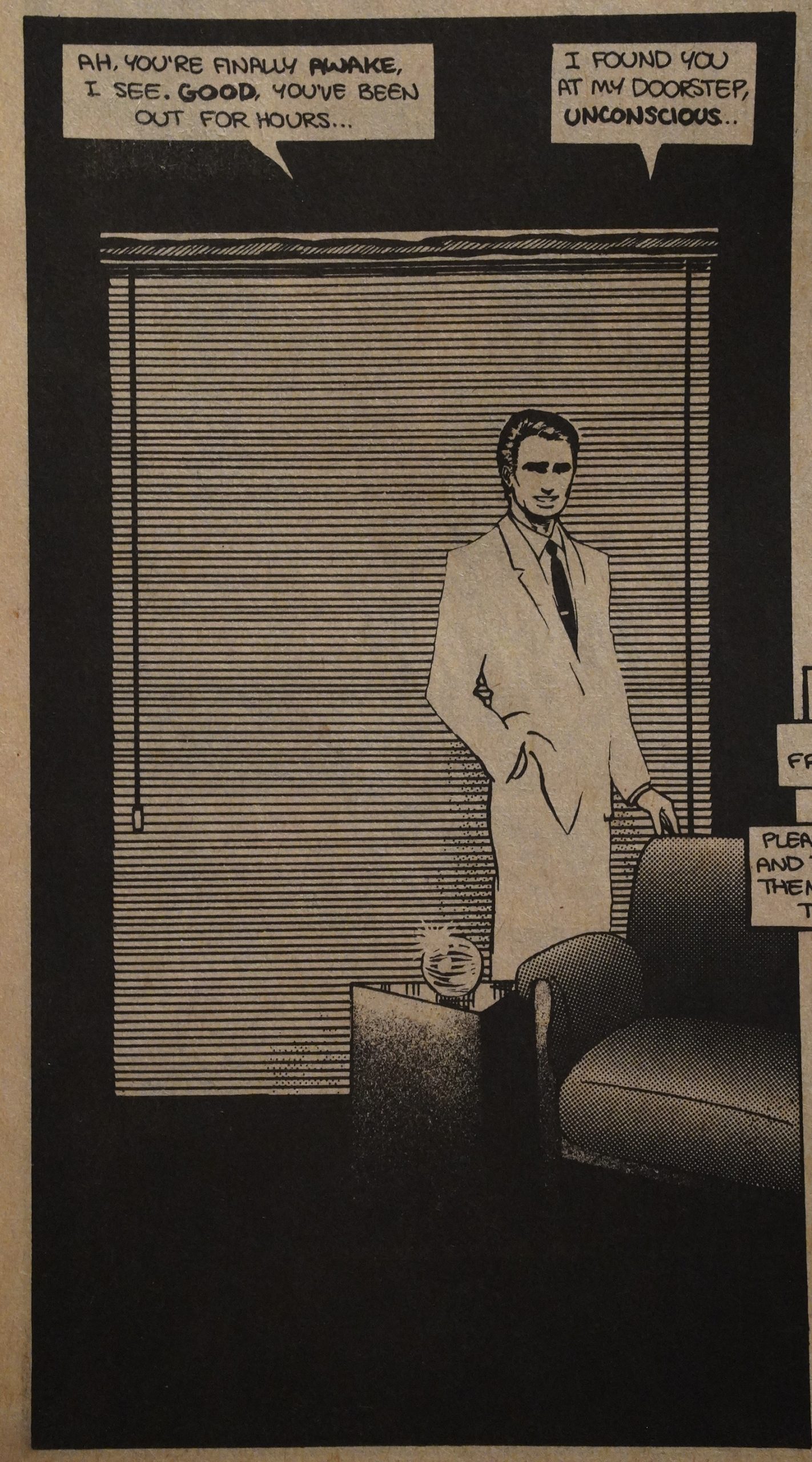
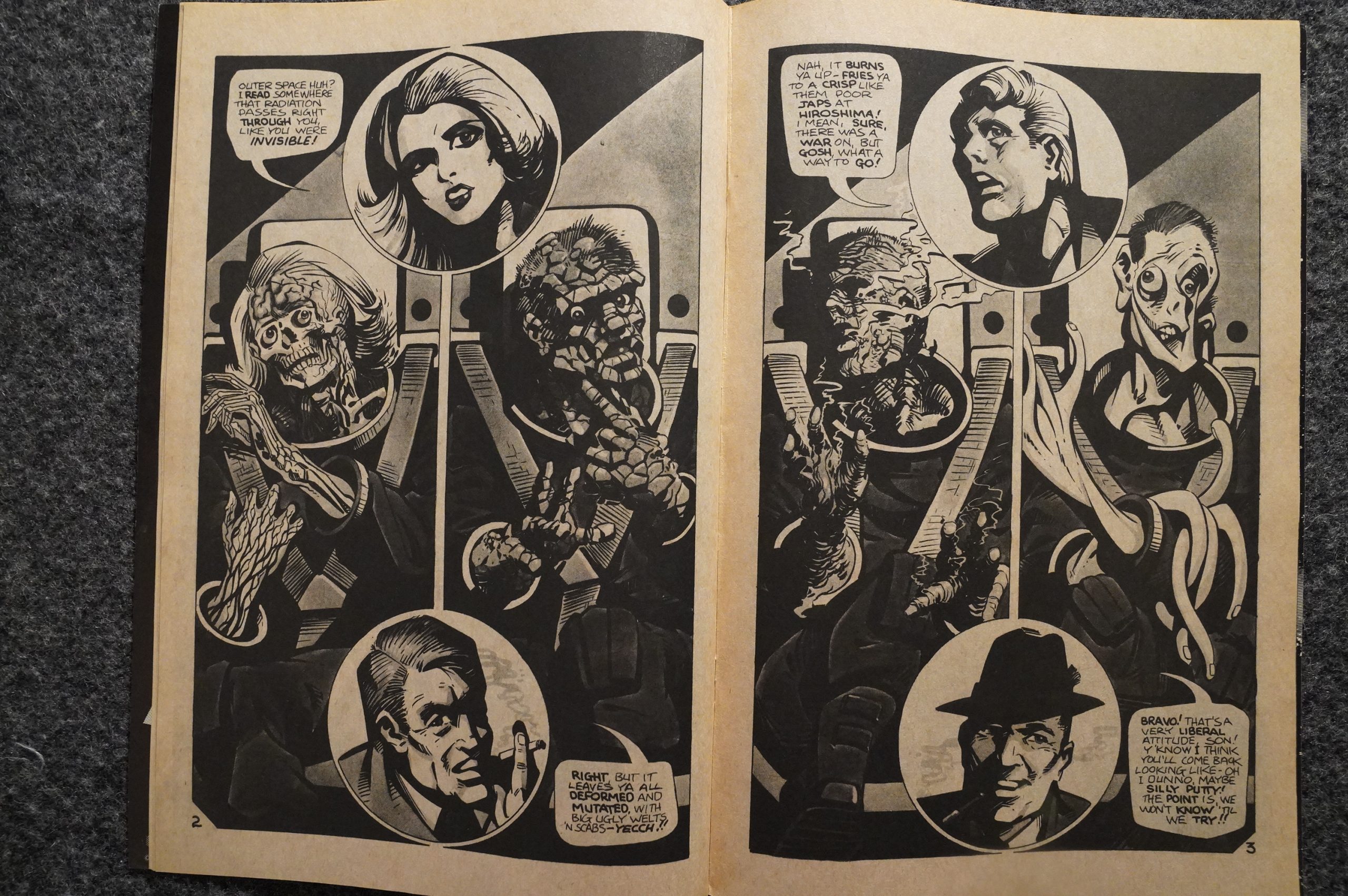
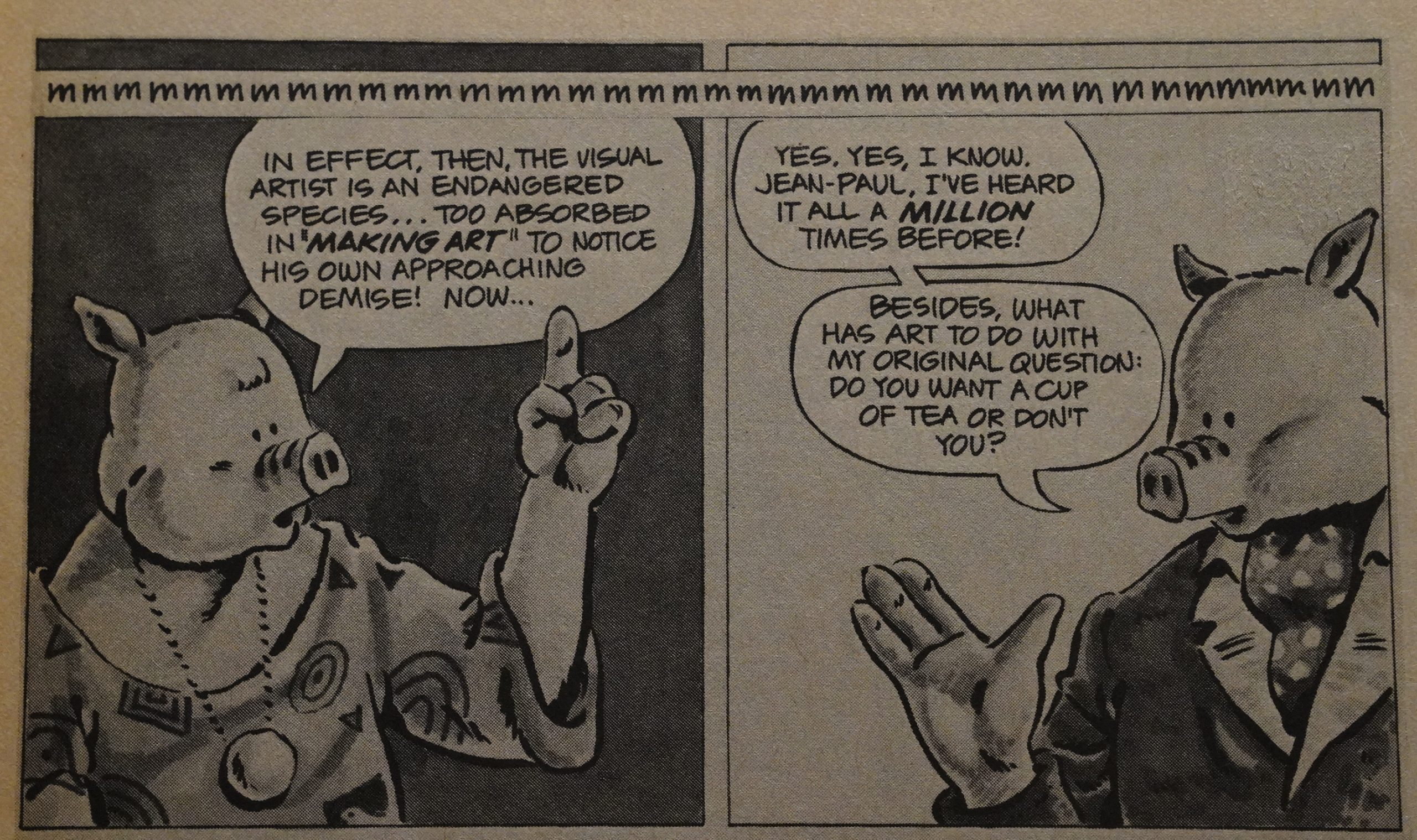
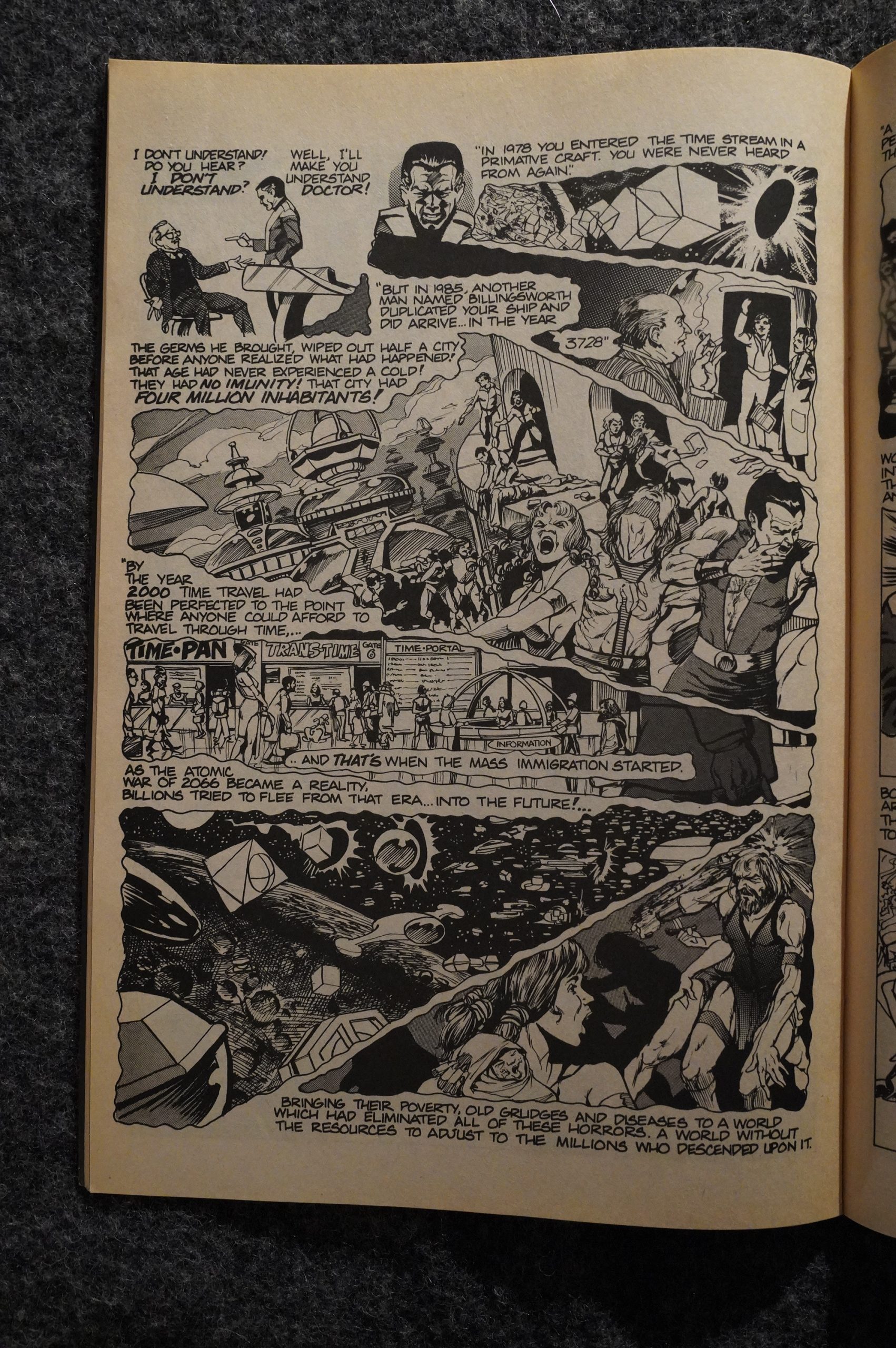

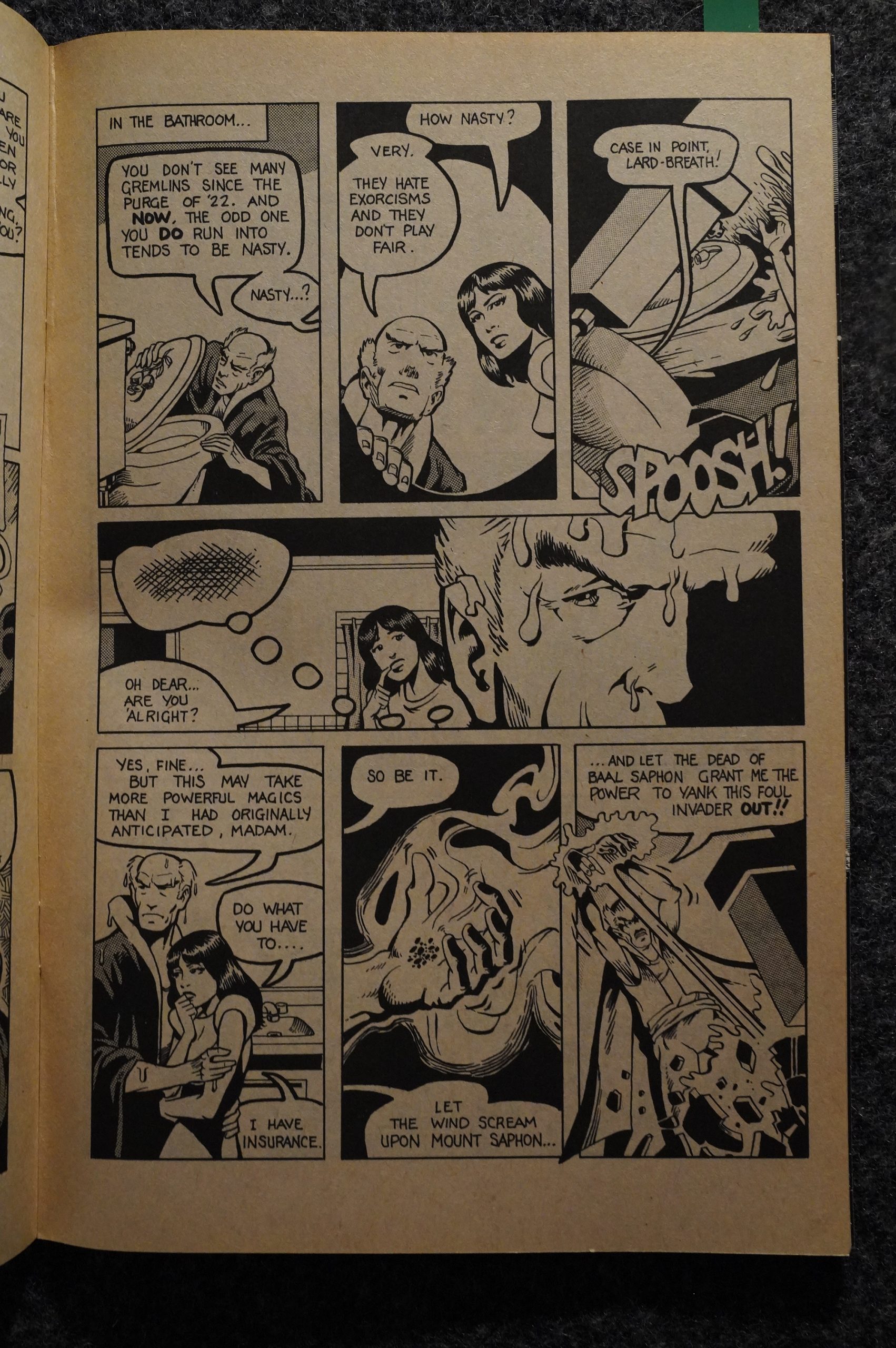
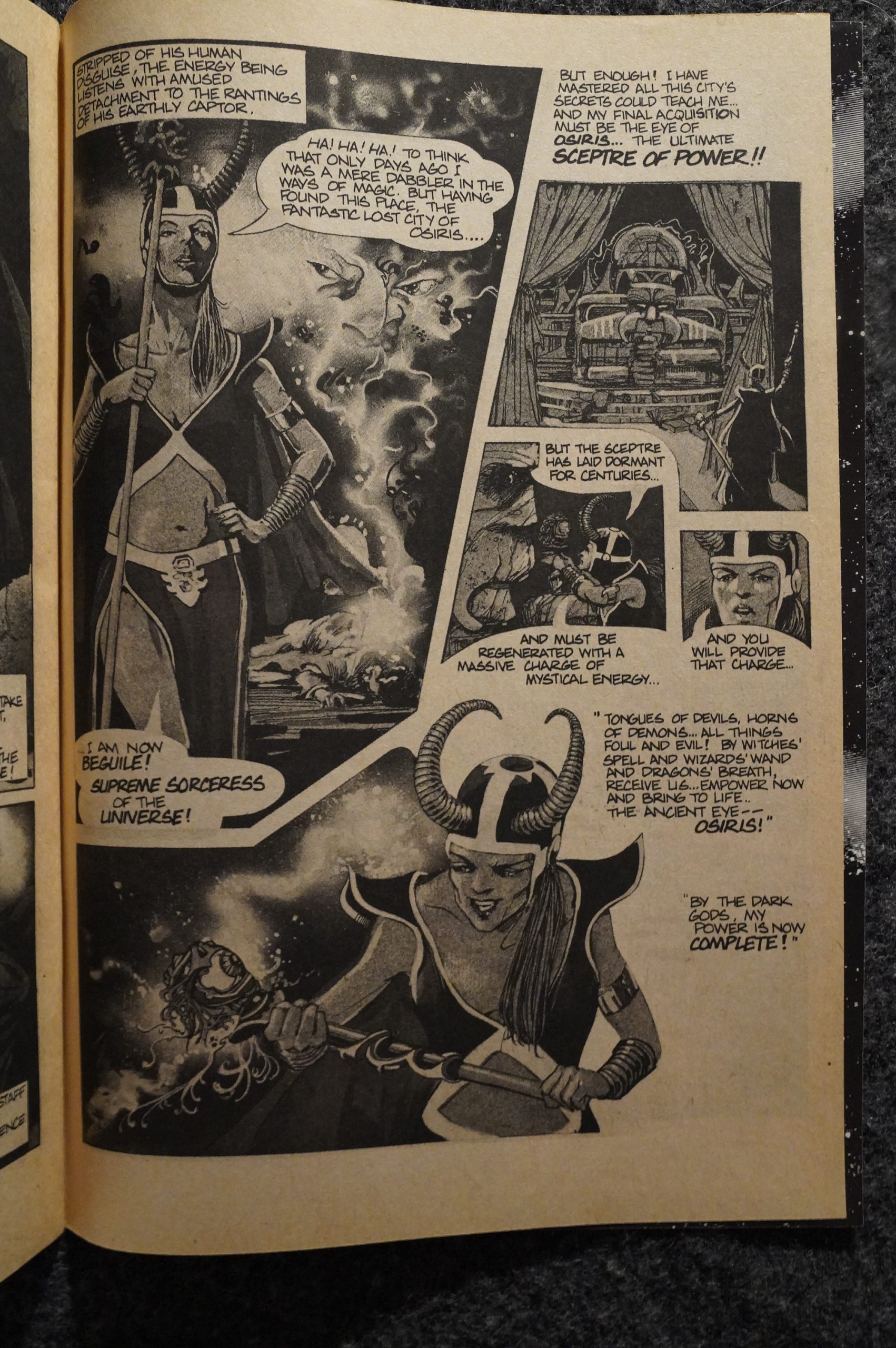
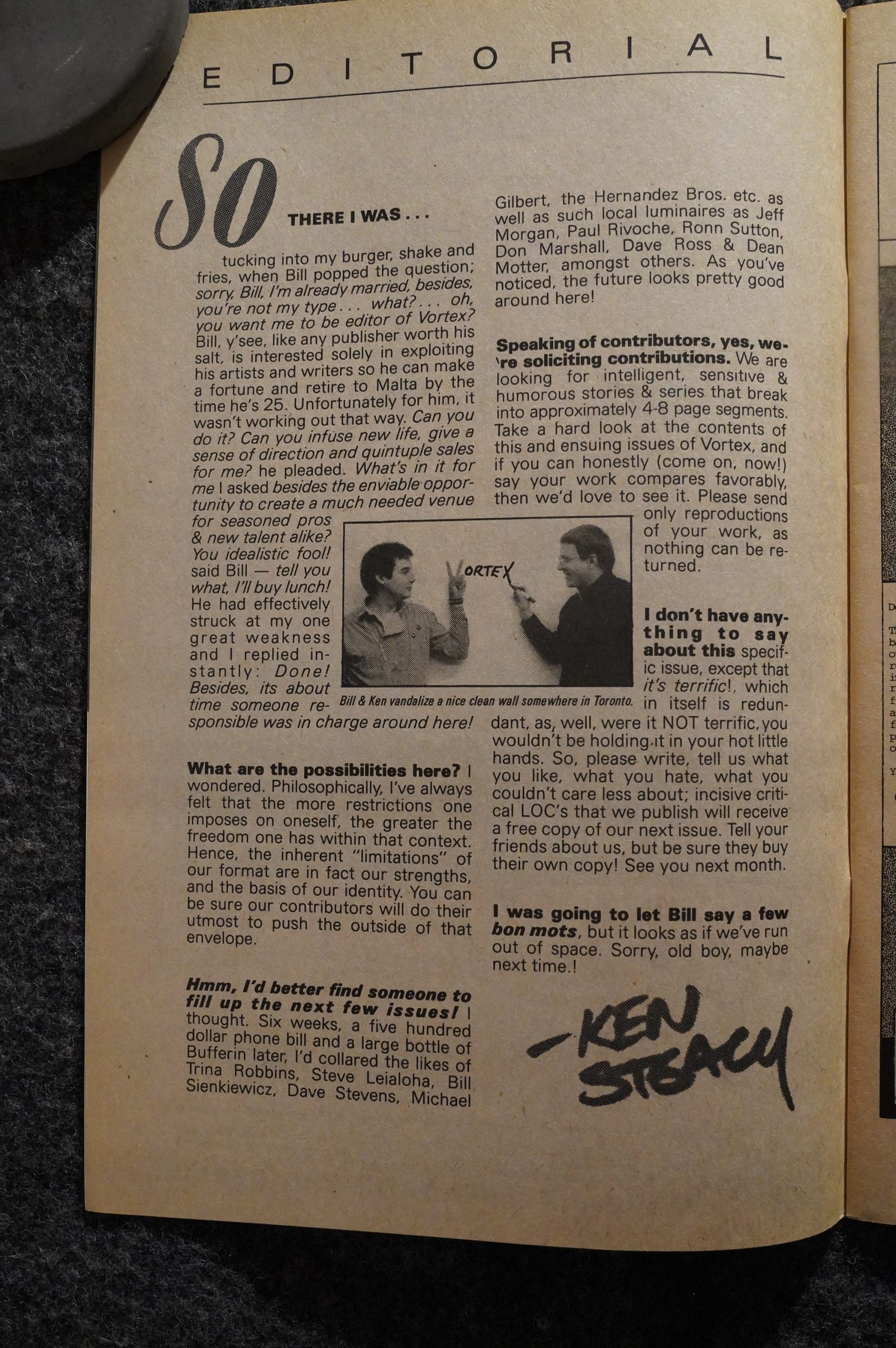

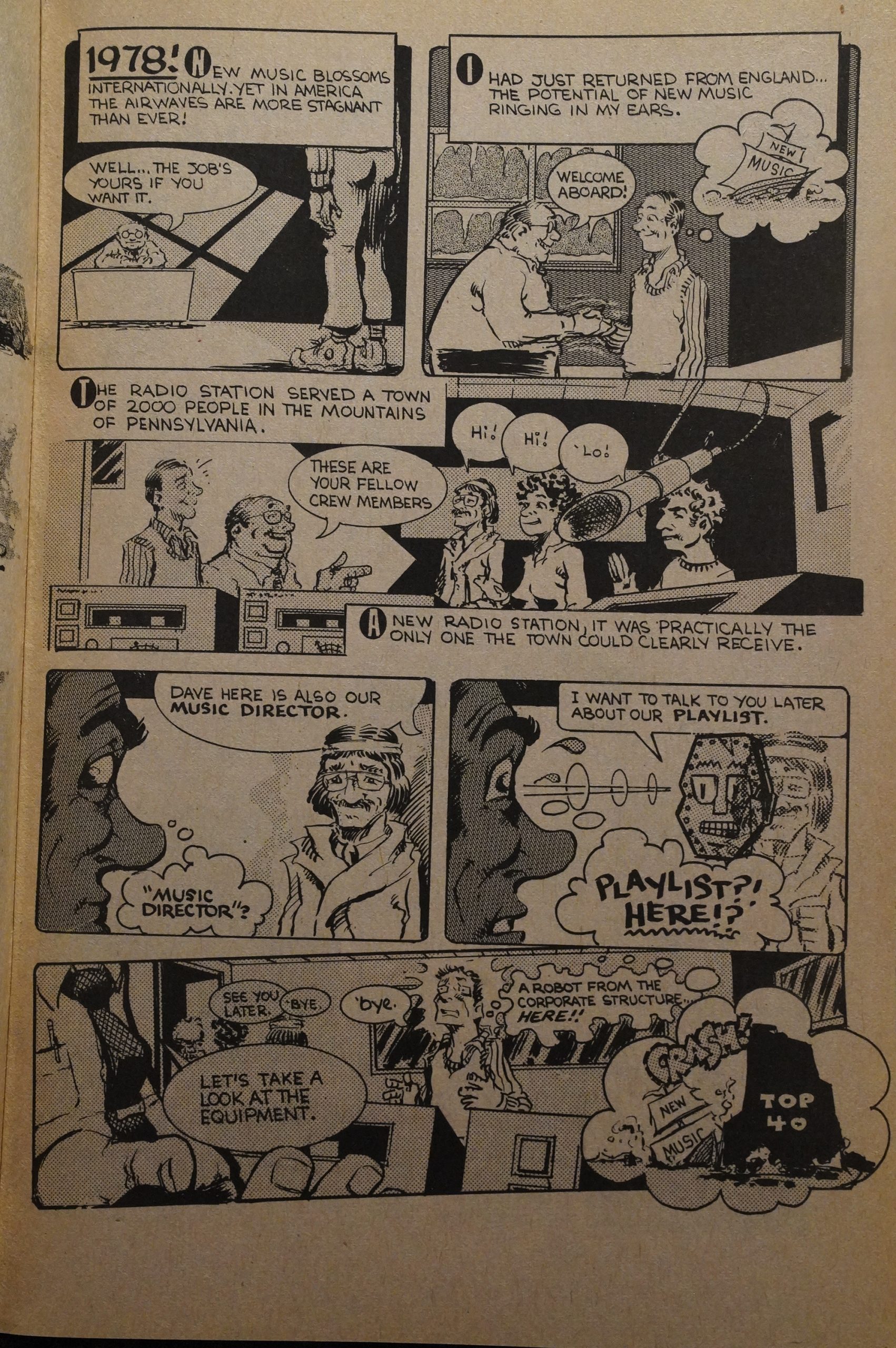
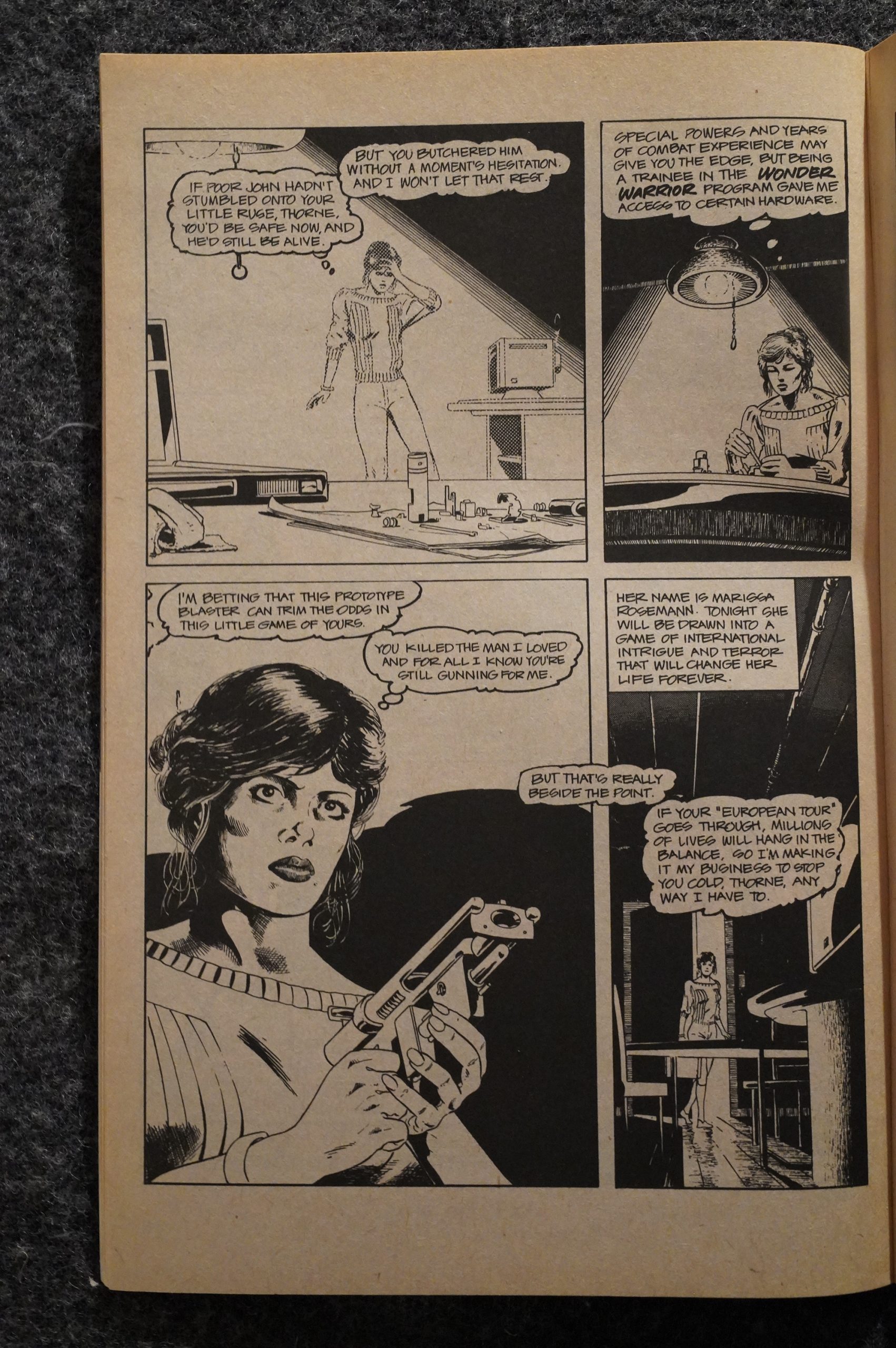
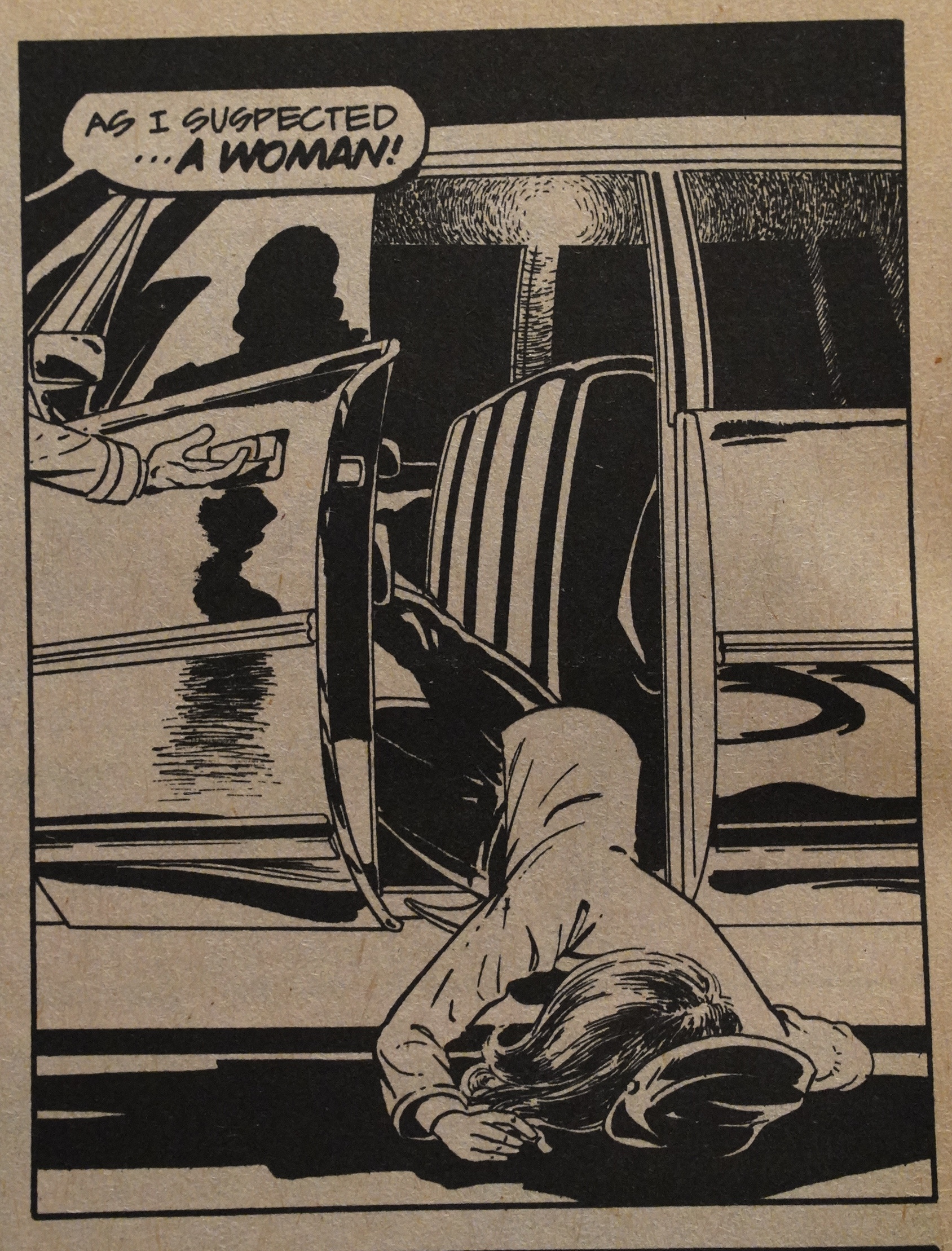


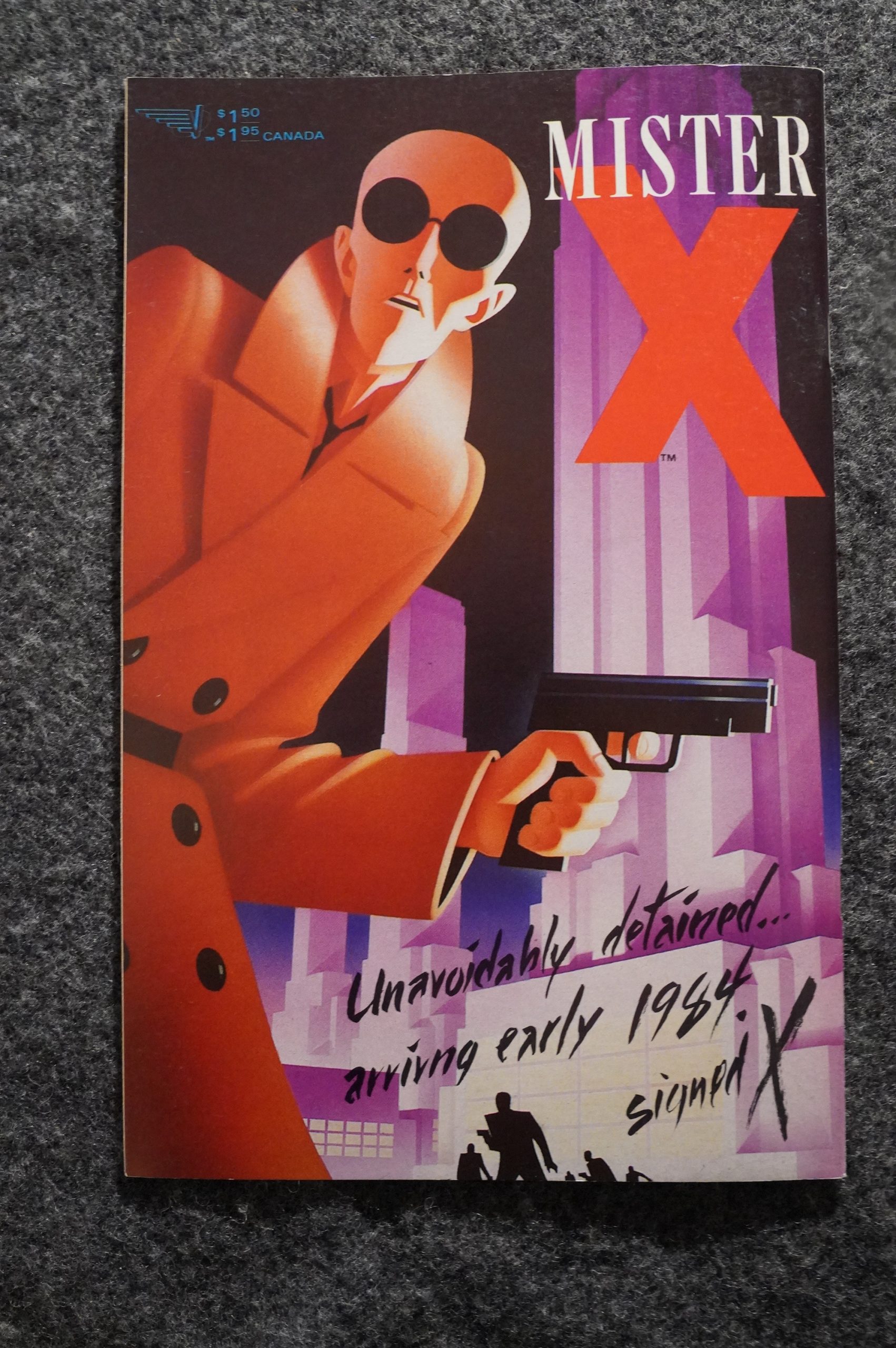

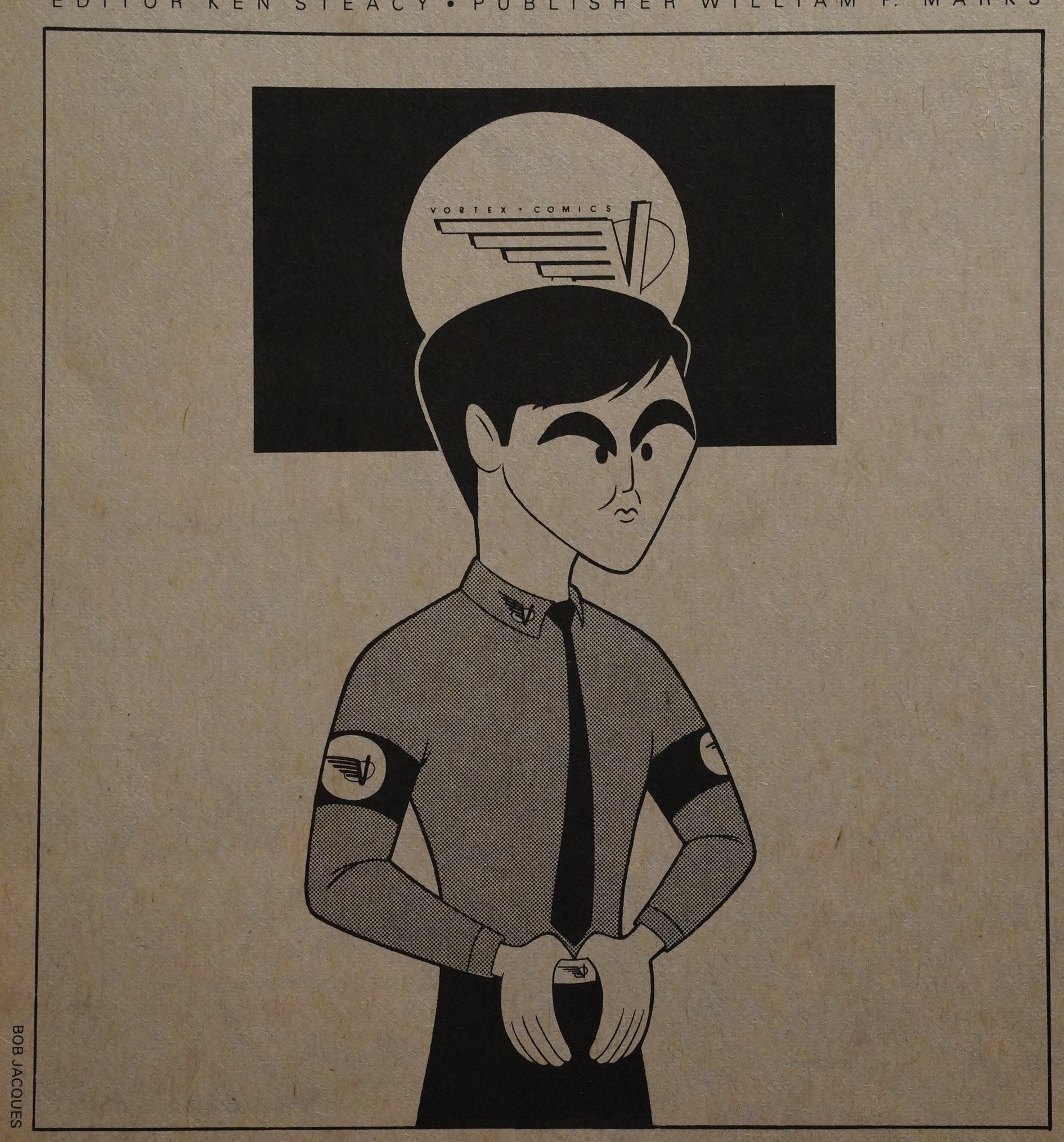
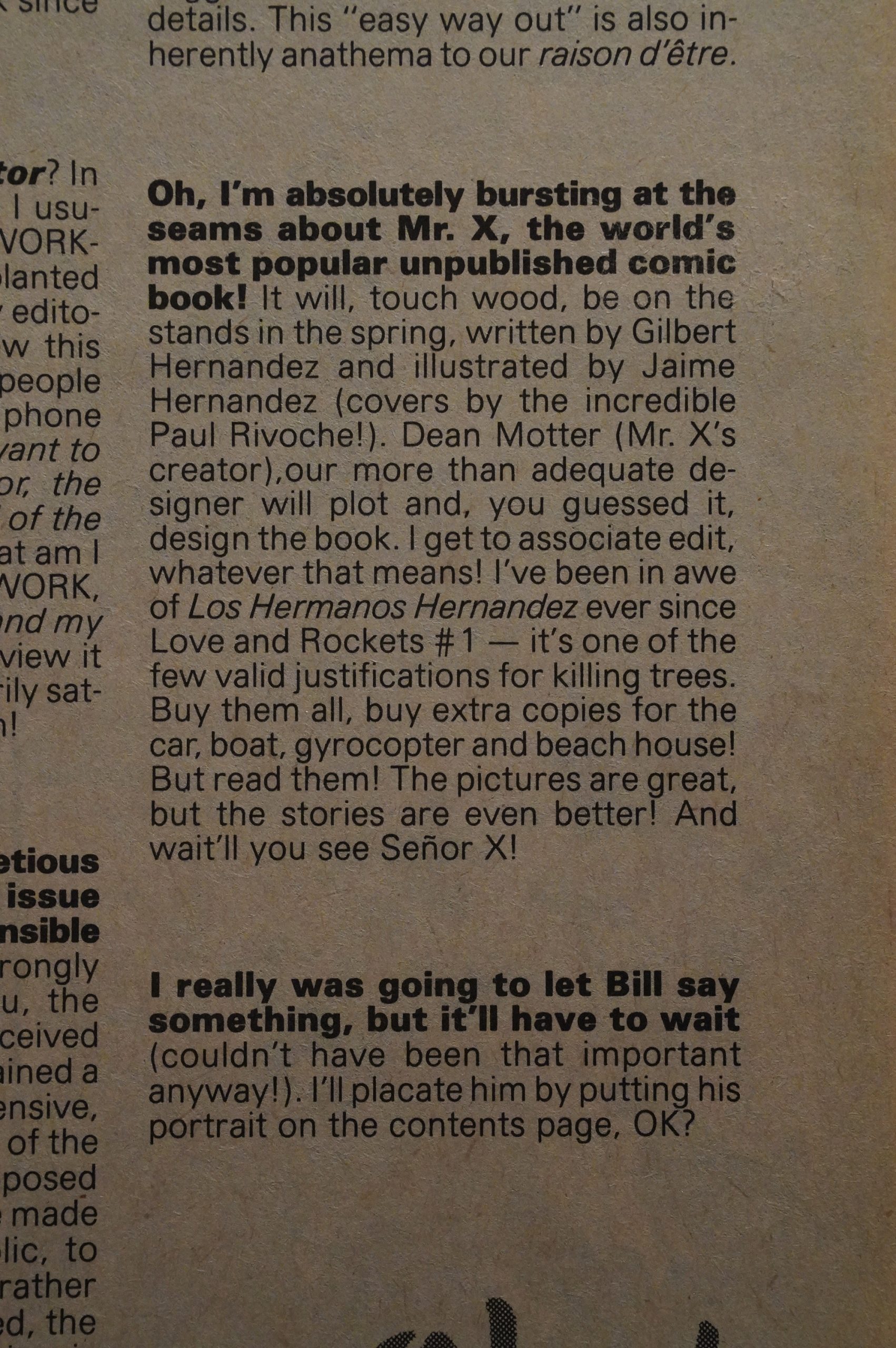

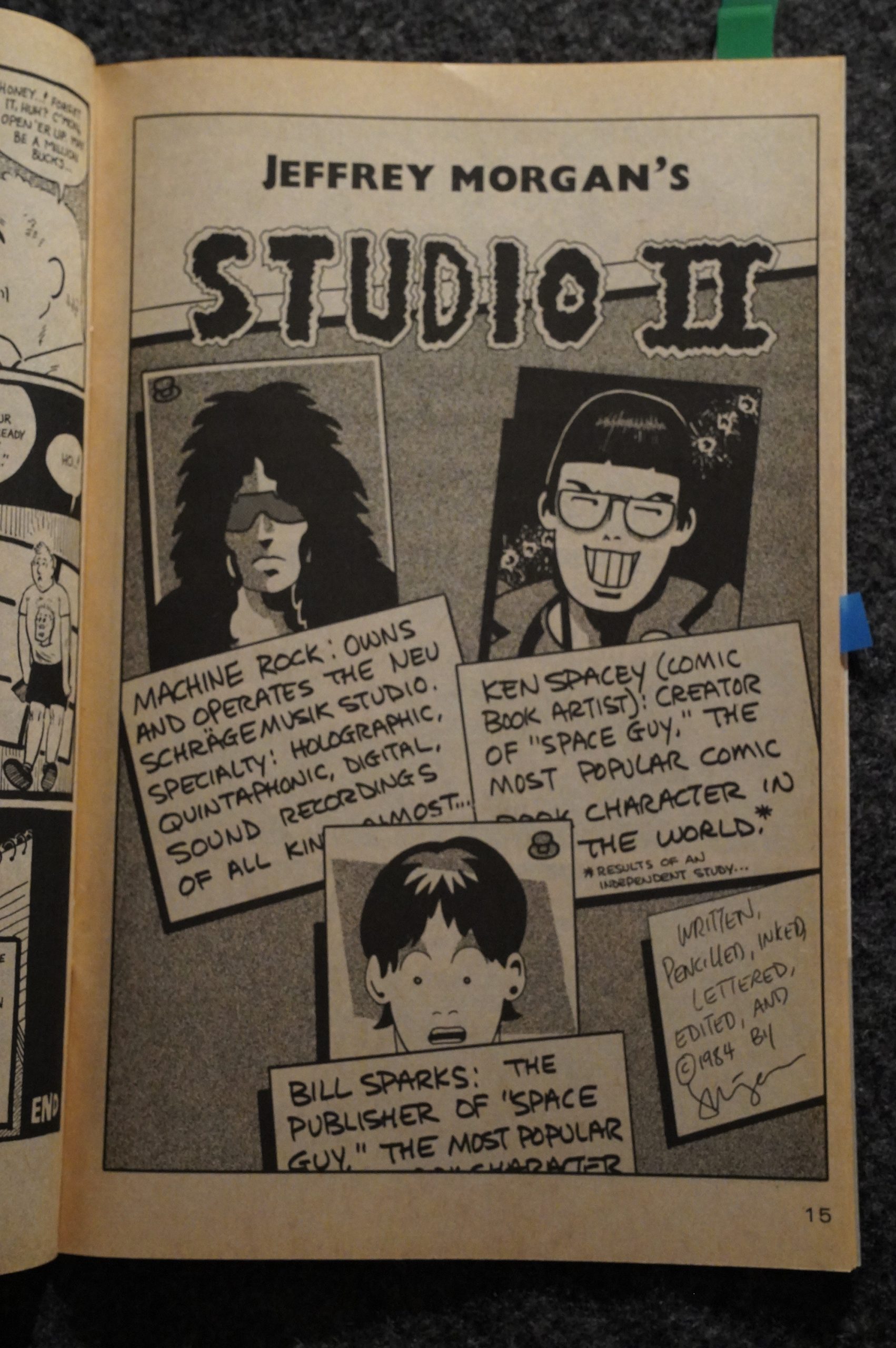
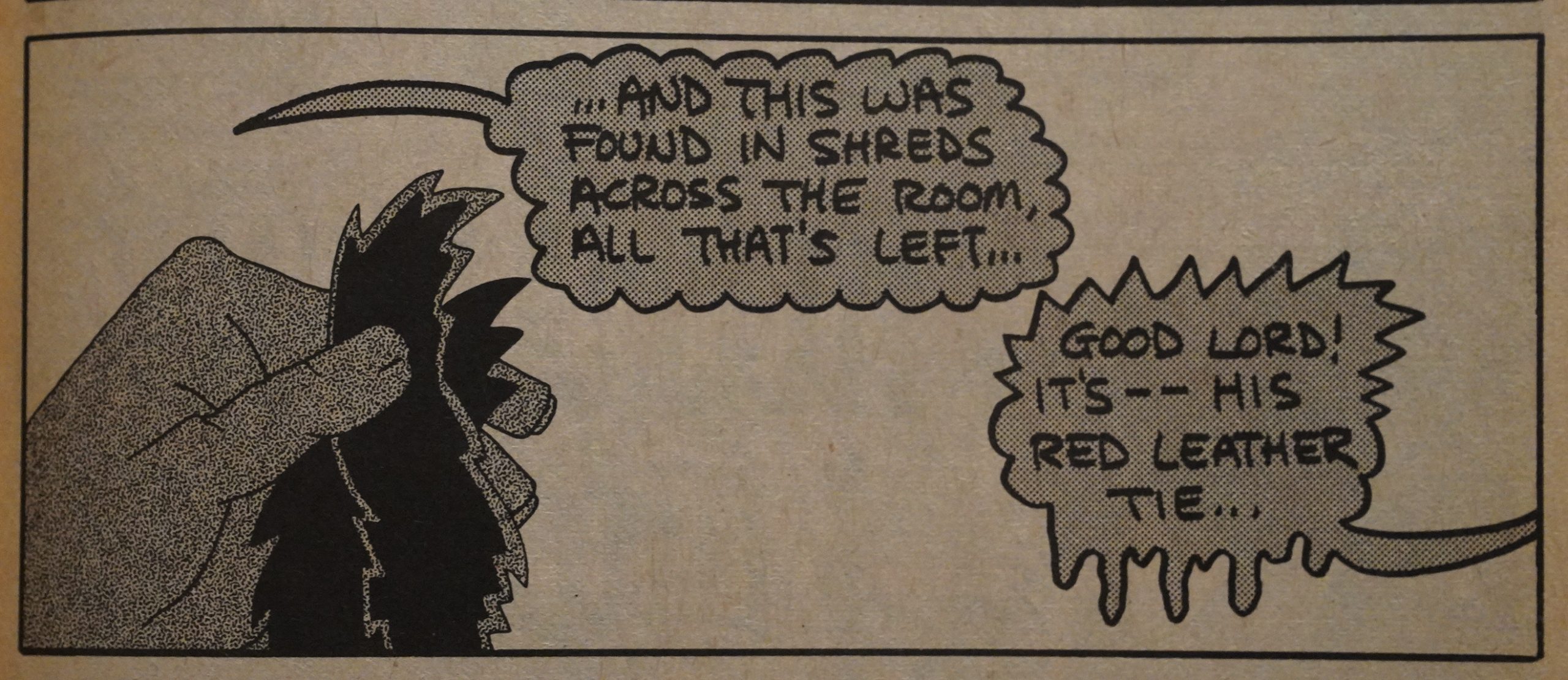
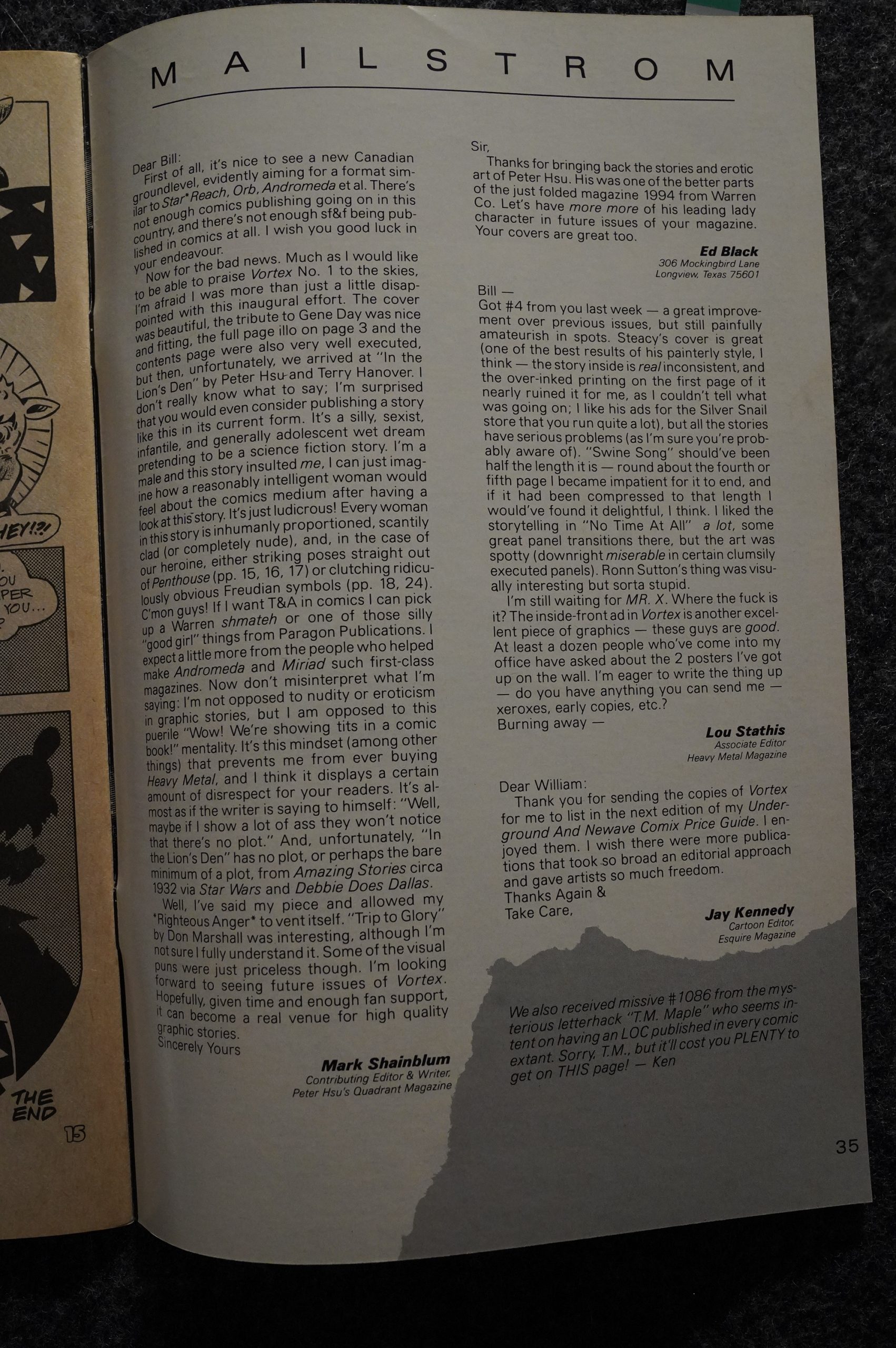
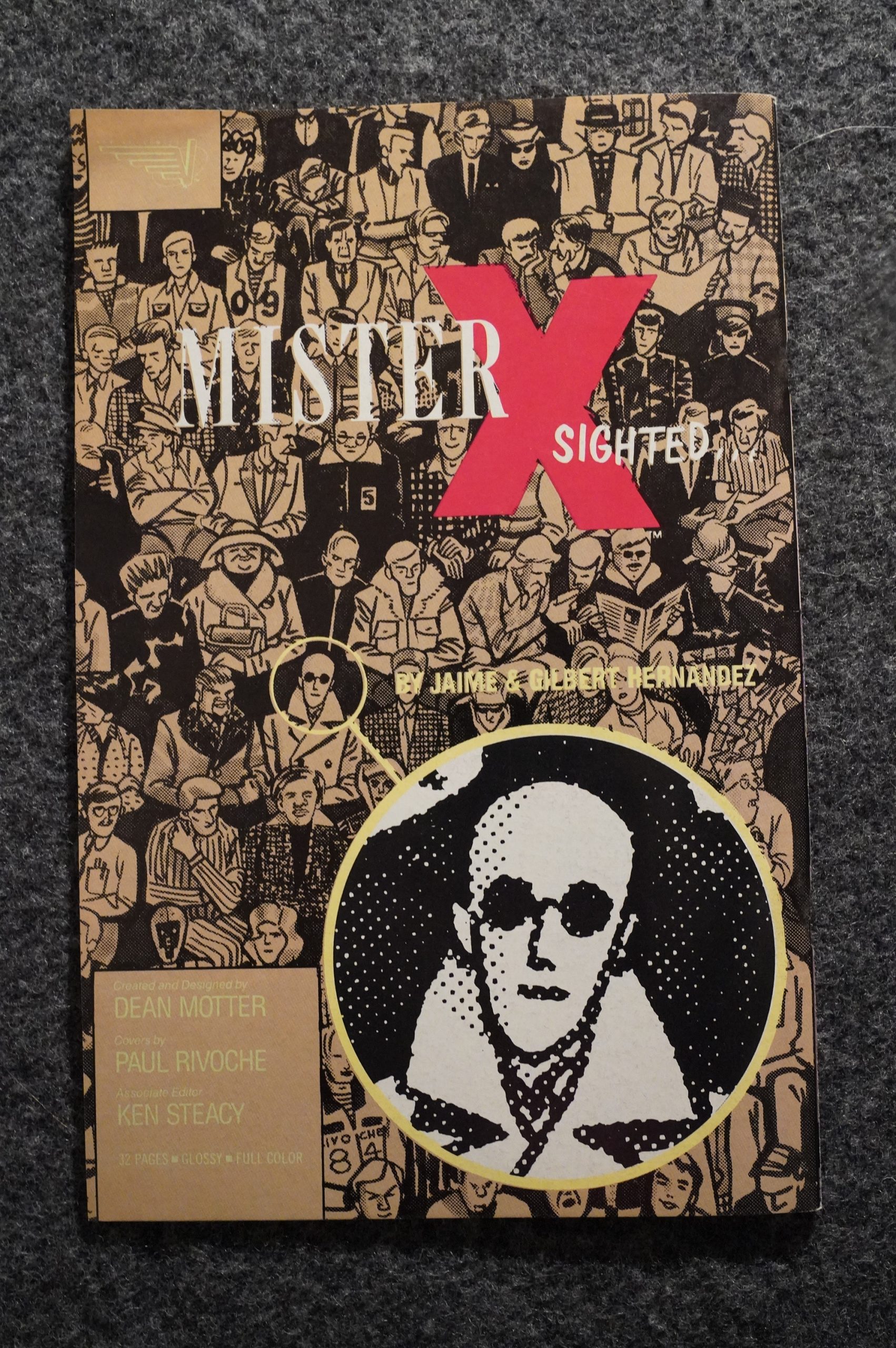
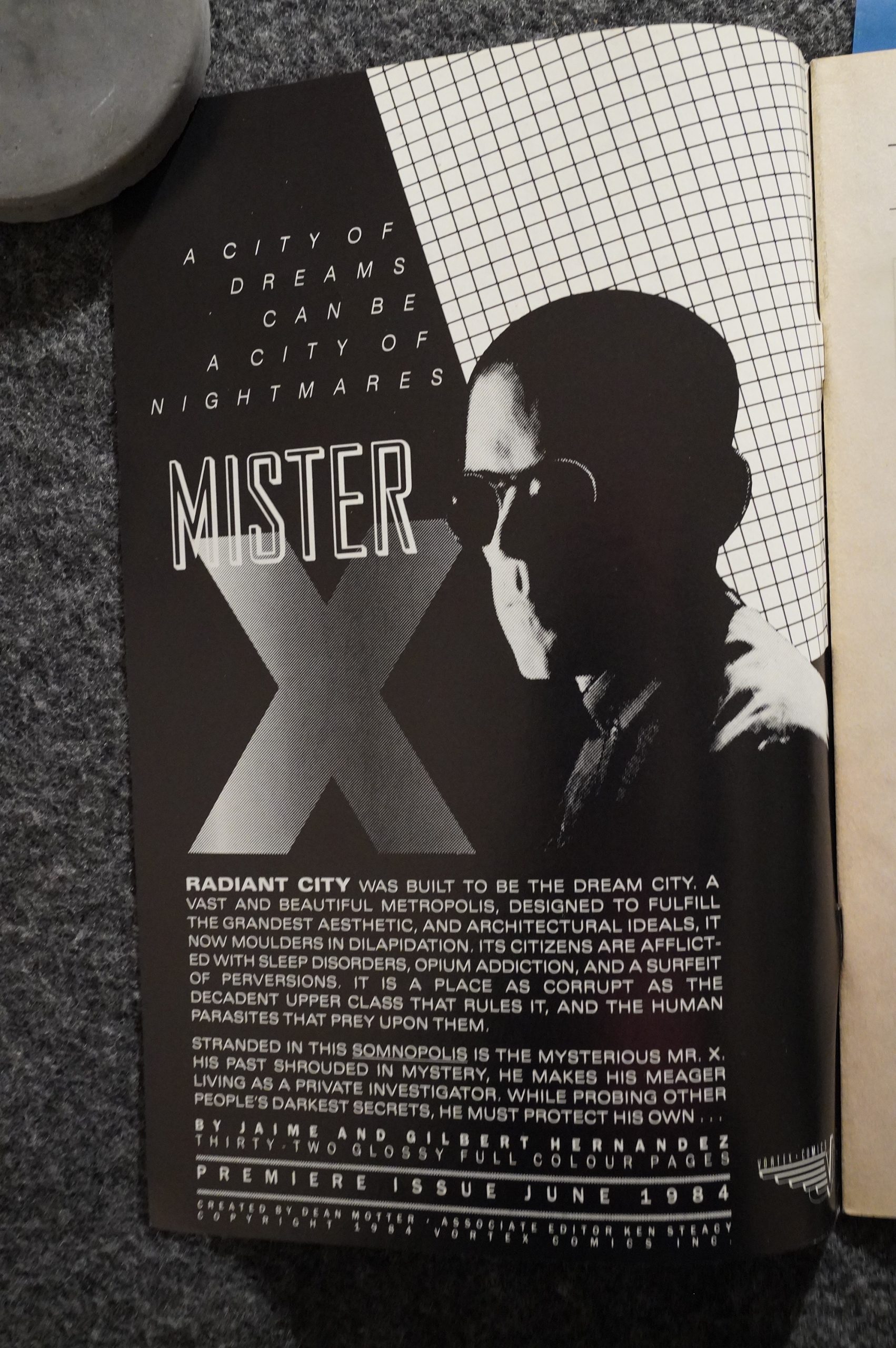
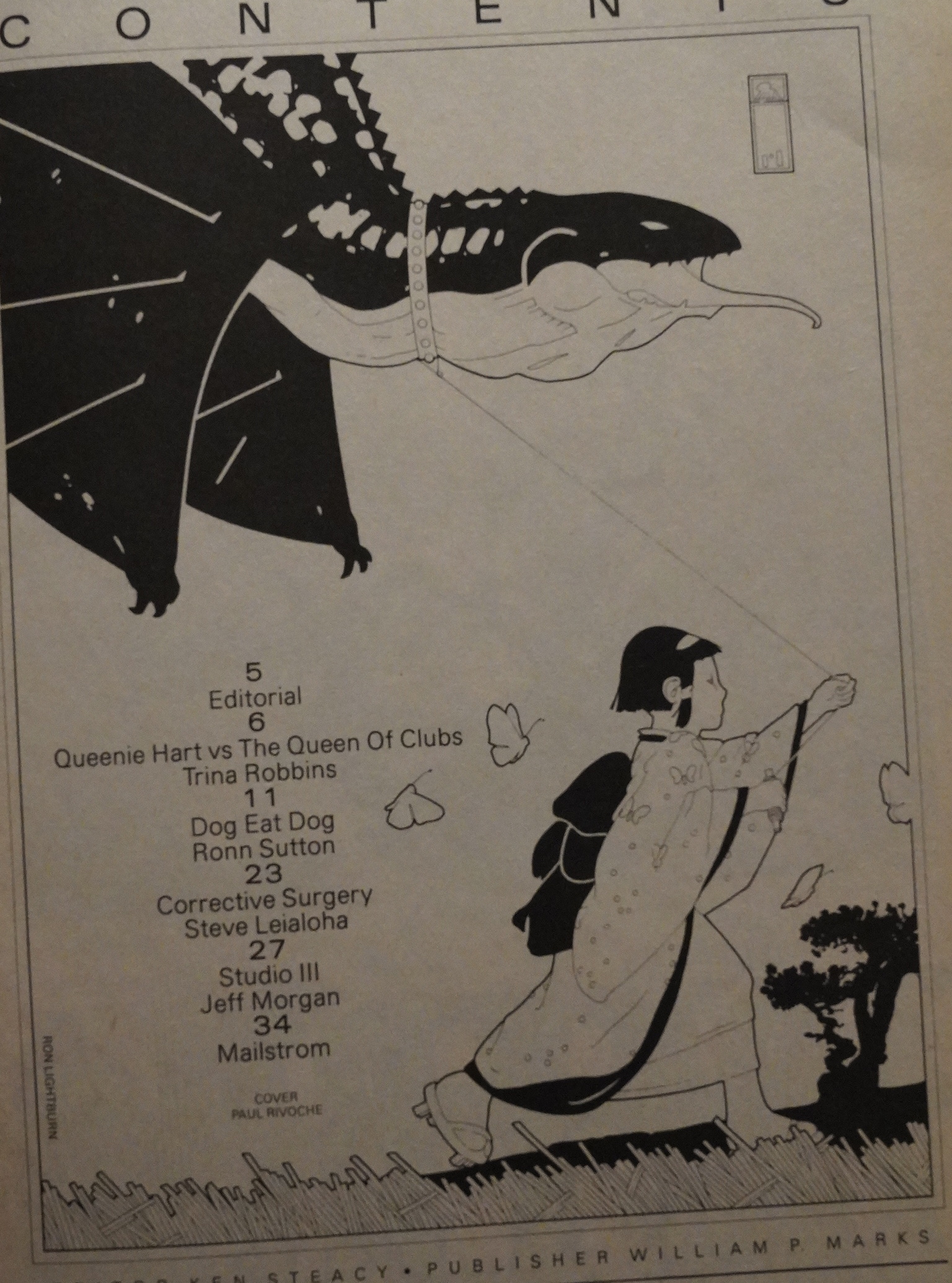
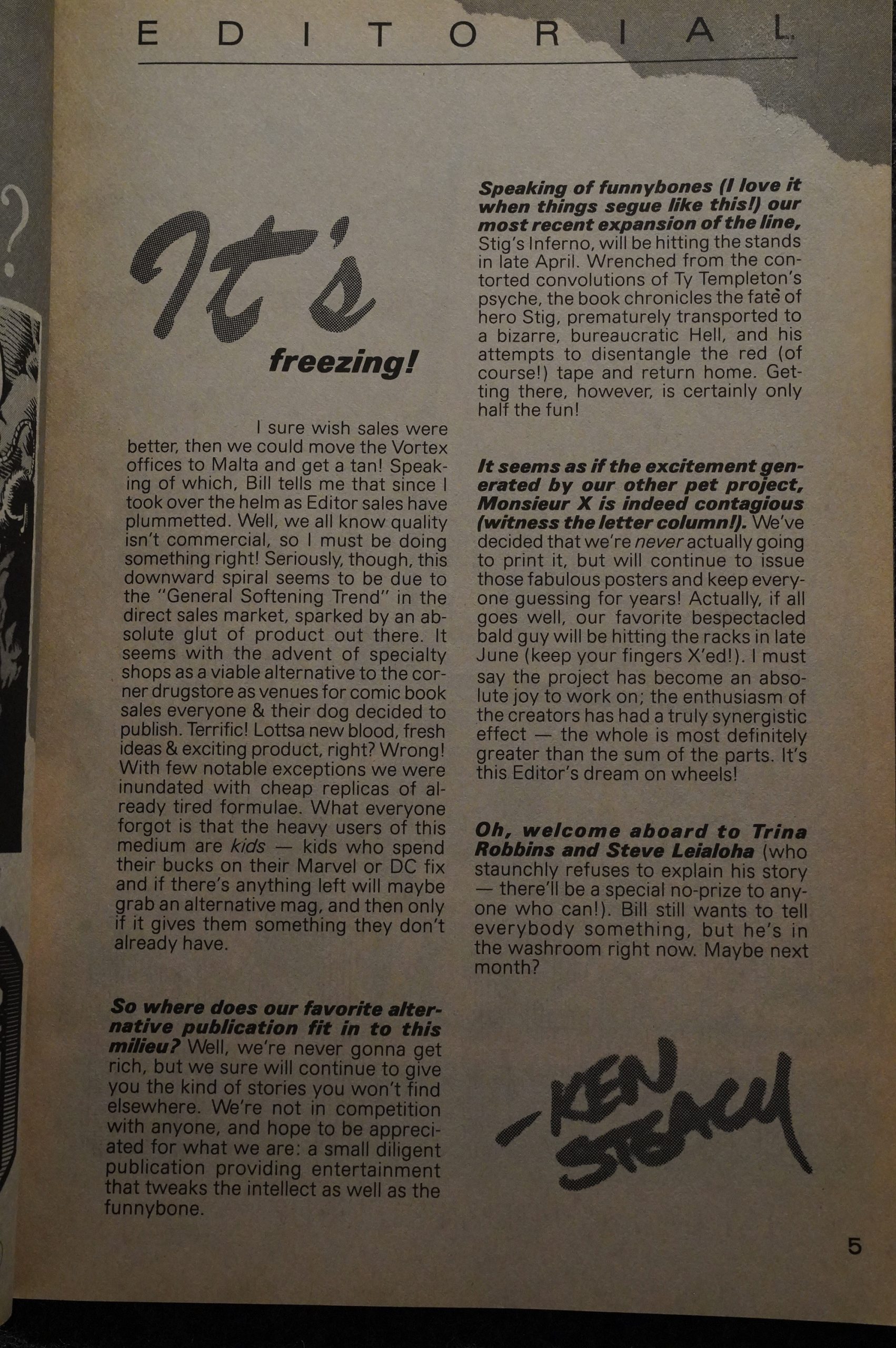

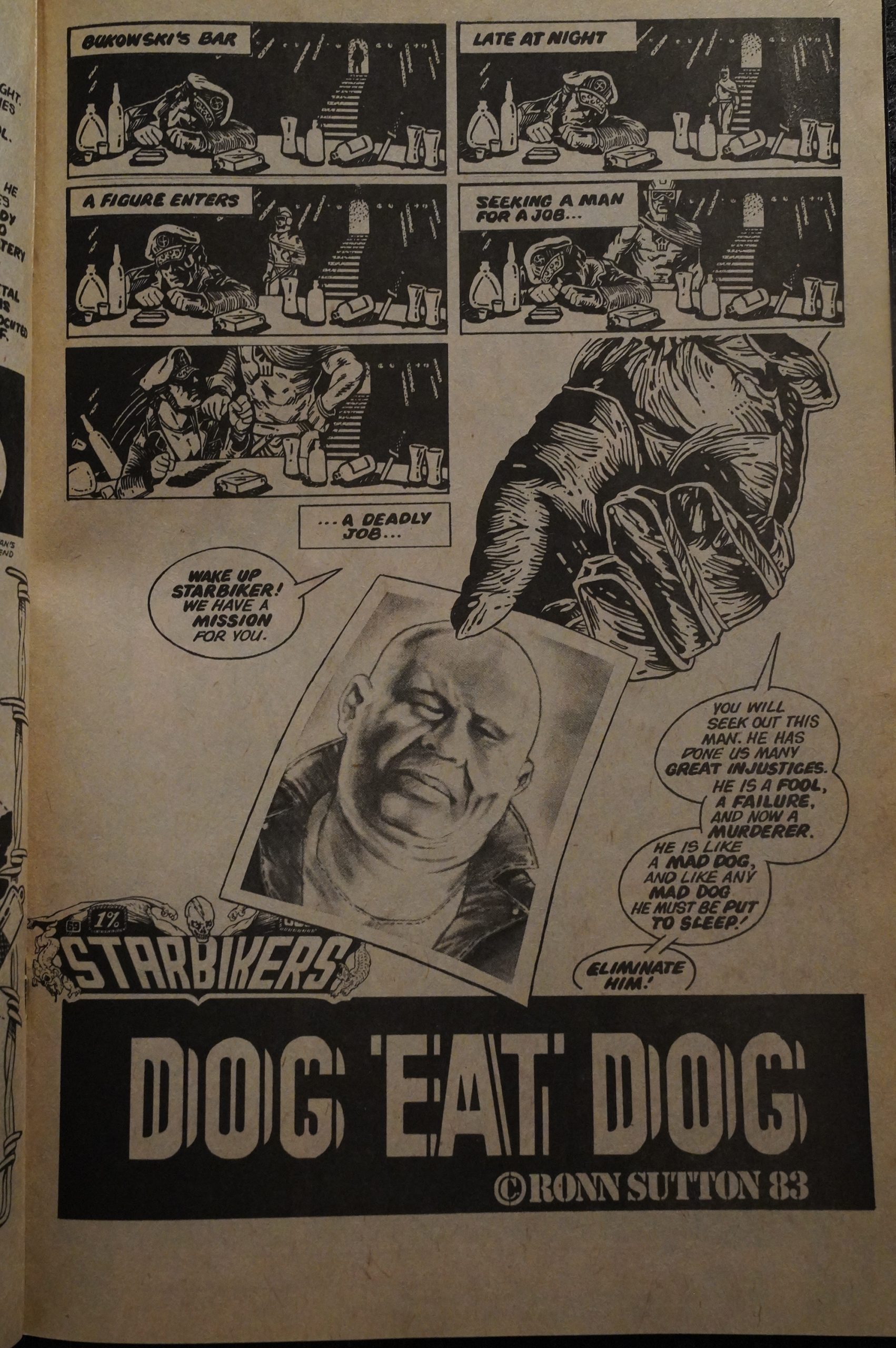
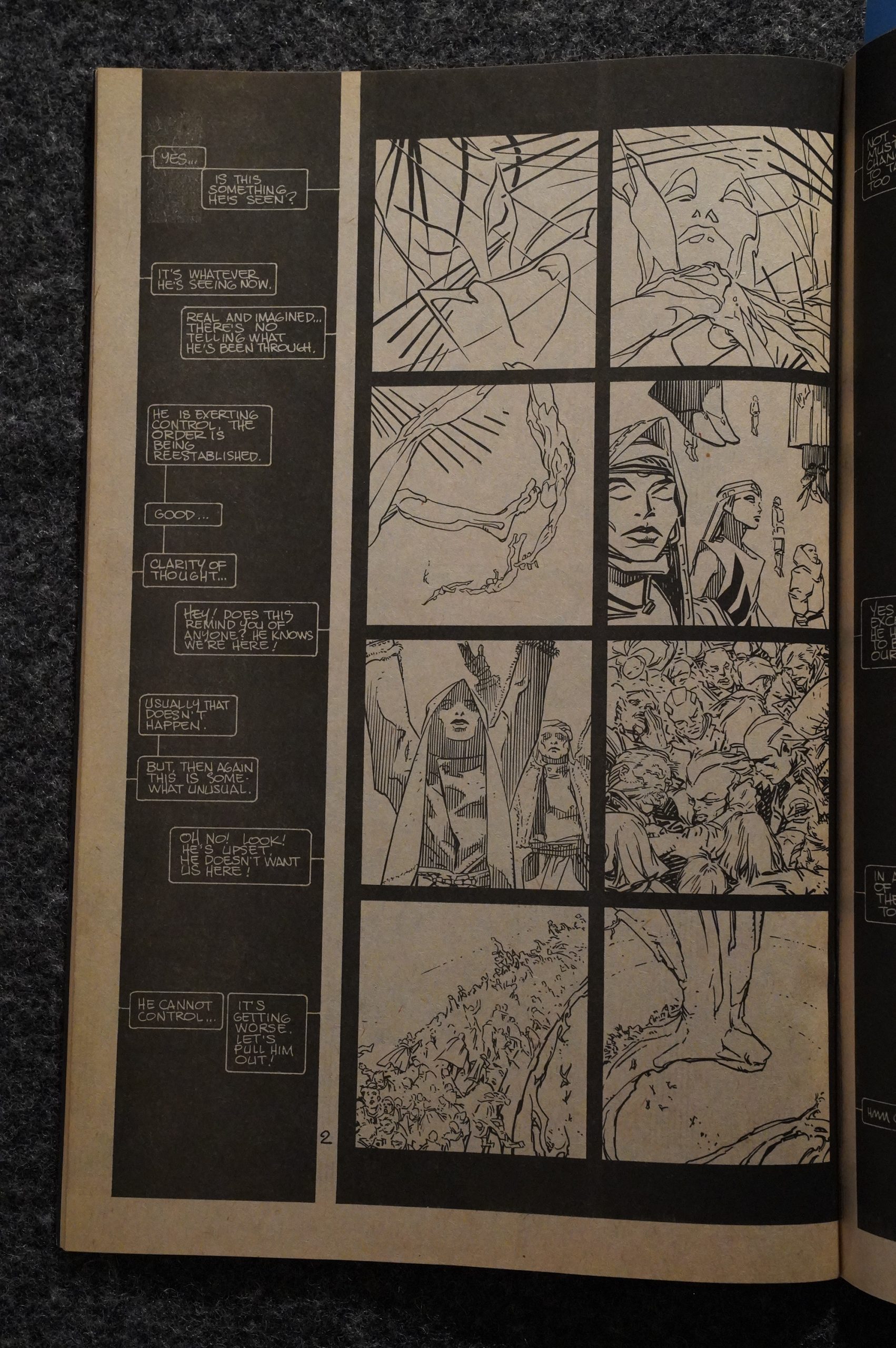
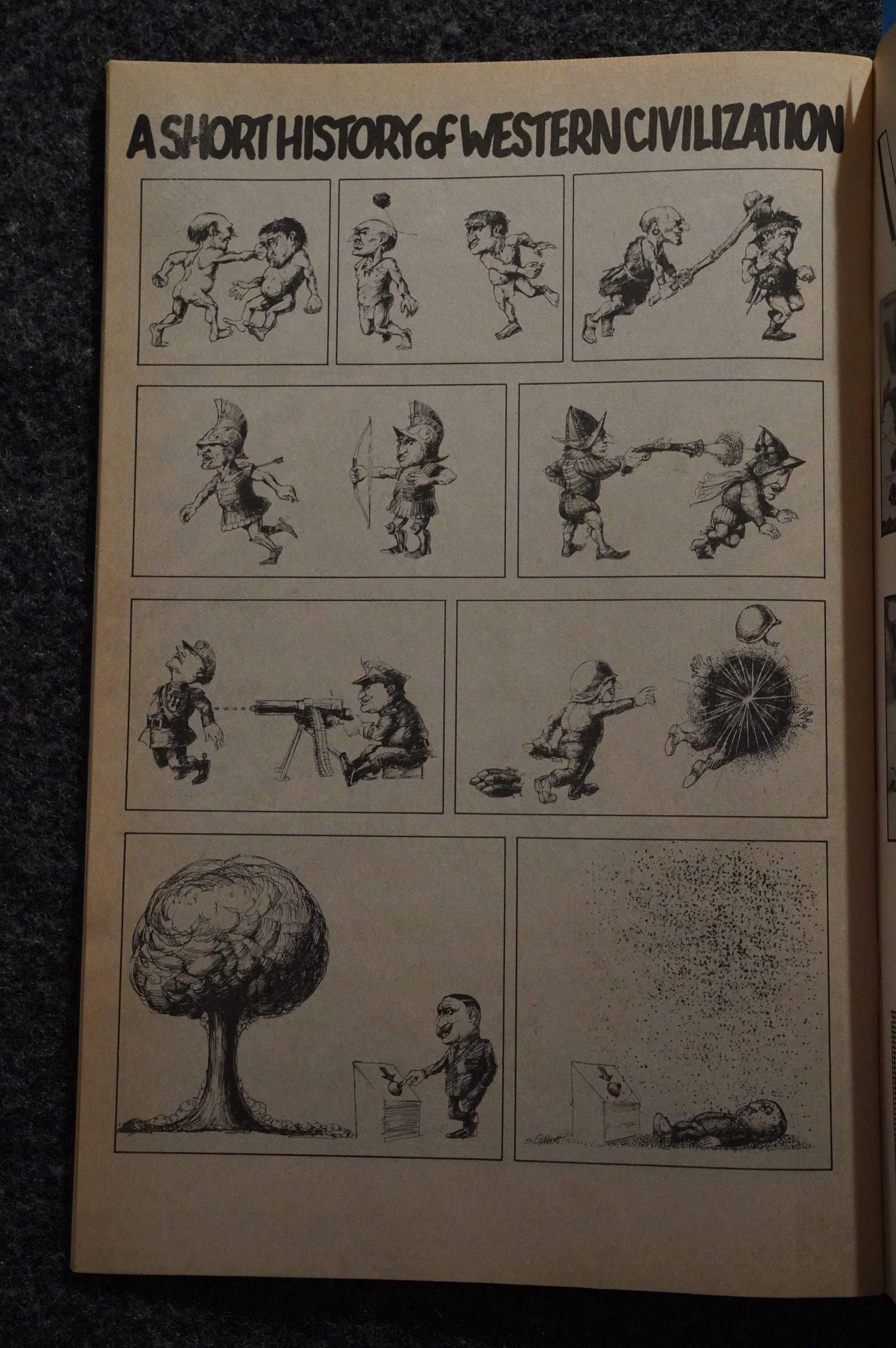
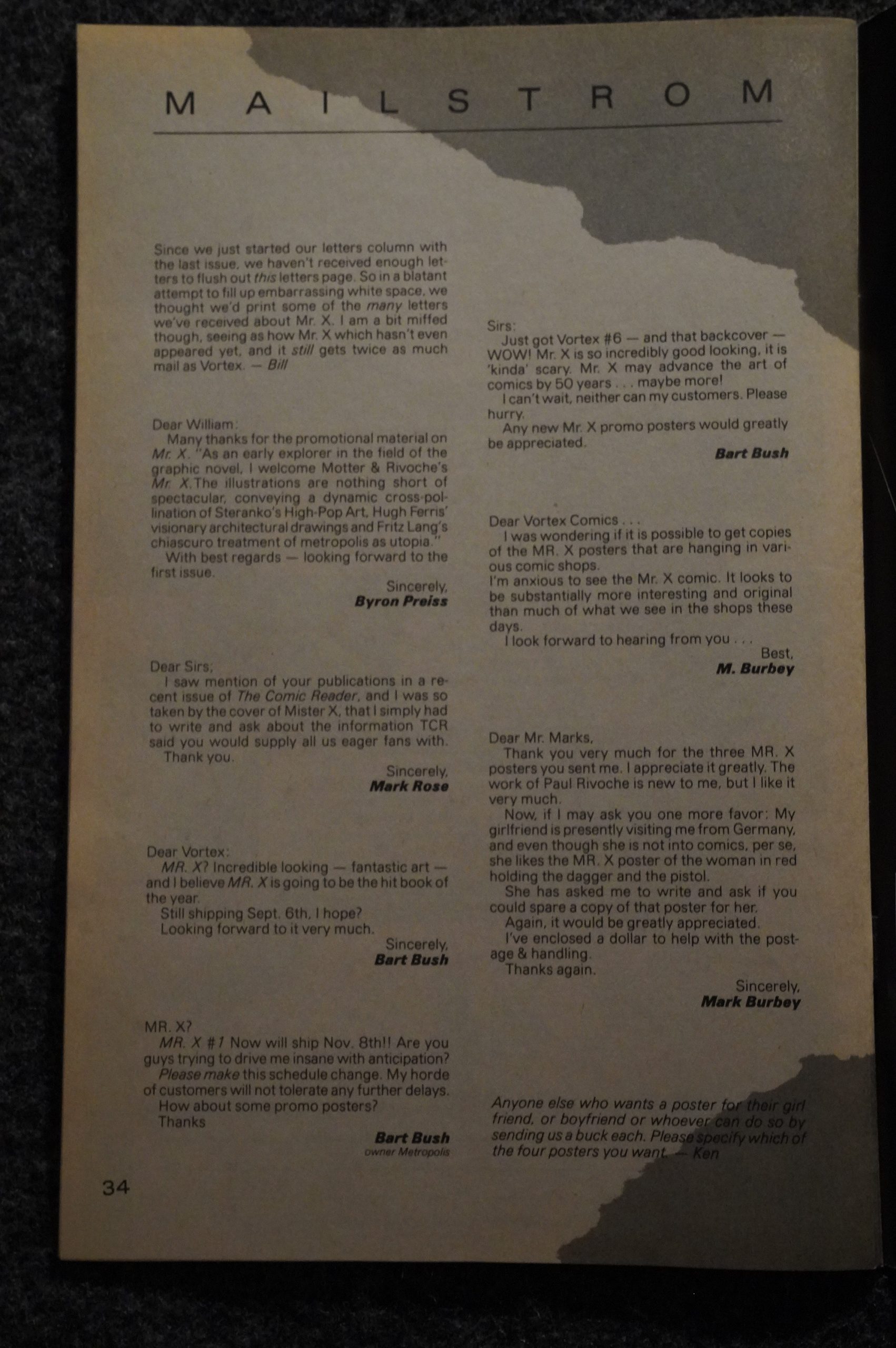
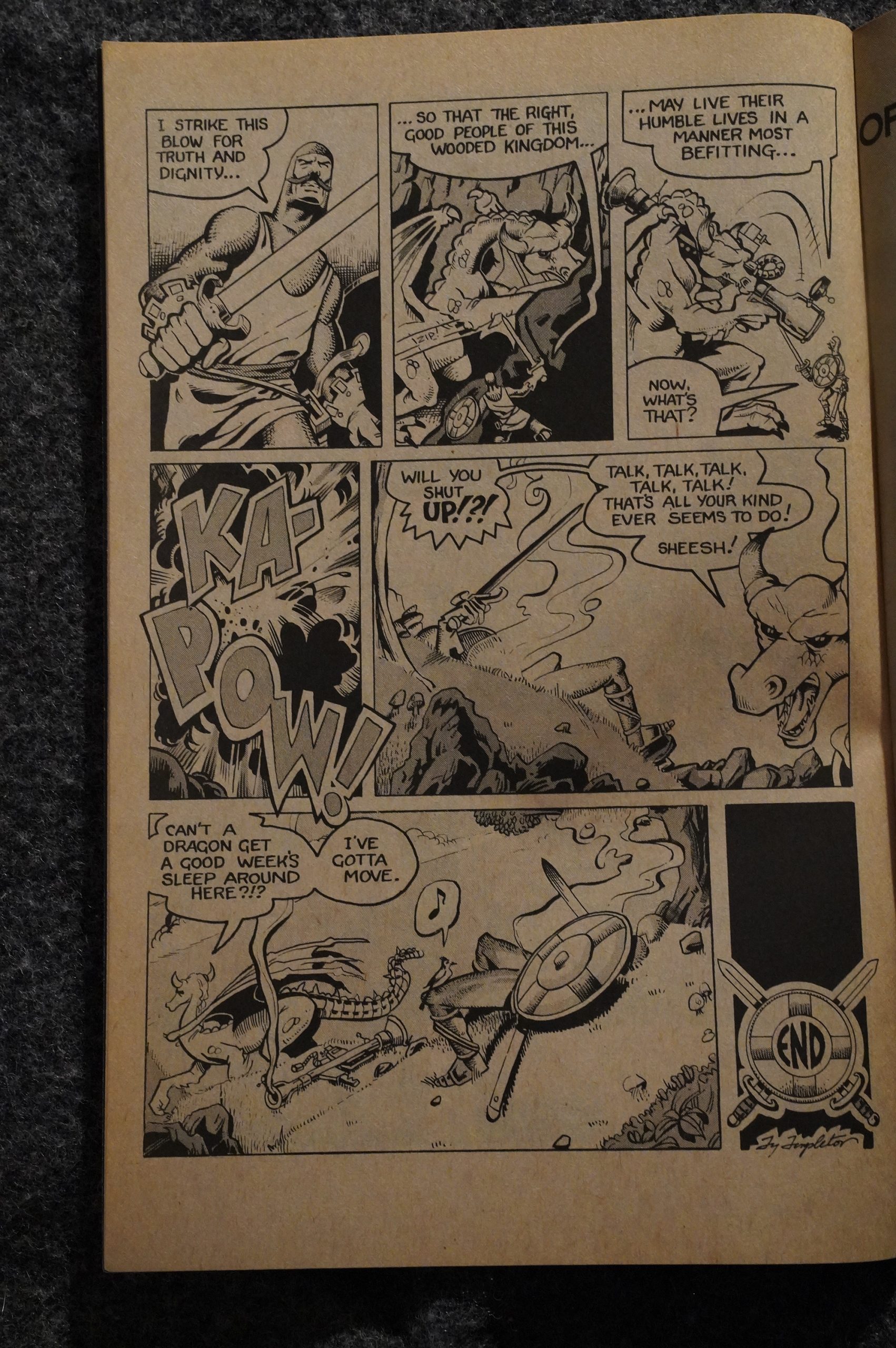
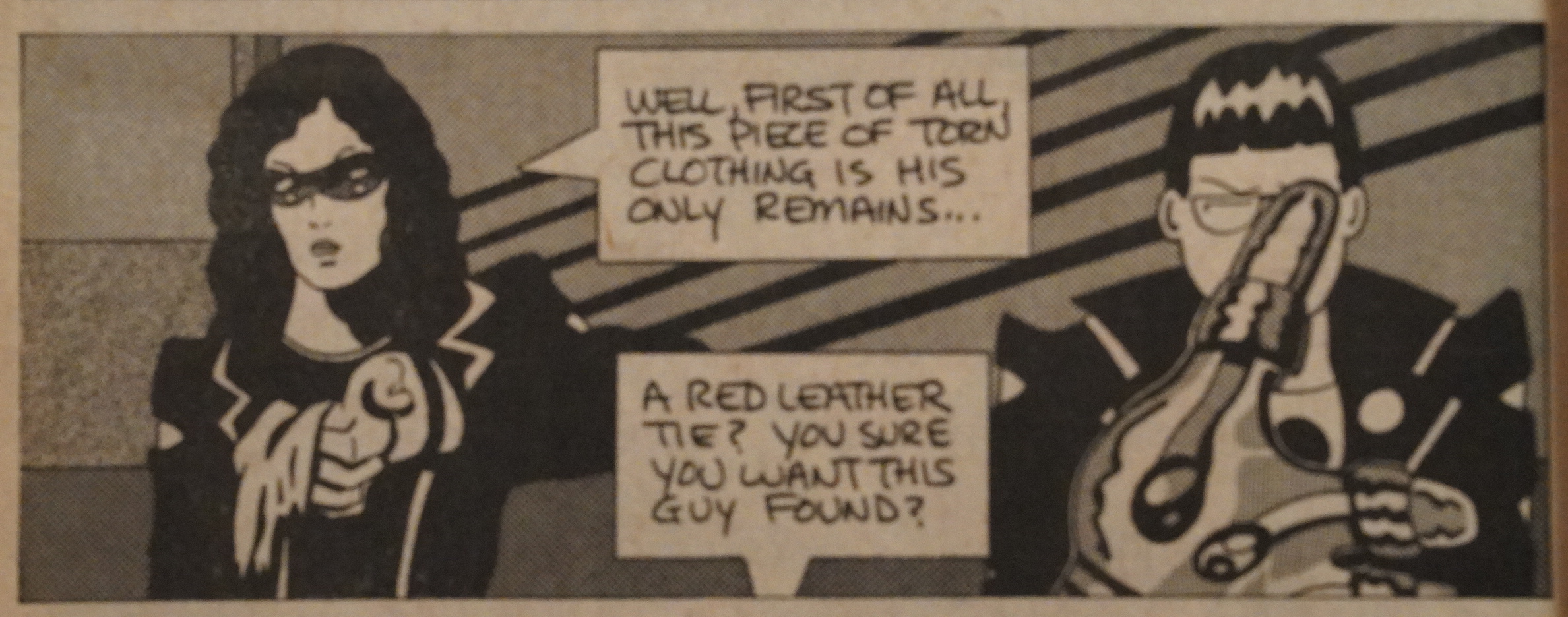
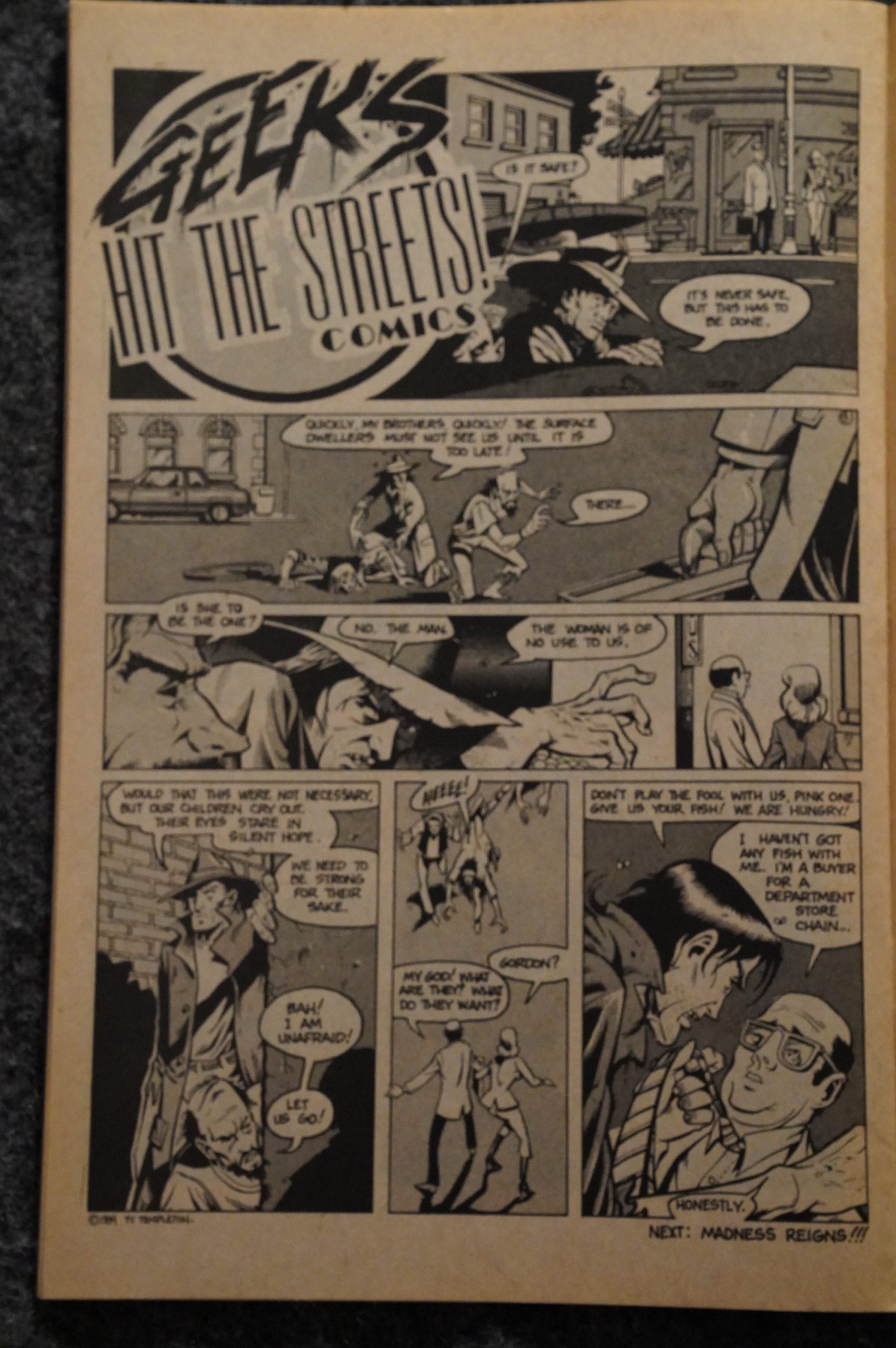
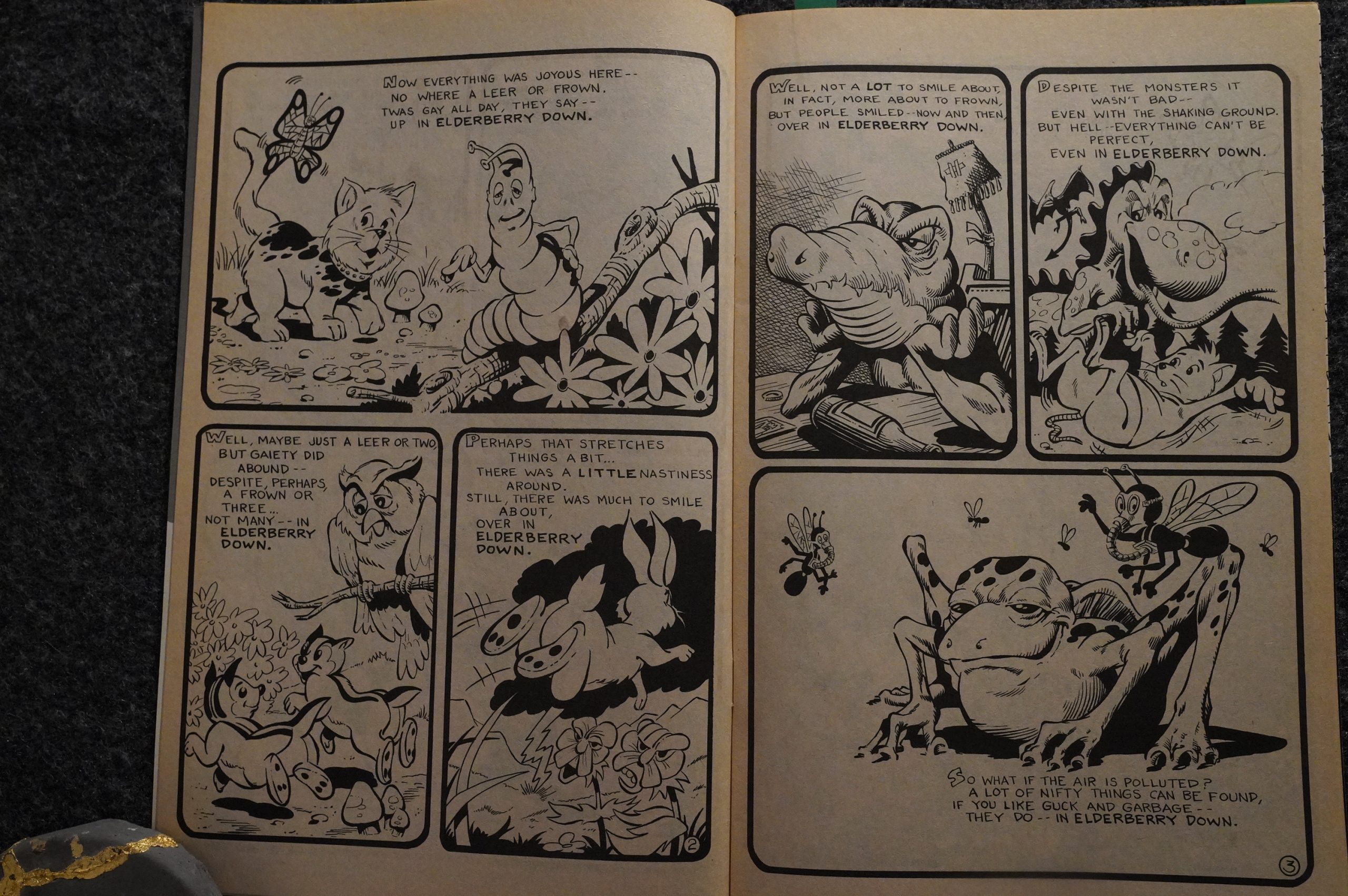
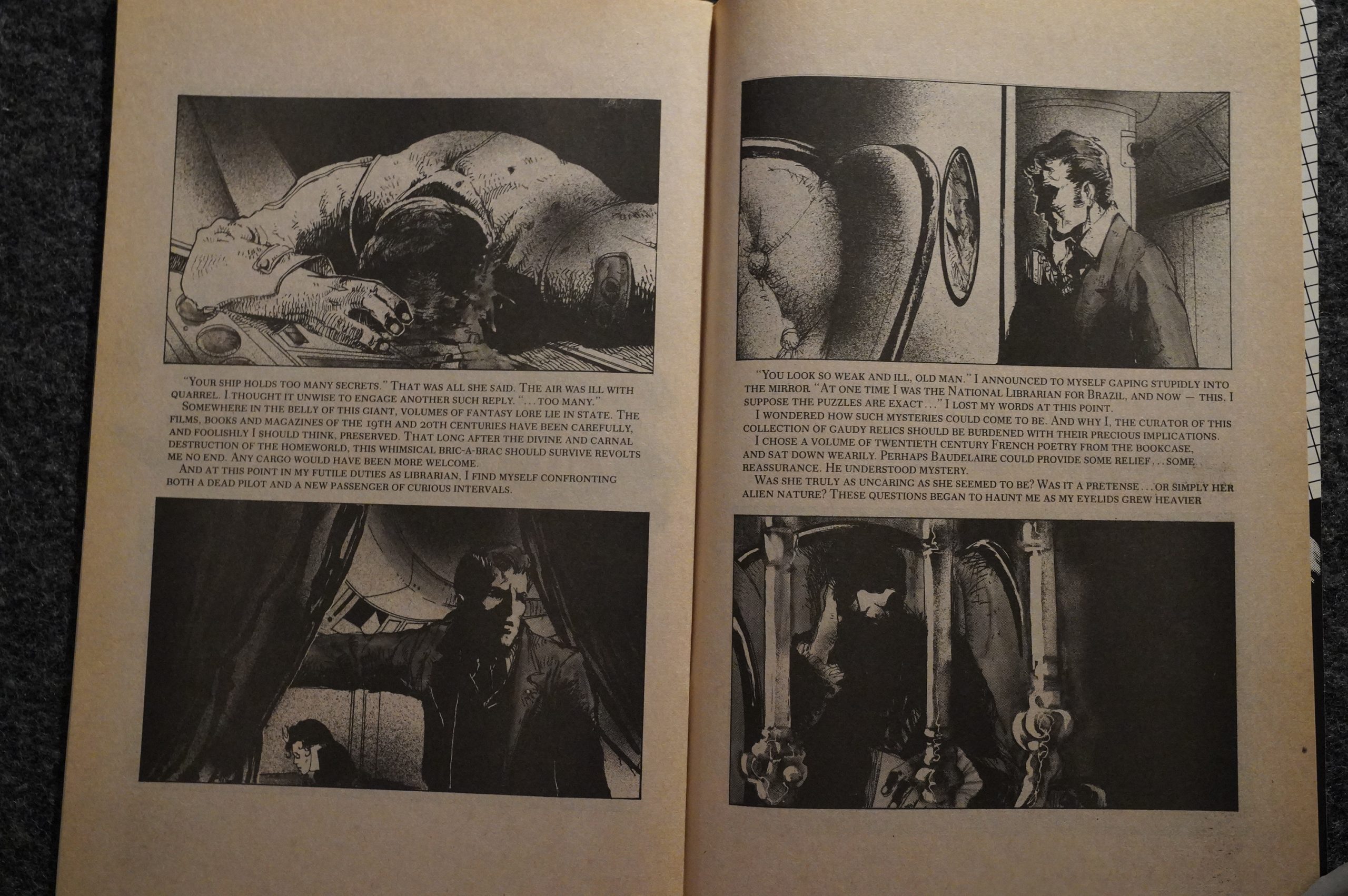
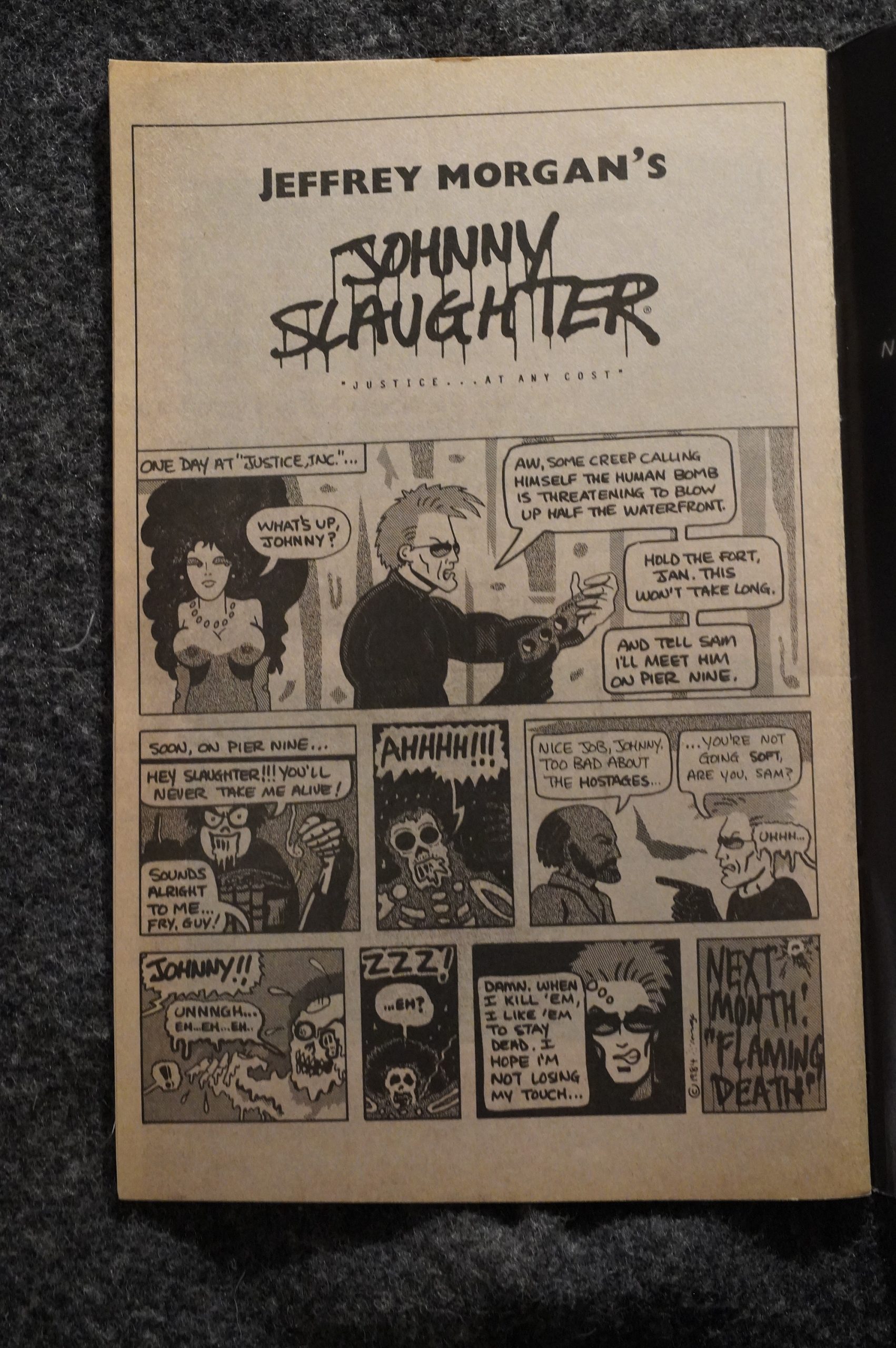
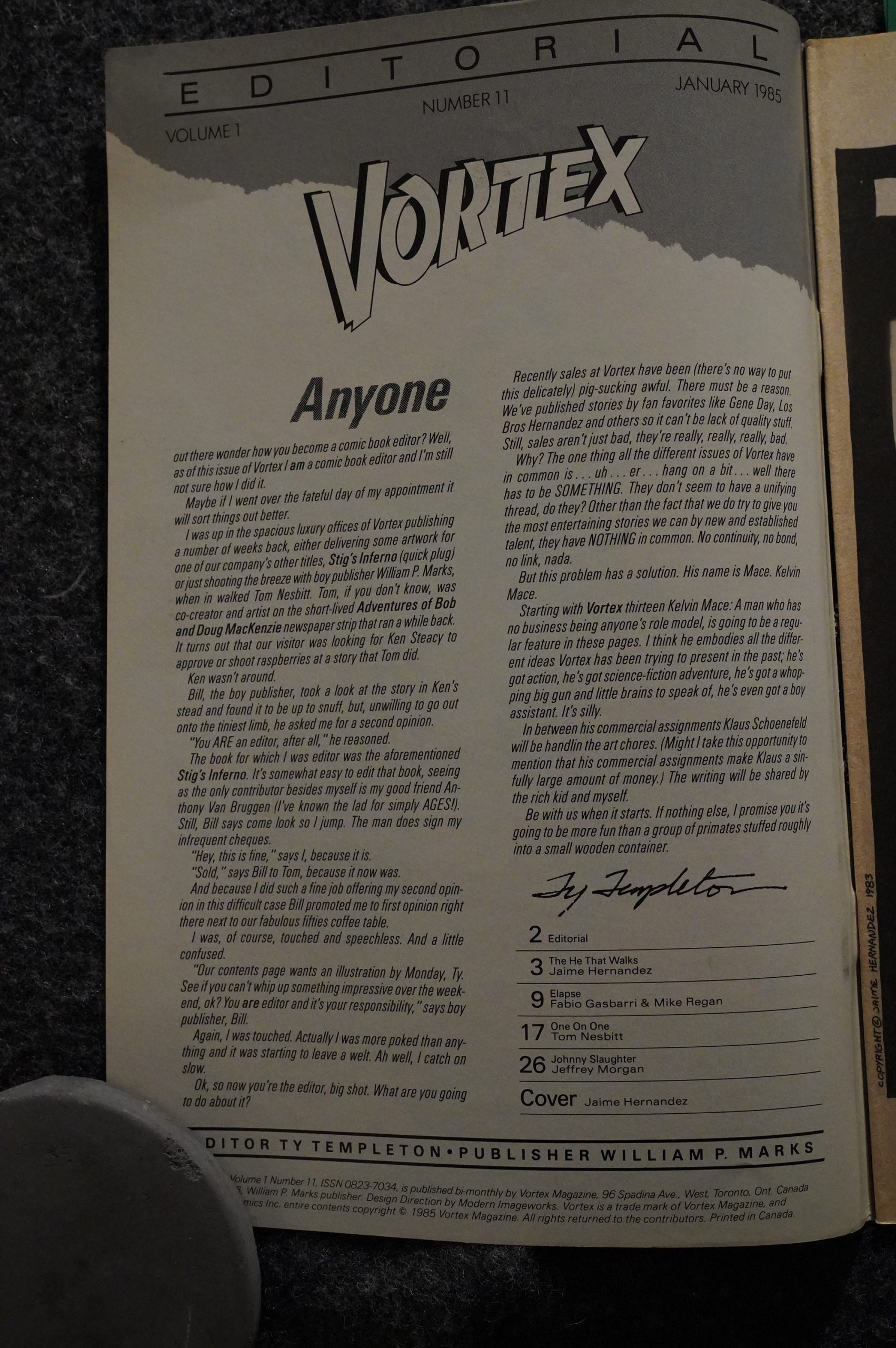

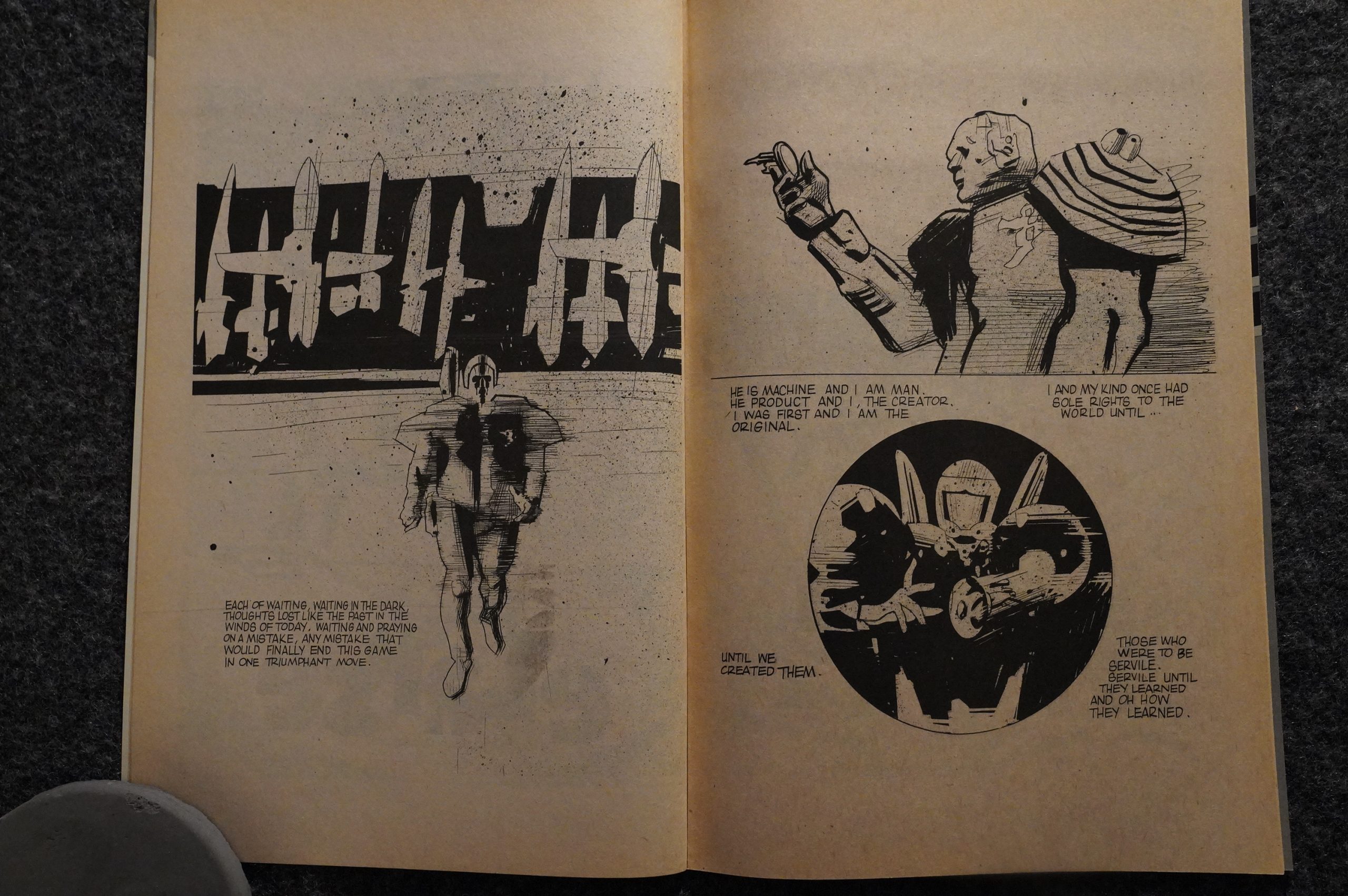
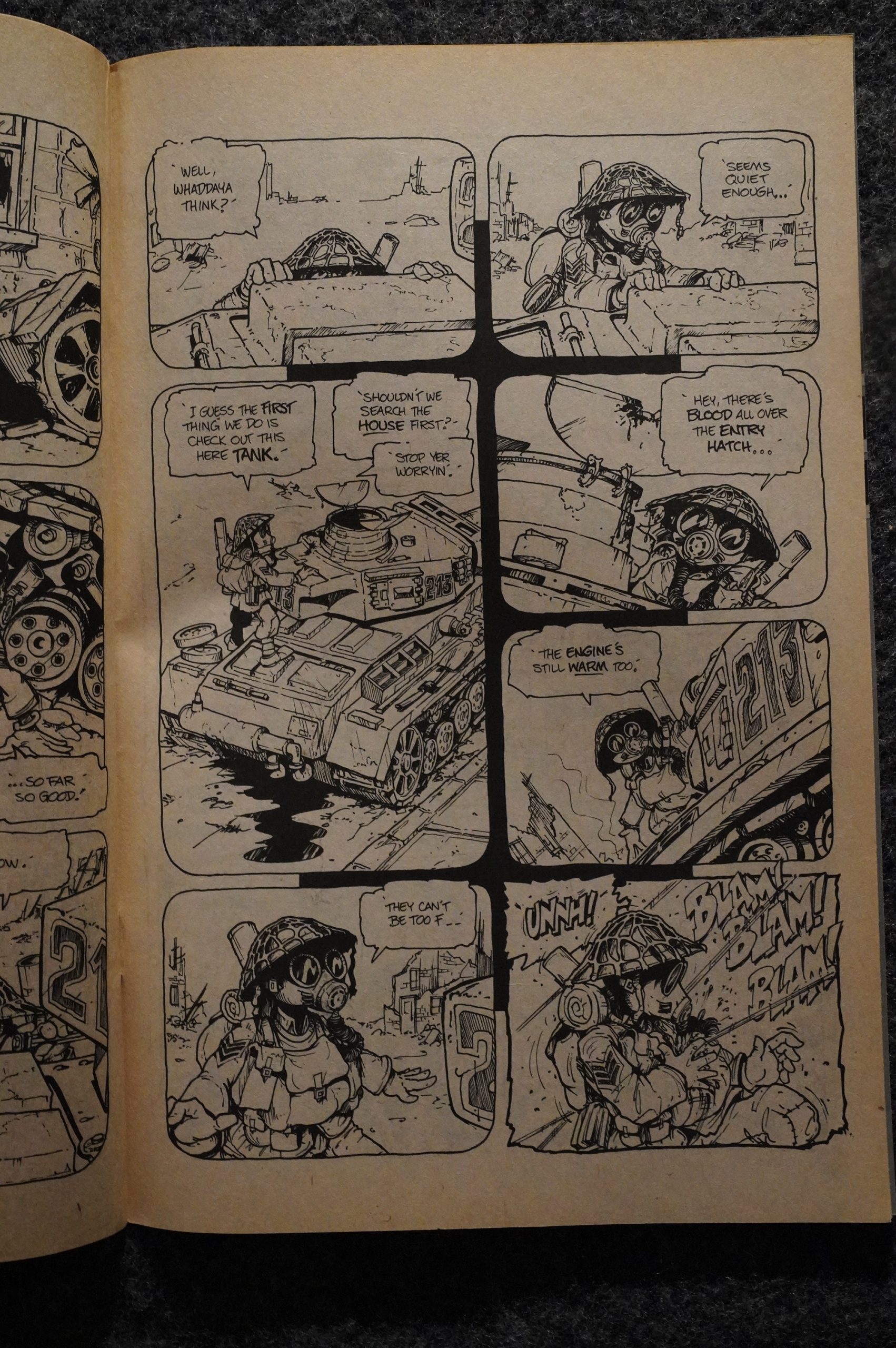
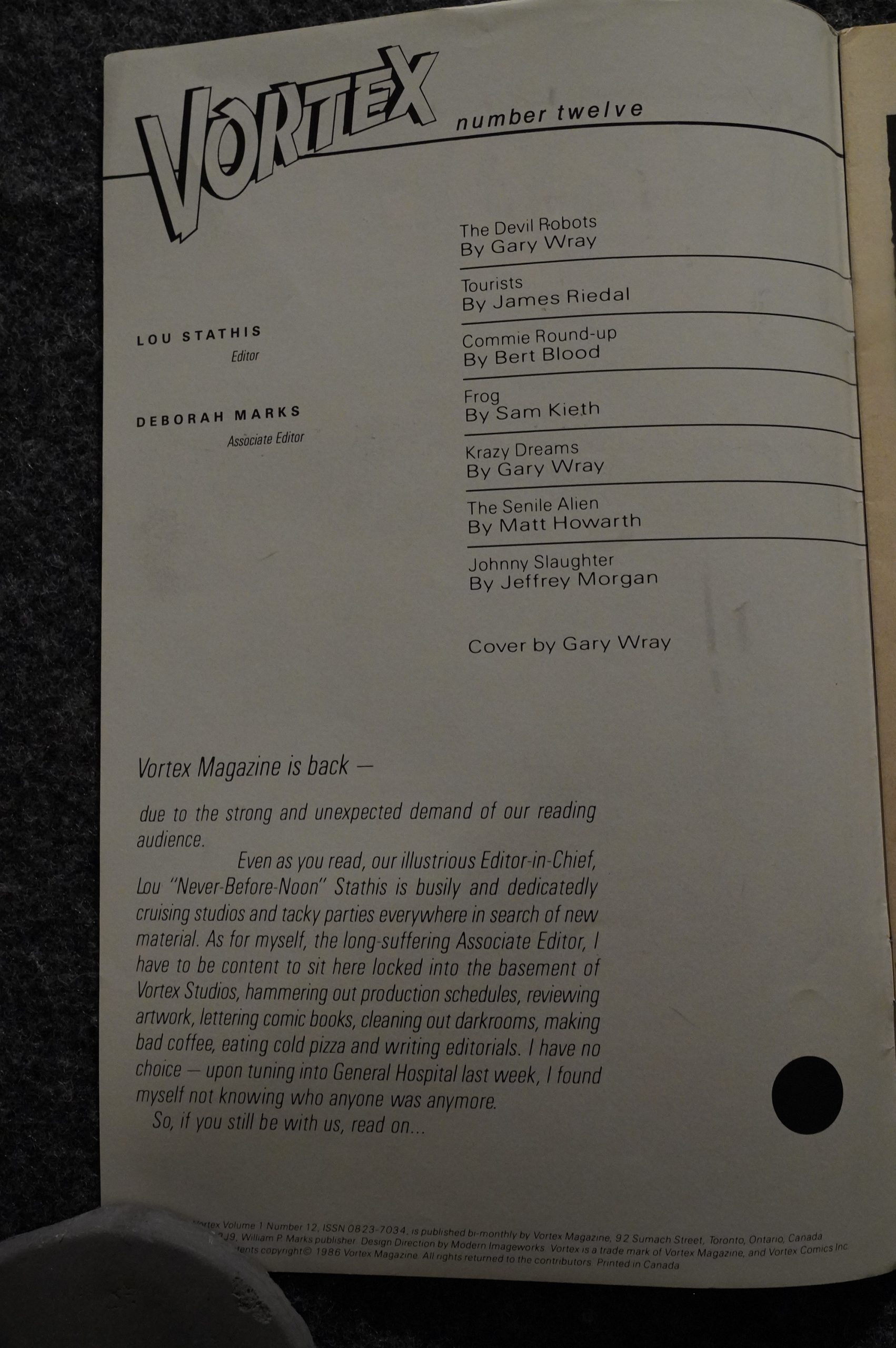
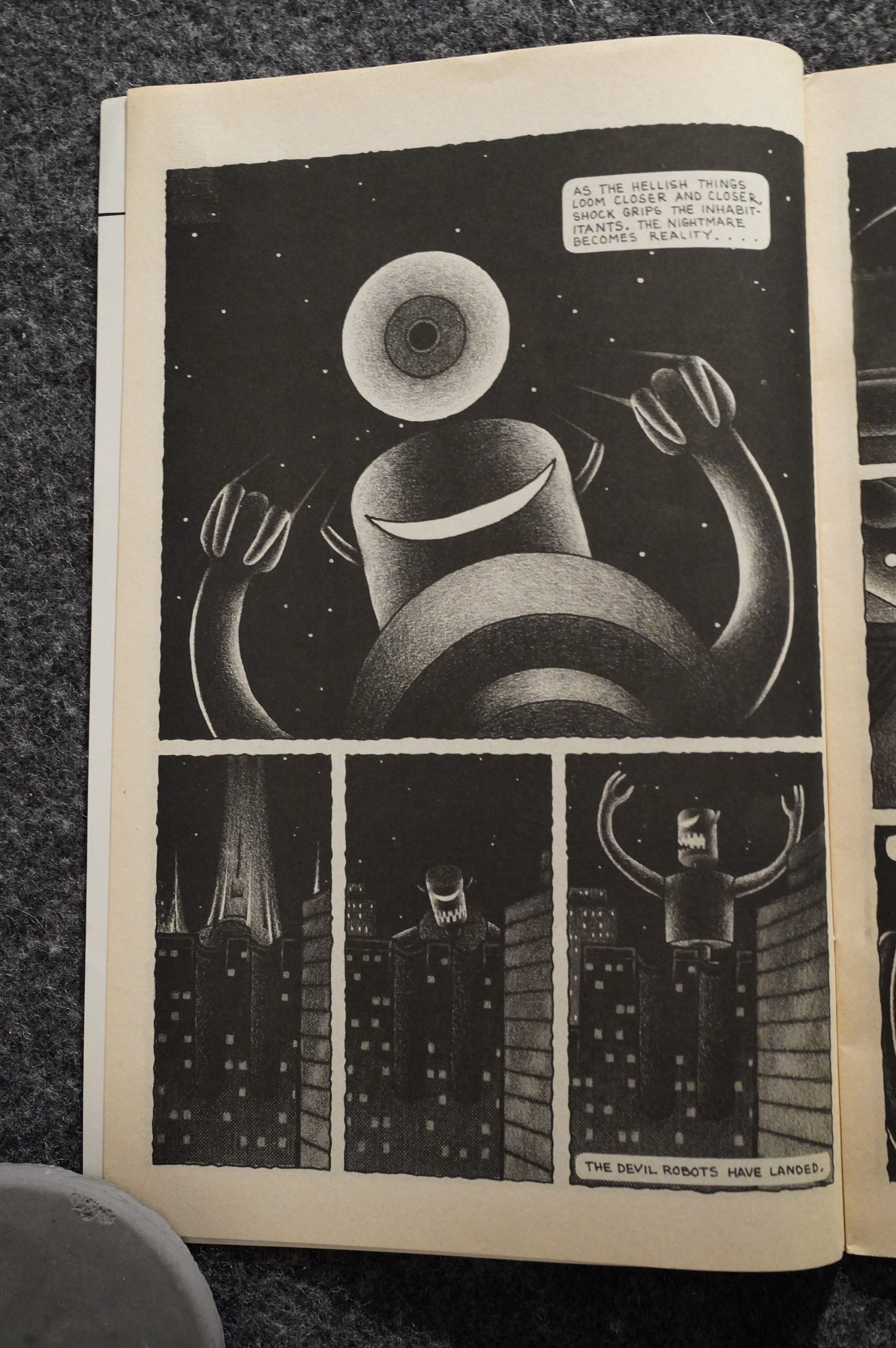
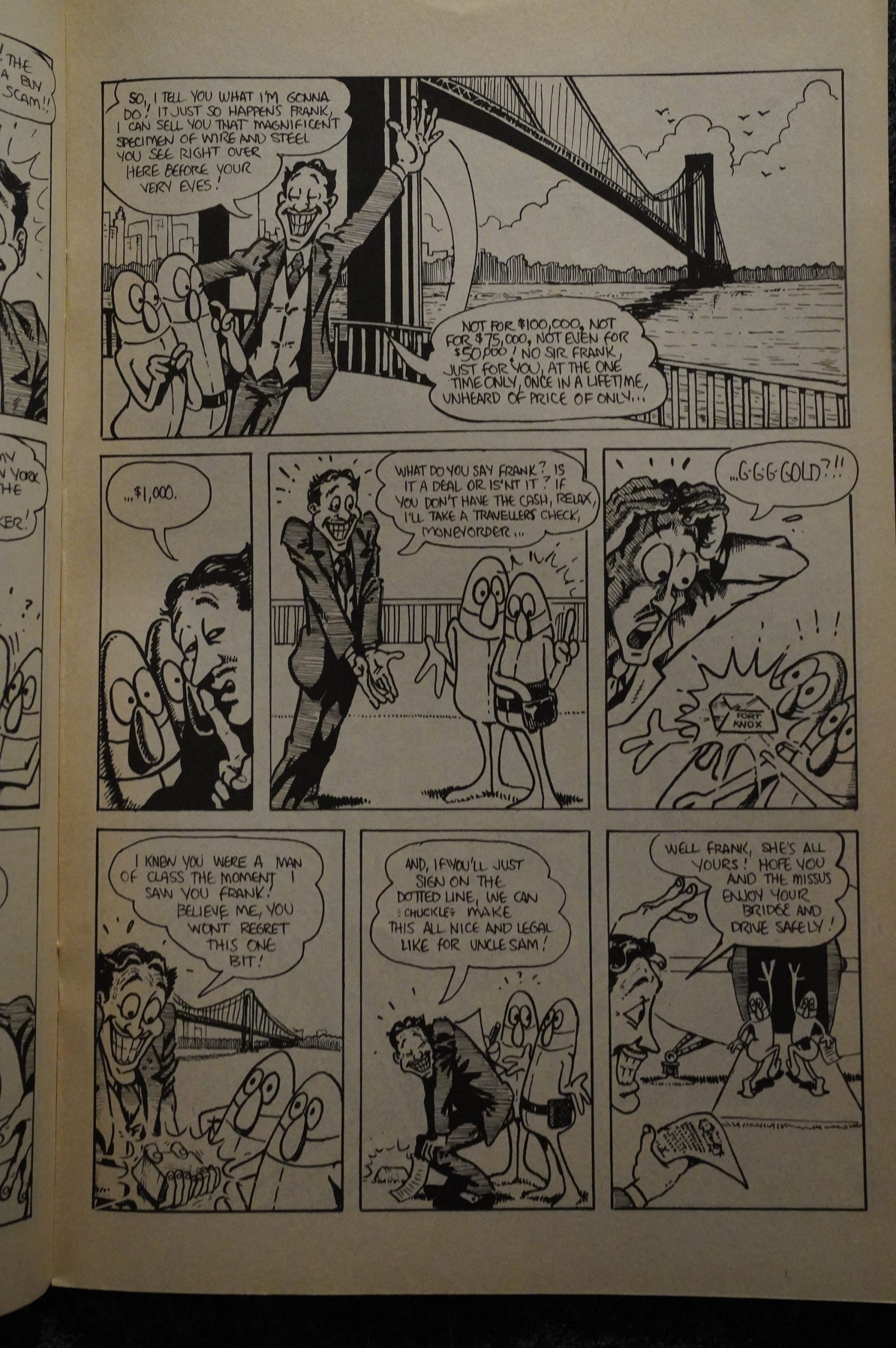
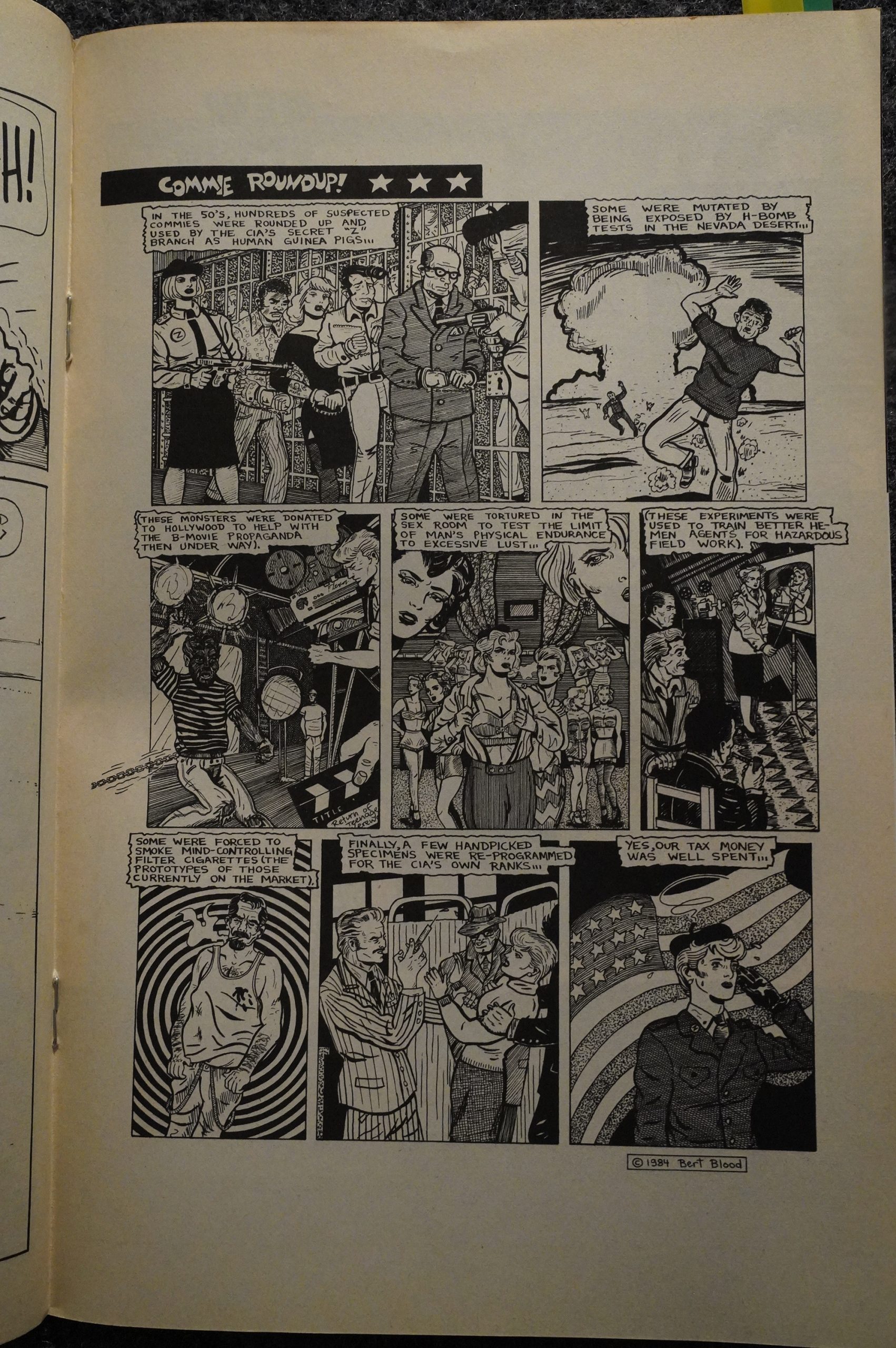
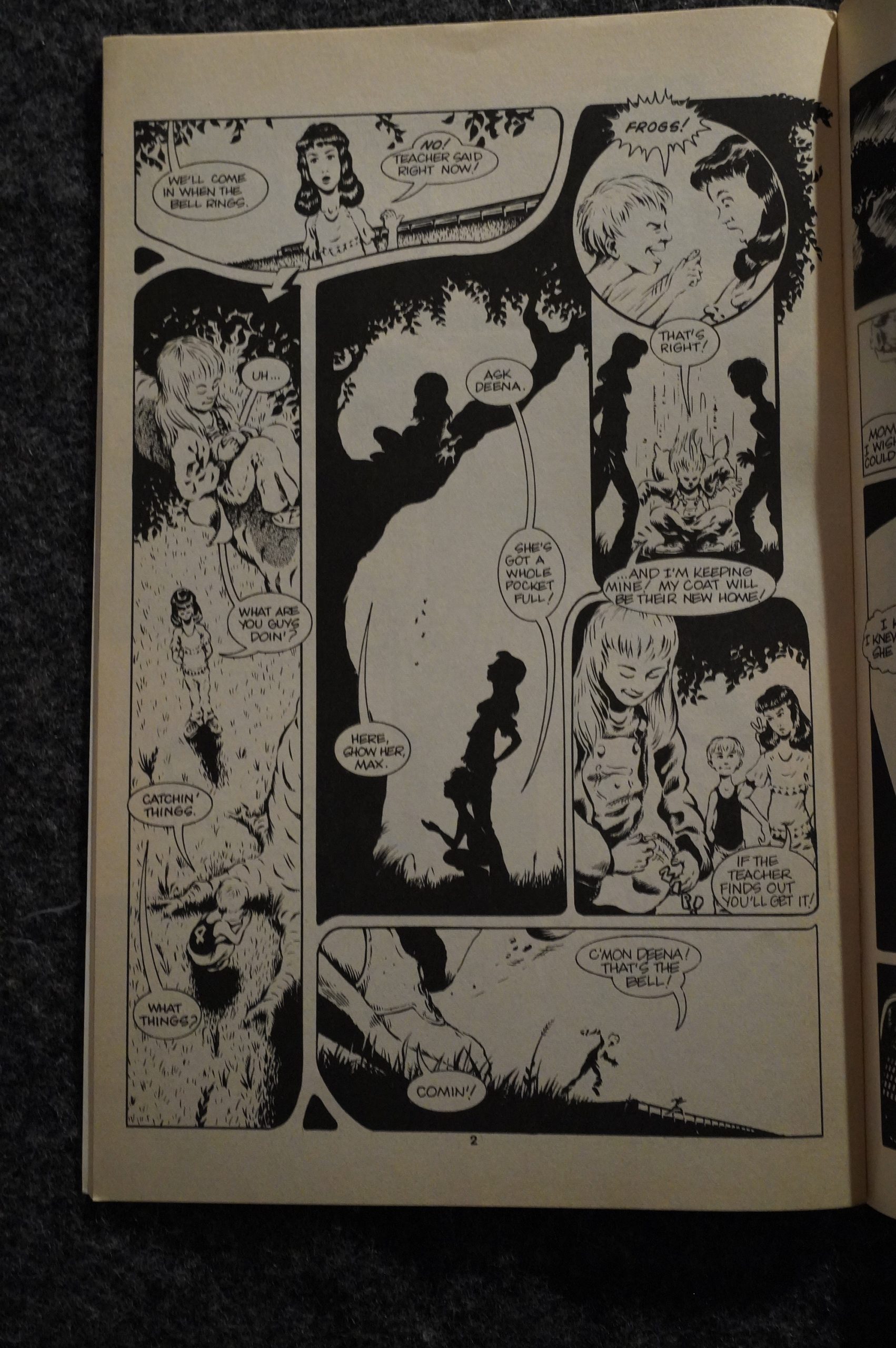
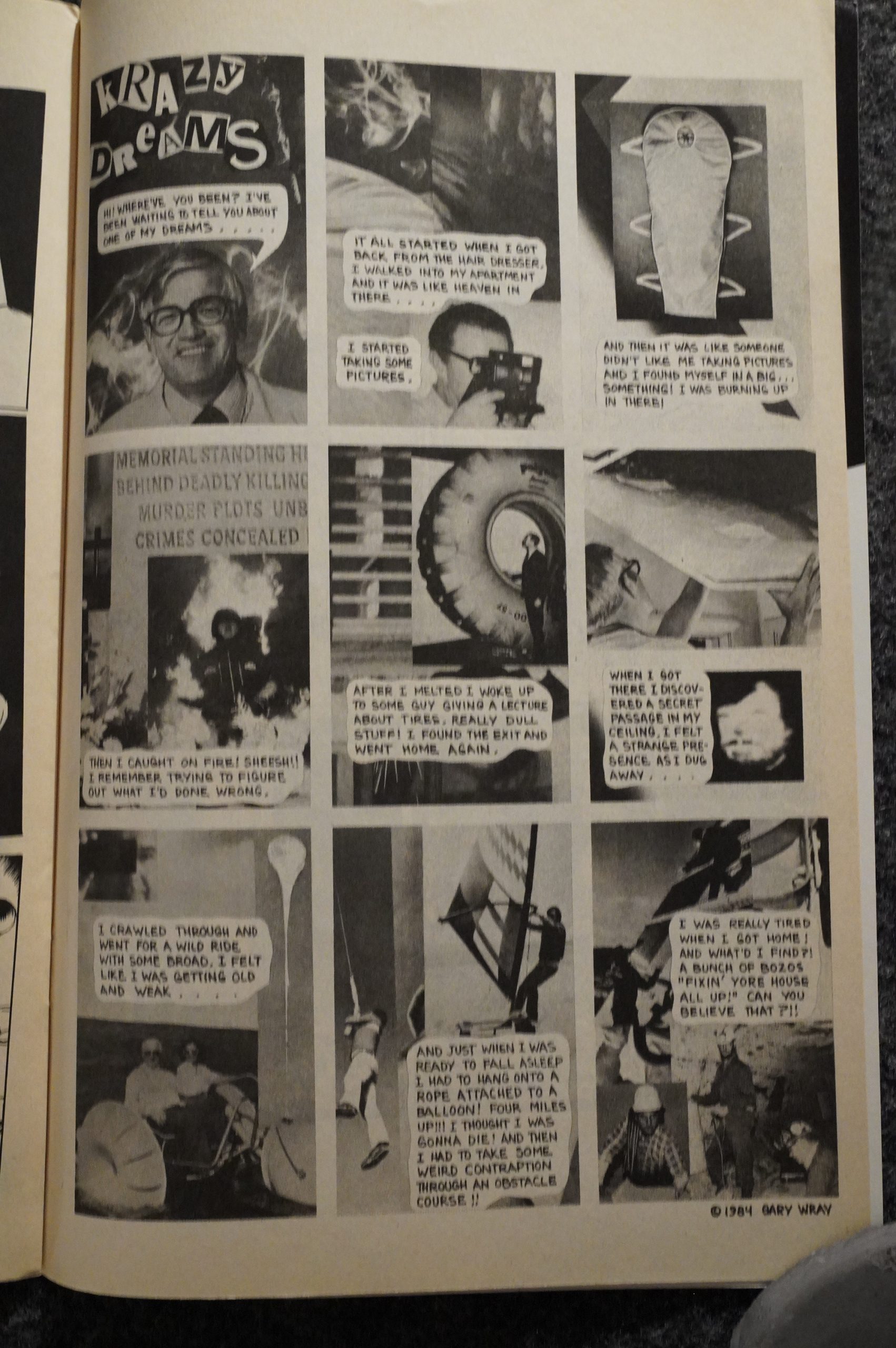

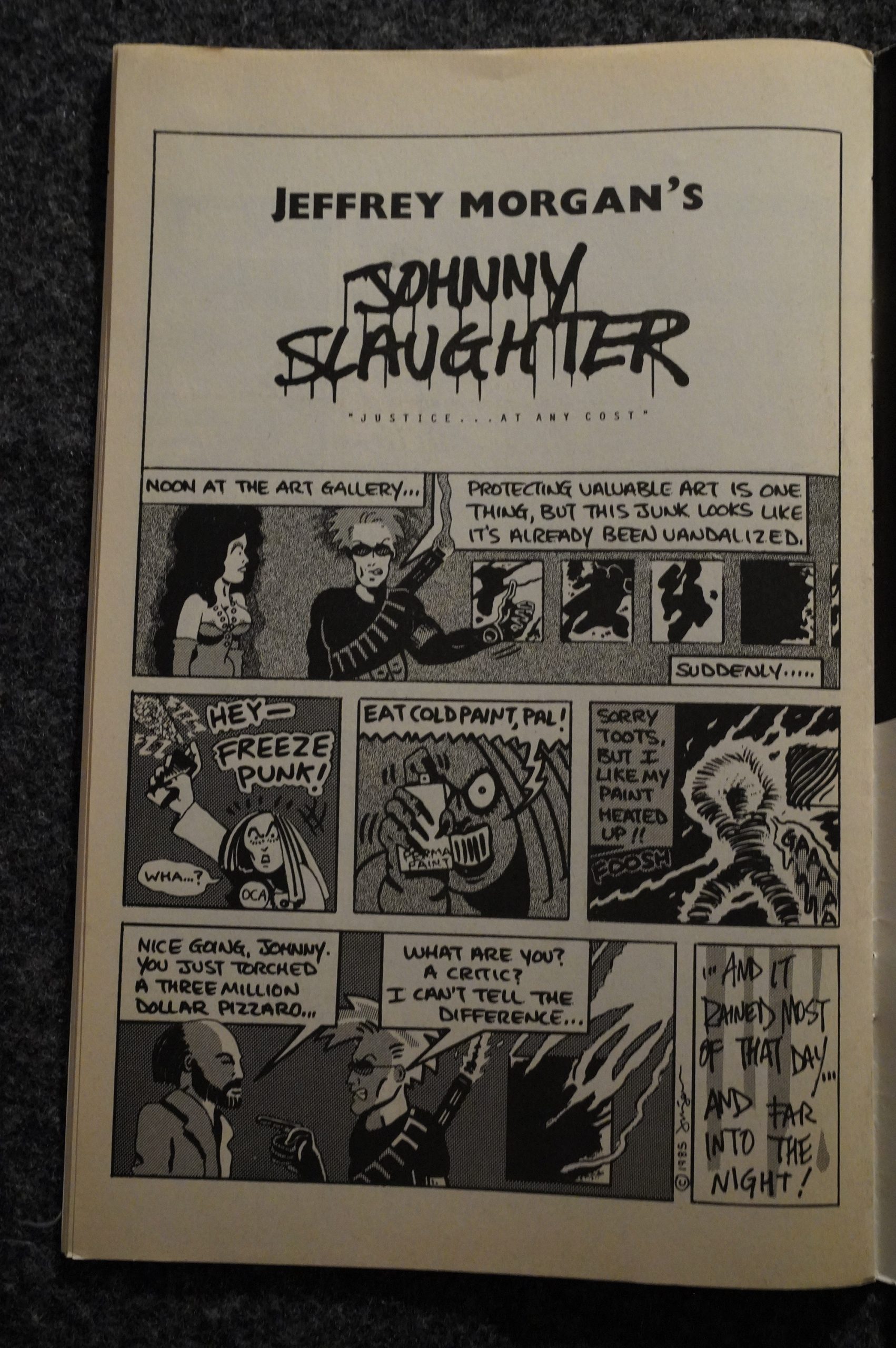
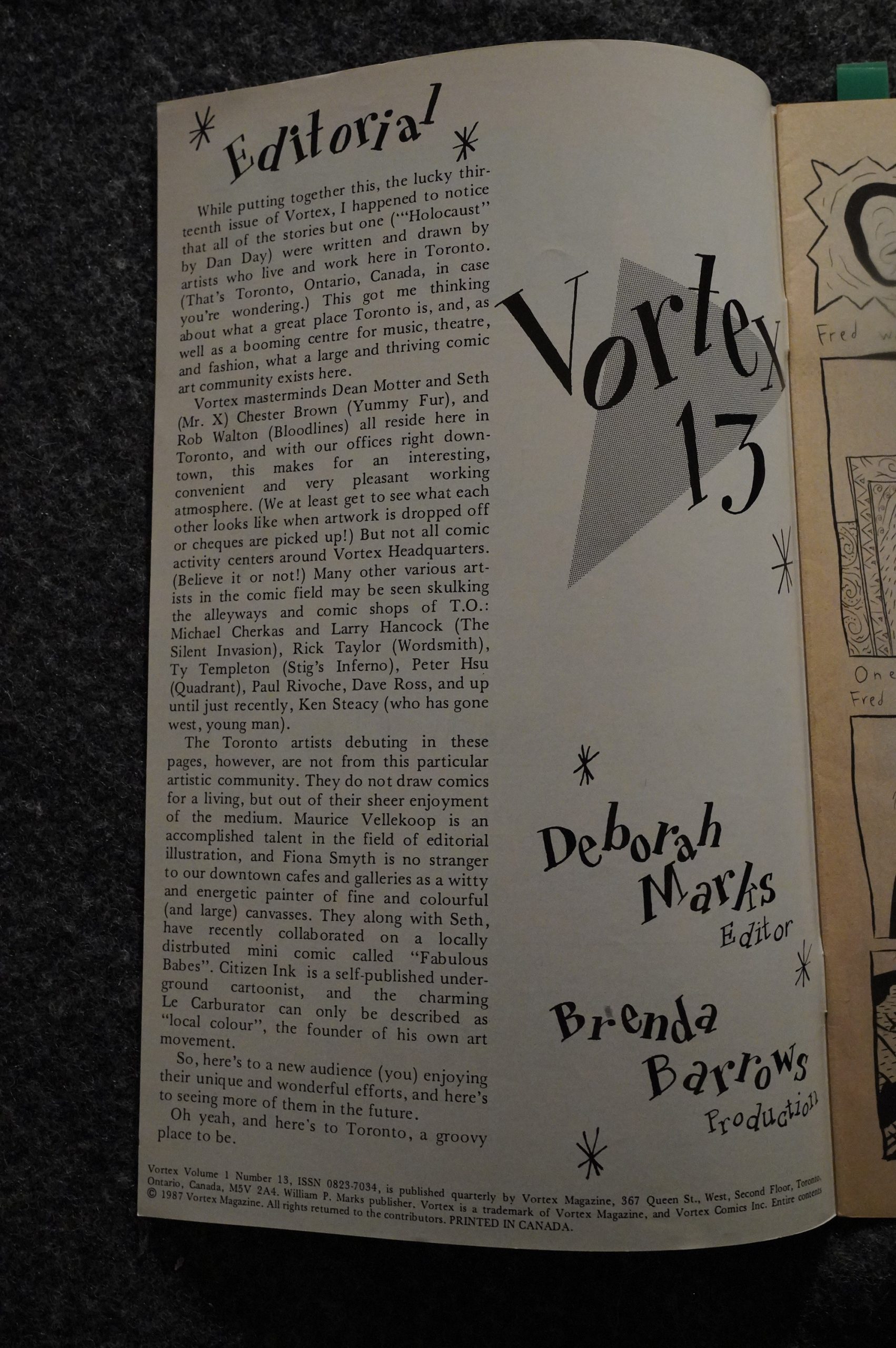
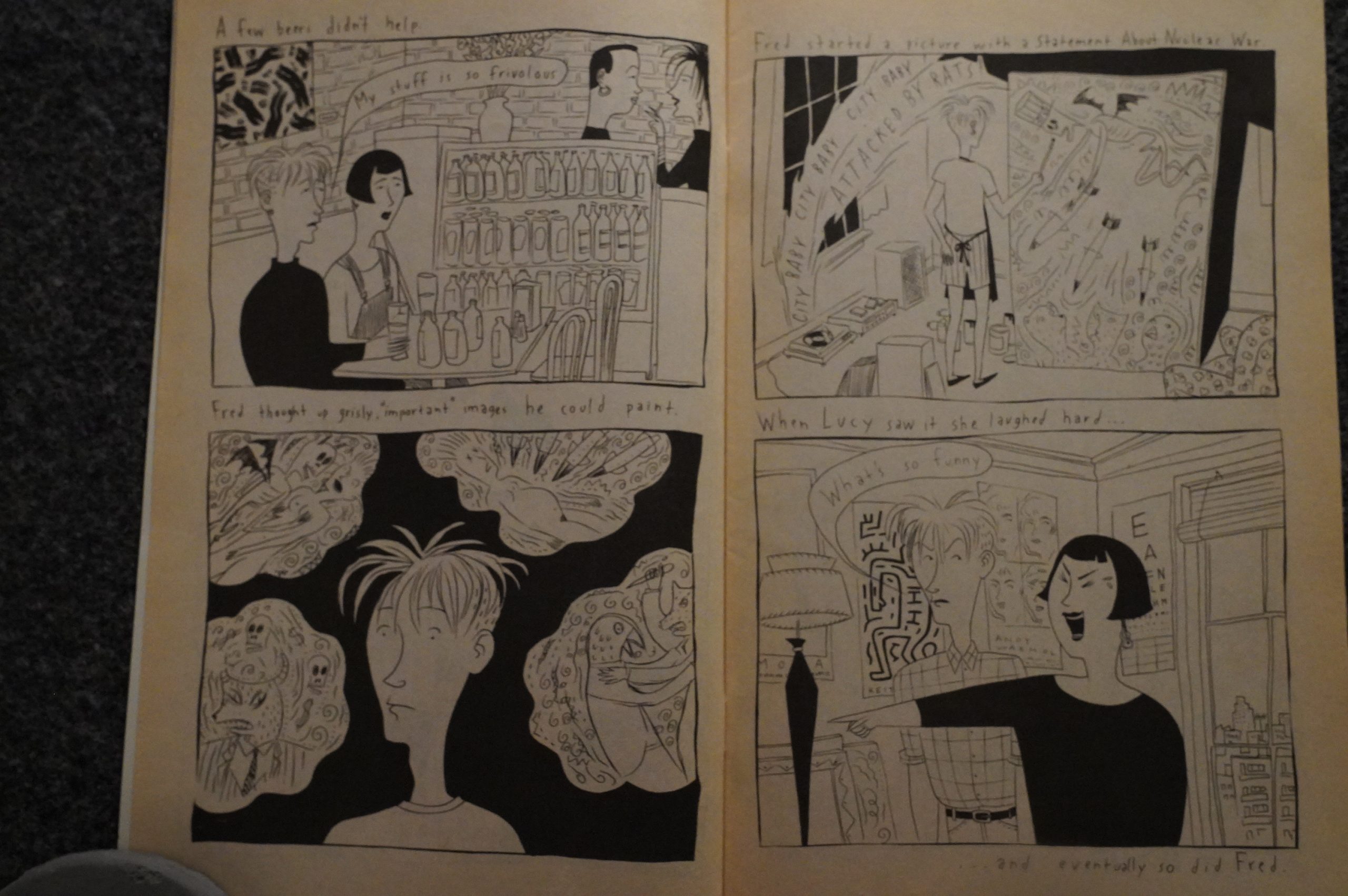
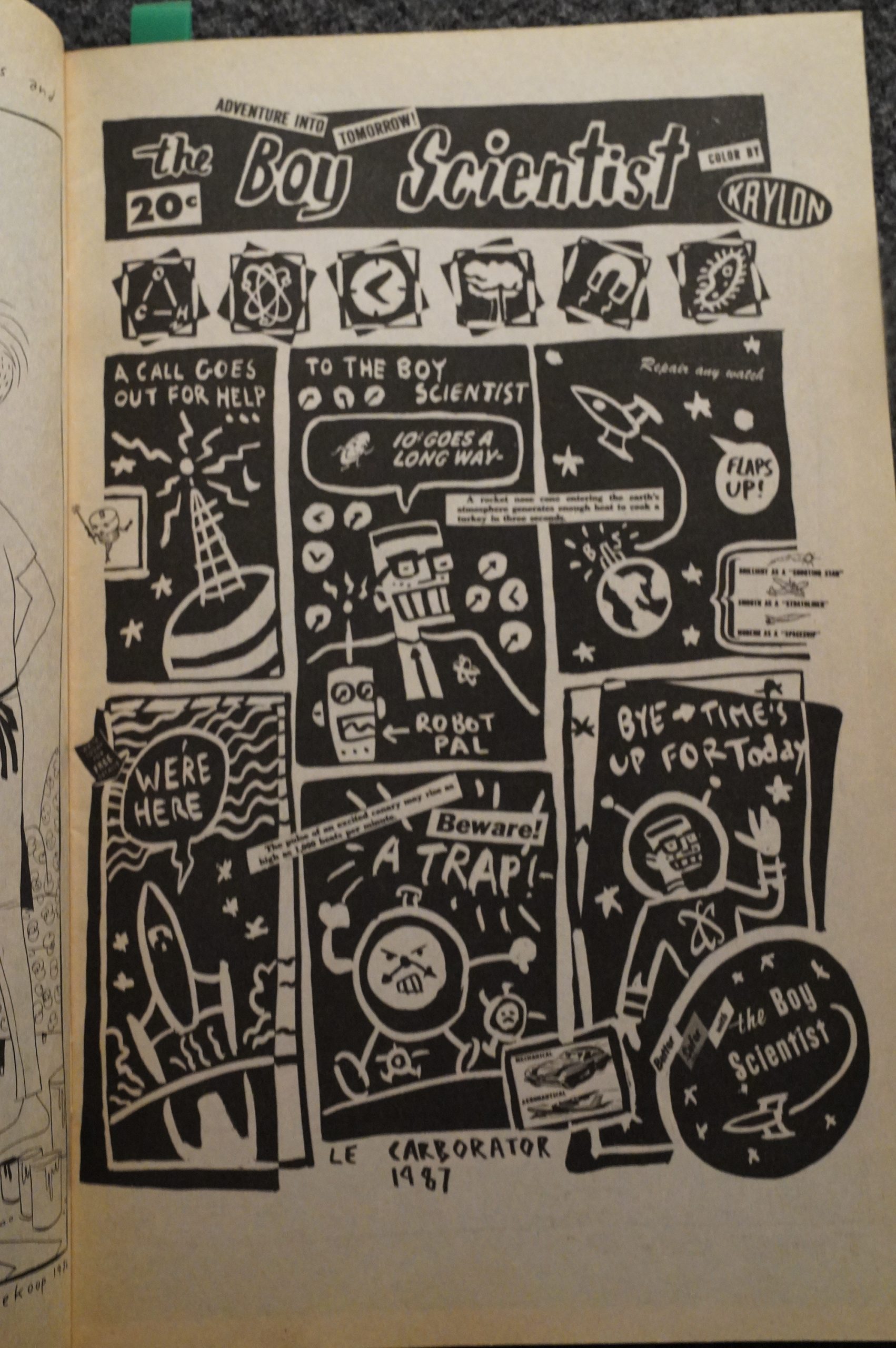
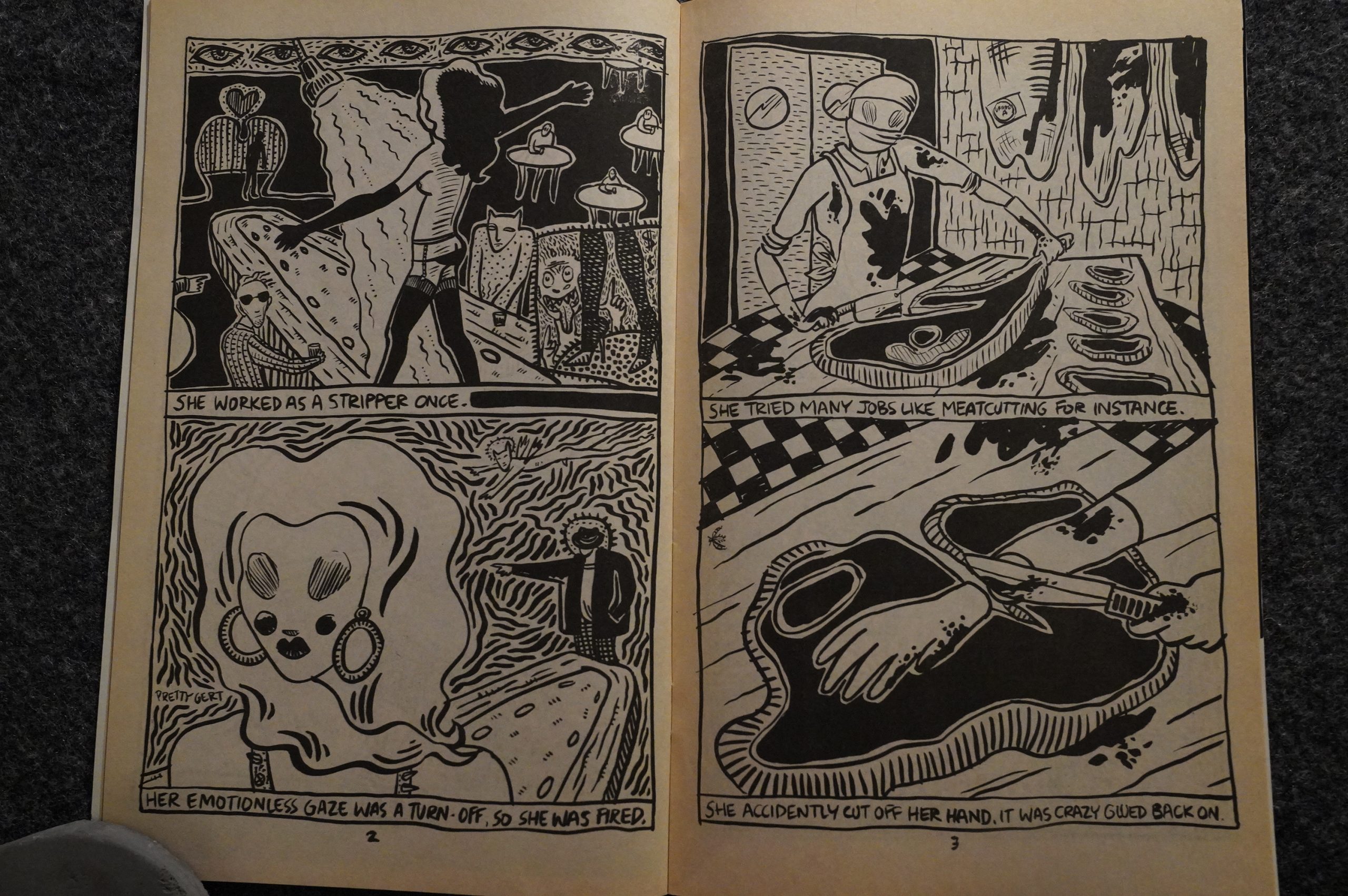
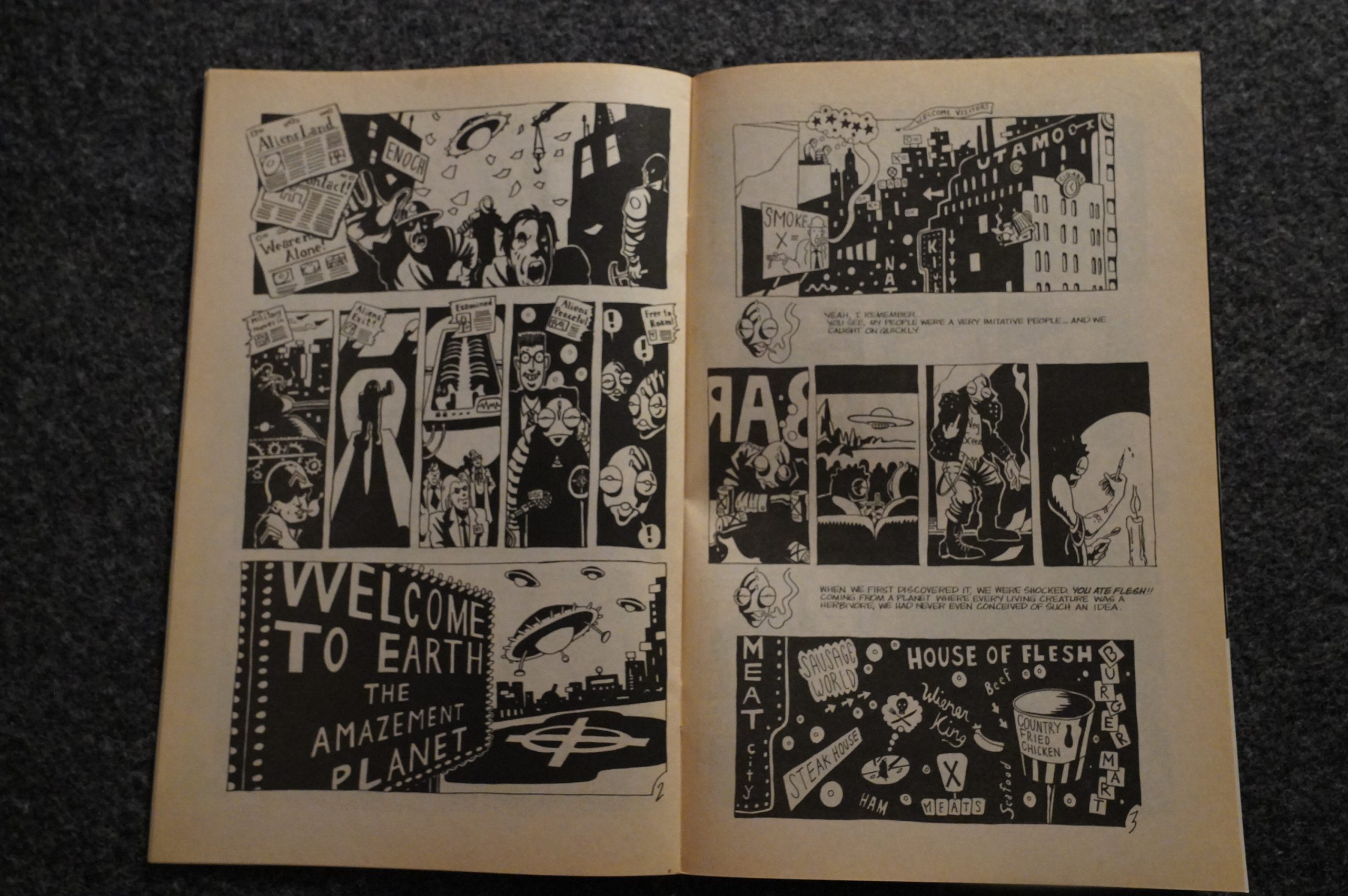
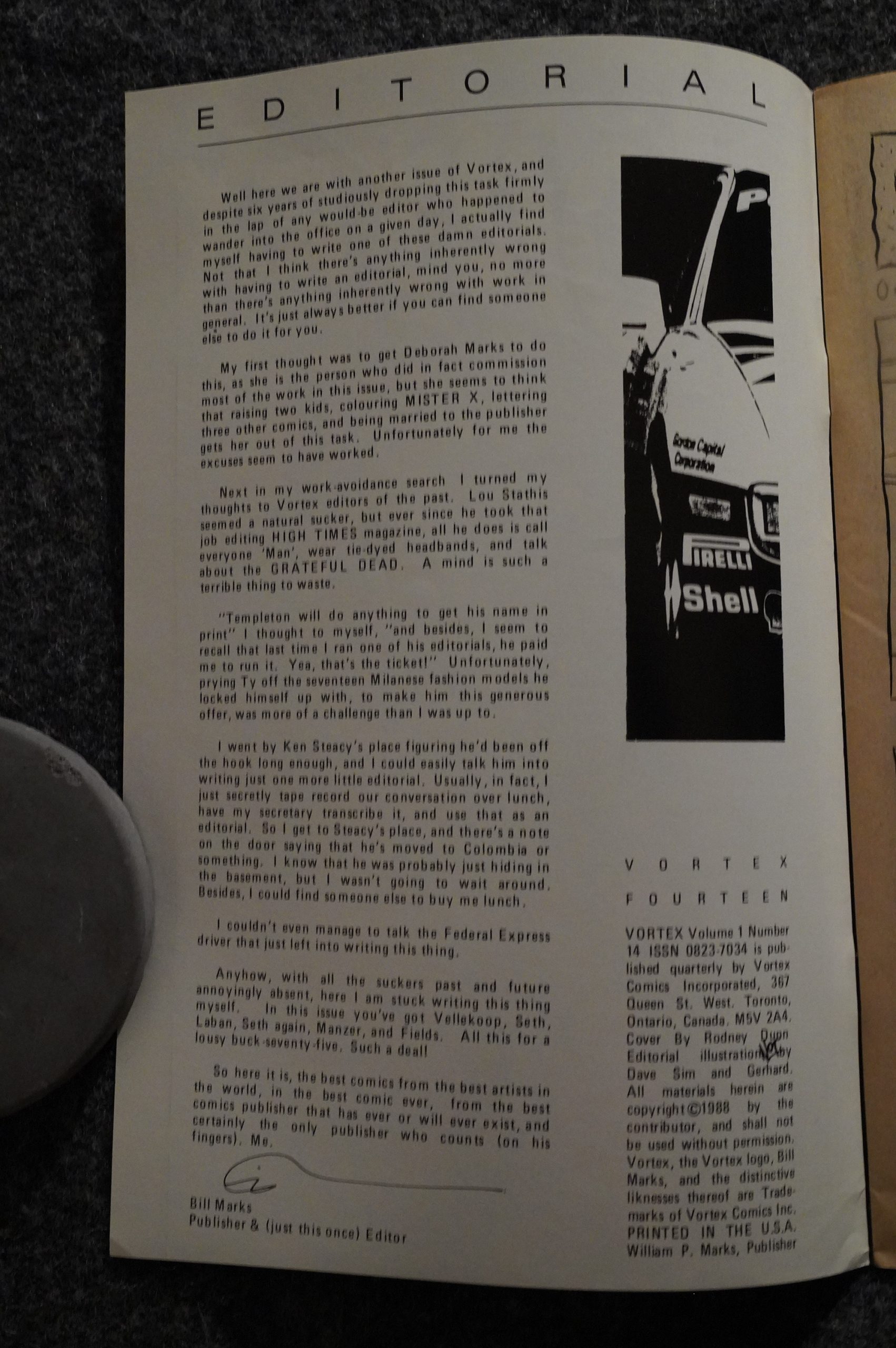
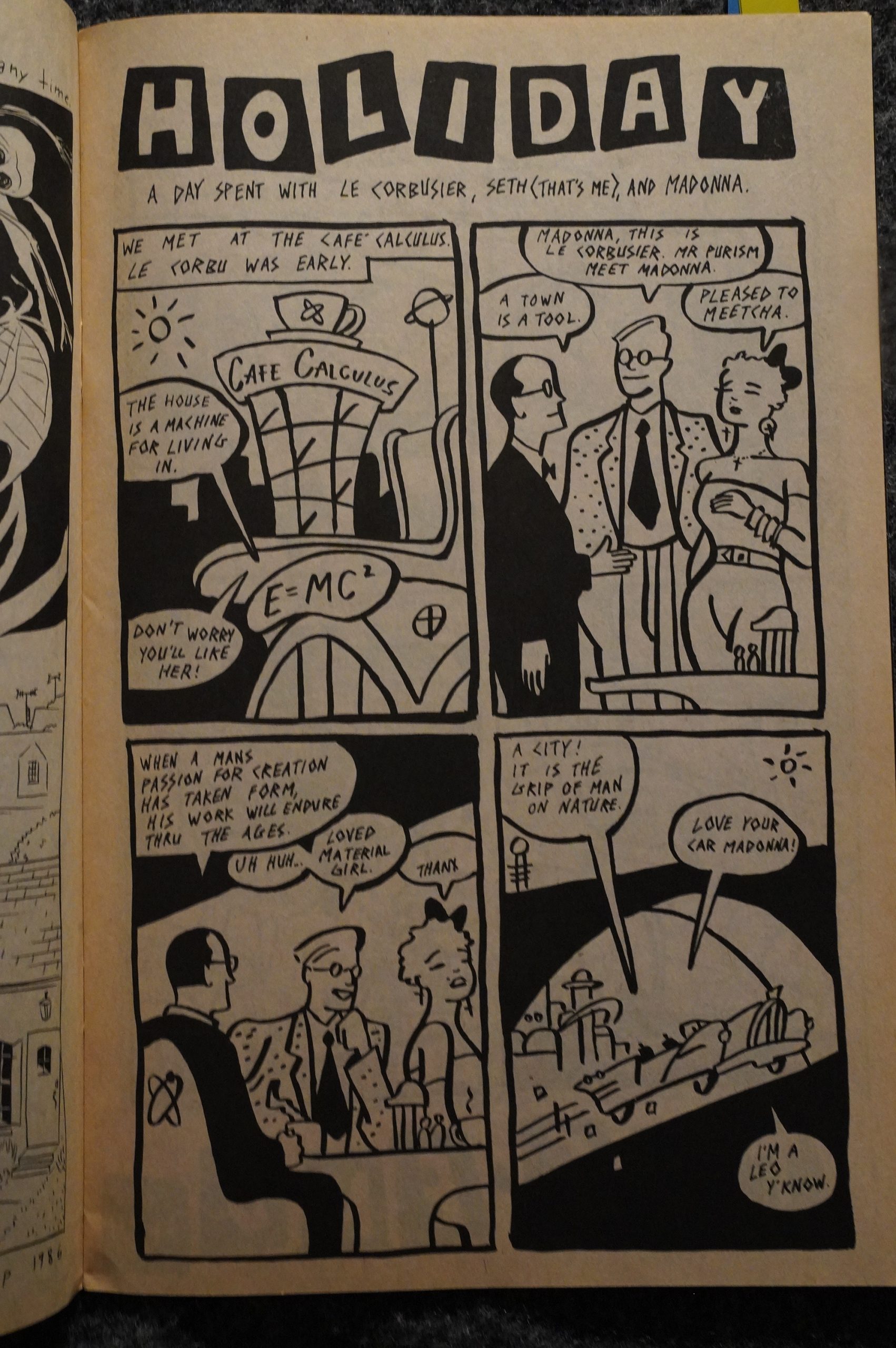
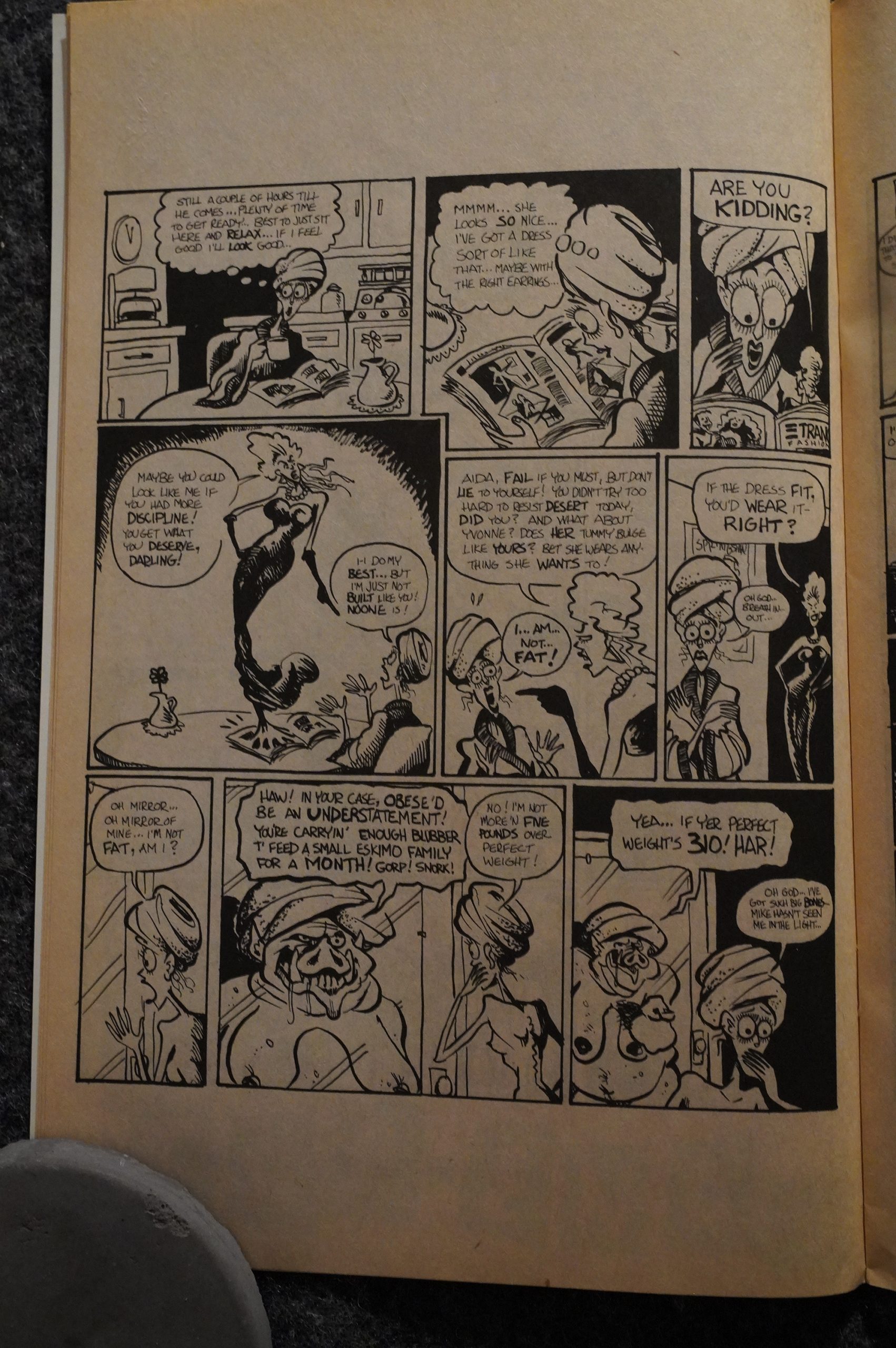
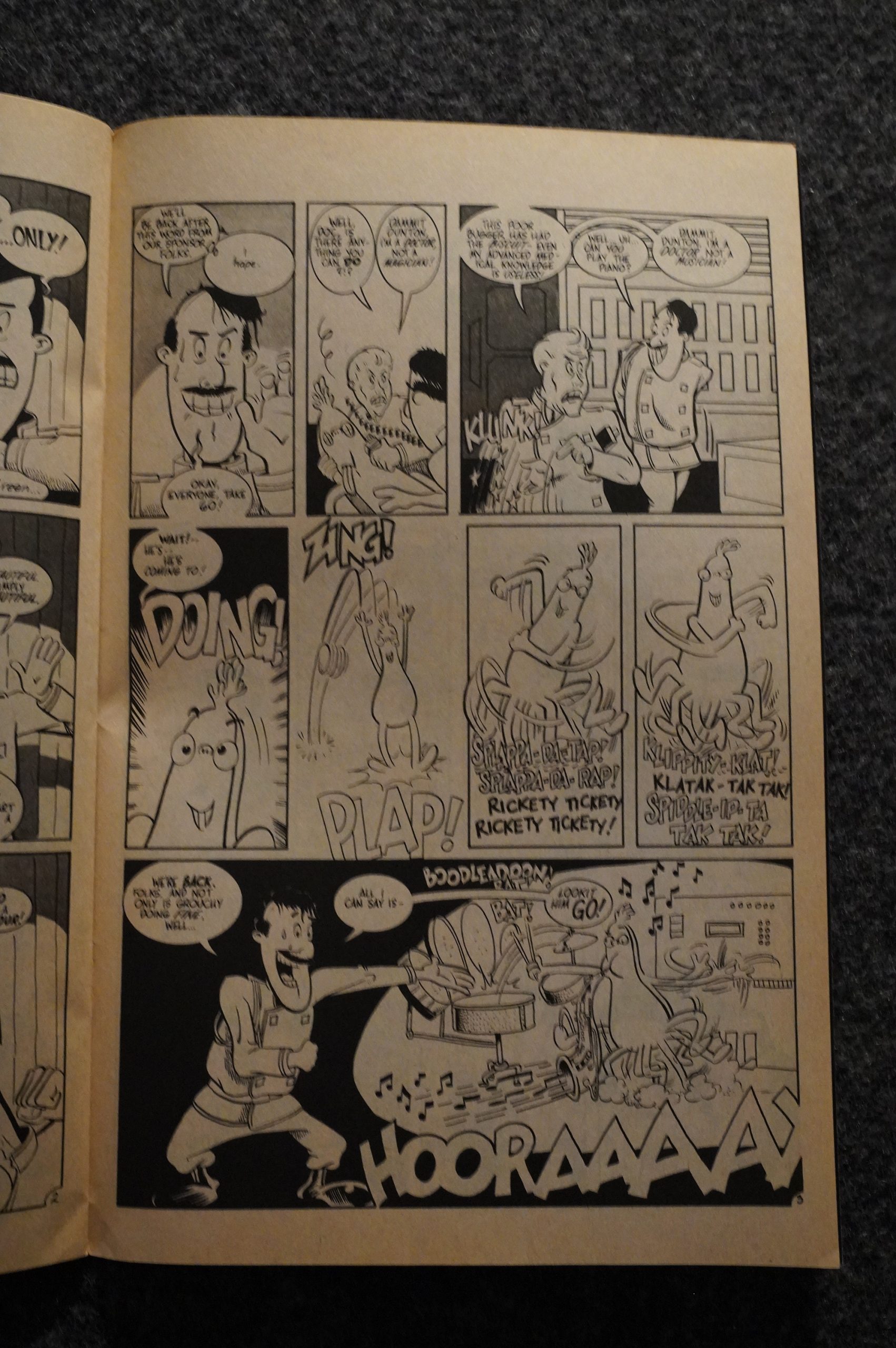
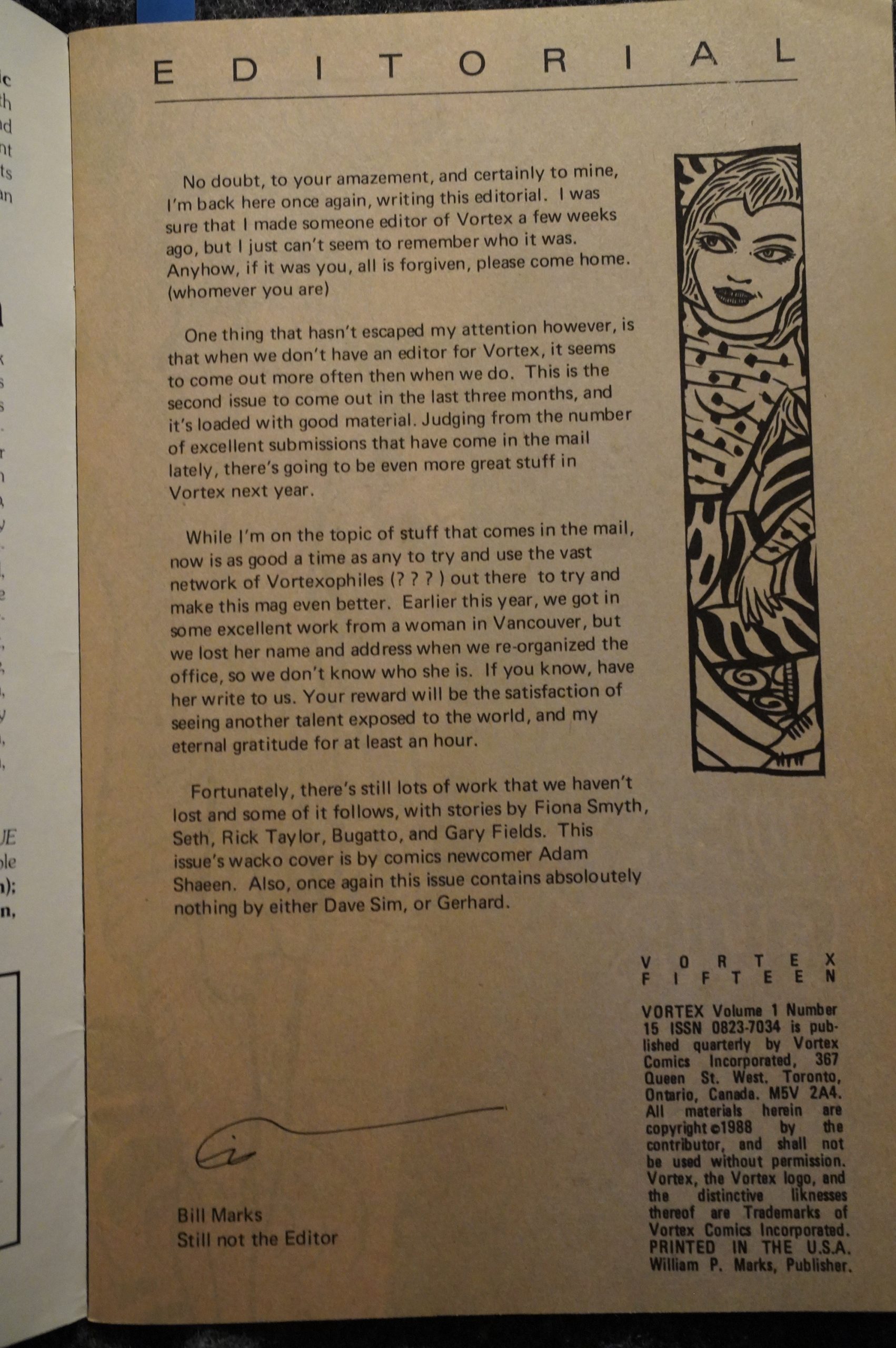


Second blog about Vortex and still not even a whisper about Chaykin! I’m intrigued.
Your images are superb, in fact so good that I assumed you were using a classy scanner, but you moaned about blurry photos at one point. How do you regularly get such sharp pix?
A Short History of Western Civilization is signed “S Gilbert” in final panel.
ps. I still find it confusing that your blurb is after the photo rather than before it, and I end up wondering whether I should be looking at the previous photo or the one coming next….
Maybe some dots or something would help? Even your SPOILERS! warning comes after the images, so maybe too late?
Love you, Lars, so here’s a Big Black Kiss.
The camera has pretty good auto focus, but I really should set up some more lighting… but that’s such a hassle.
And the text is now next to the images instead of after it, so I don’t get the confusion.
Ah, yes, text alongside is excellent! Just discovered that works only on widescreen online pages, whereas I have been reading on my email page and only switching to web for enlarged images. I’m learning.
Hi Lars, On your Mister X blog you asked for examples, so here are a few from this blog:
[an] back page ad from Seagate [= a]
[it’s] doesn’t really draw in readers, [= it]
pretty standard sci-fi [juvenalia.] [= juvenilia.]
but [otn] really rendered [= not]
Machine Rock? I don’t know who [ ] refers to. [= that]
<>
the other half [was is] surprising [= was/is]
guess [what] it’s going to be based on the page above. [= that]
Nitpicking maybe, but your blogs are so near perfect that it is a shame to let these slide…. Think of the children who will read these in 2525!
Typical! I should start reading my blog articles, but nobody has time for that.
ps. That mysterious was my attempt to include this:
It’s uncredited… [= signed S.GILBERT final panel]
Oops. Somehow I cannot include those brackets (like: less than / greater than math signs) in my comment, which accounts for the oddness of the foregoing…. Apologies.